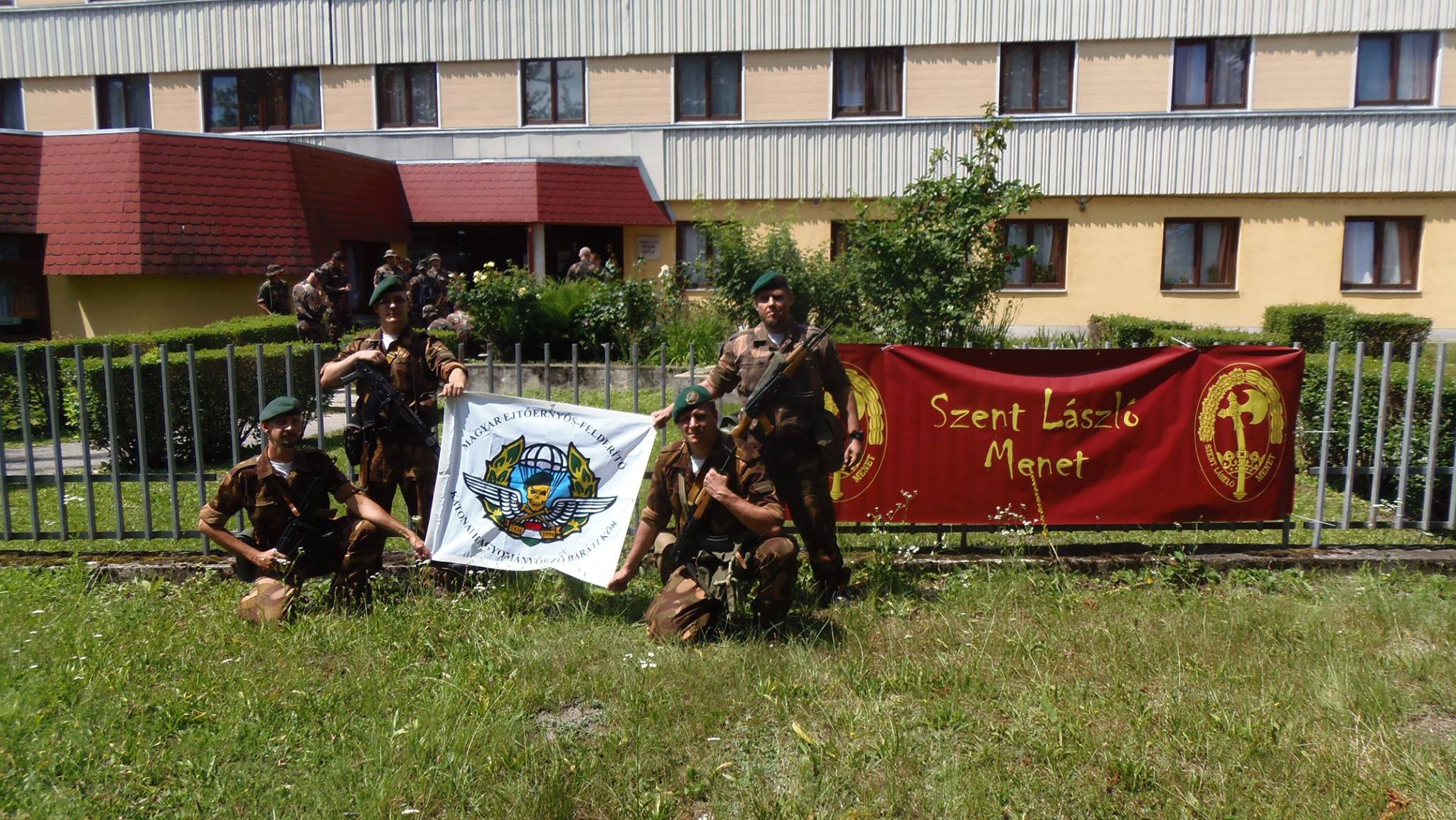From battle to battle – 1944 and 1945
The last two years of the war has seemed to take up on the paratroopers in terms of challenges, tasks, and losses. Because of the more and more aggressive German demands to mobilize the unit the Hungarian leadership had to respond by doing so, especially after the military occupation of Hungary by the Germans on the 19th of March 1944. Thus the Parachute Battalion has been reorganized as the 1st Parachutist Group and sent to the Lower Carpathians with the task of partisan-hunting. The paratroopers have left Pápa by trains, which has caused a major uproar amongst them, as they have wanted to go into battle by riding airplanes, not by stock cars. As one of their officers, 1st Lieutenant Árpád Nagy recalls his thoughts on departure:
“Involuntarily I think about death. It could be like this when the soul leaves someone. Pápa has just lost its soul, its life. A joyful, carefree company of men heads for blood, death, and hardships, with glittering eyes. As if it has been written on the outside of the train: Now you will see what we can do! Everyone aboard is waiting for miracles, every eye looks forward. To the miracles ahead. It will be a costly miracle, lads but it will be done!”
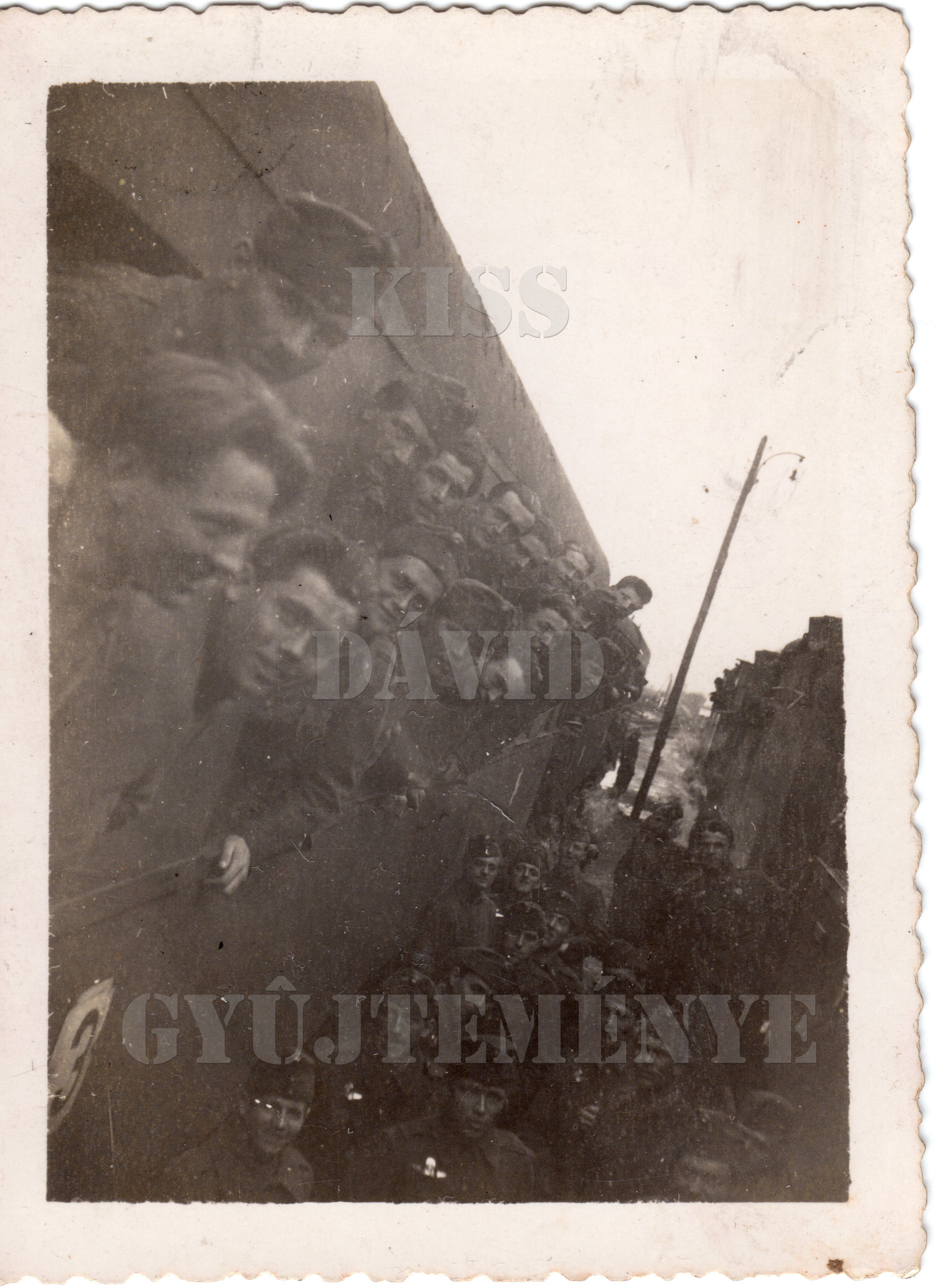 Paratroopers riding a train
Paratroopers riding a train
The unit has reached Beregszász, on the 7th of June, 1944, one day after the Allied landings in Normandy. The Hungarian paratroopers have only briefly escaped their deployment on this new front, as the German plans have involved their departure to the Western Front against the Allied forces. This circumstance could affect the hasty departure of the unit to the Eastern Front, with the task of “fighting partisans”, as there were no such forces in the area of Beregszász. So the unit has been narrowly escaped its faith by the help of the Hungarian leadership, which has wanted to keep the unit intact, and out of German sight as long, as possible.
Twenty days later, the 1st Parachutist Group moves into positions, to hunt for partisans. The paratroopers are conducting company-sized patrols, but find nothing. This time is enough for the joyful soldiers to accommodate to the discomforts of the frontline, and test their skills under “operational” circumstances. They have remained in the area for nearly two months, chasing non-existent groups of partisans, and much more lively groups of girls during leave in the nearby towns and villages. The first wartime casualties are around, as one paratrooper drowns in a mountain river during a patrol, another falls from the train, then an other soldier shoots himself in the leg, and dies of septic infection.
The good days have ended, when in the first days of August the 1st Parachute Group has been reinforced with heavy weapons, communications, and engineer units, and then sent to Volóc on the 15th of August. During loading into the trains Soviet airplanes are attacking the unit, causing panic, and inflicting some casualties. The war has come for the paratroopers.
One month before the company of paratroopers had to be rushed to Nagyvárad, another, battalion-sized group of Hungarian paratroopers have went to war on the 28th of August 1944. Their mission was to close the valley of the Ilmenka on the historical border of Hungary before the Soviet forces can reach it. It has been started with a company-sized reconnaissance mission to evaluate the number and equipment of the enemy forces. The operational plans has been worked out by the commander of the unit, Colonel Szügyi veteran of the Eastern Front, who has written about the action of his paratroopers to his wife a week later like this:
“I have accompanied them, to see them in action, and to give advices on the spot. They have worked flawlessly. There is no problem with the nerves nor amongst the officers, or the enlisted ranks, and they also lack that horrific wartime exhaustion, that is so typical to the troops on the frontlines. They have wasted all of the Russians in two forward outposts, because after surrendering, one of the Russians have picked up his rifle, and started shooting at them. They have only brought back a captured light machine gun, and some small arms. When I have started to scold them like »bastards, you would have brought at least one prisoner, to interrogate him about the further positions« then they after an hour have found a living prisoner, and seven Russians in civilian clothes, who have been rounded up around the Russian lines. Aren’t these guys funny fellows?”
After this action, the 1st Parachute Group has been sent to Viszkov (Wyskow) some 30 kilometers away, in the valley of the Mizunka. This has been the first of their many more “evictions”, as the unit has been sent into battles during these two years of war as a “firefighter unit”, sent from one bloody battle to another. There, in the Mizunka valley the Hungarian paratroopers have assisted the defense of the Hungarian borderline. During this period the Hungarian paratroopers have thwarted a major Soviet attack on the 9th of September 1944, by breaking the enemy lines, and marching 6 kilometers (!) behind enemy lines, disturbing not only the Soviet frontline, but also destroying a headquarters, and several observation posts. 1st Lt. Nagy has remembered like this:
“Mizunka. This could be only done by paratroopers, and done like this. I was not there (…) It sounds like a fairytale. The frontlines were silent for weeks, our troops in the defensive positions have sunk into the silence, no prisoners, or enemy casualties for weeks, so our commanders had no clue about the enemy plans. Then came the order for our battalion, to (as the reserve of the division) go on a mission, inflict casualties on the enemy, and gather intel for us. Our leaders were so lethargic, that even they have only hoped for 20-30 dead enemy soldiers, and one or two prisoners. Two of our companies have volunteered to take part, but by share luck only our 1st Company have been active during this battle. The lads have departed on Saturday to flank, and overrun the enemy. I don’t want to keep pulling strings: our 1st Company, after half a day of marching has flanked by two kilometers behind the Russian lines, where they have met an enemy battalion, resting in the bunkers. Like thunder they have attacked the enemy, and eliminated the whole unit. Our guys fought like devils. Like paratroopers.”
In this attack a single parachute company has breached the Soviet lines for six kilometers, annihilated a whole Soviet battalion, and captured several prisoners. The toll was high, as the leader of the mission, Captain. Lajos Molnár, a well-known and beloved paratrooper officer has died while leading his men in close combat. He has been buried on the historical border, and the paratroopers have started to gain fame not only at home, but also from the enemy. As 1st Lt. Nagy concludes:
“From now on there were no paratrooper prisoners in Russian hands. The shiny silver badges with the skull, our leather jackets, and jumpboots were good recommendations for a trip to the afterworld in the eyes of the Russkies.”
The 1st Parachute Group has held the line there from the 28th of August, to the 12th of October, against waves of Soviet attacks, and lost around 280 of its men in wounded, missing, and dead doing so.
It is also important to mention the one and only airmobile mission of the Hungarian paratroopers in WWII. As we know from history paratroopers as an unit are always handy when one is in need for a quick reaction force. This is what happened on the 26th and 27th of September 1944 when a company-sized element of the Parachutist Replacement Battalion, stationed at Pápa, and tasked with replacement training has been airlifted to Nagyvárad, Romania. The parachute company had to secure the airfield and vicinity of the Hungarian city after the Romanian coup on the 23rd of August 1944. The former ally of Germany has switched sides and started supporting the Soviet Union hoping to get back its lost territories and end the war on the winning side. This situation has foiled the defense plans of the Axis, and more closely the national defense of Hungary, which has built its defensive lines according to its standing alliances. Securing the airport of Nagyvárad became top priority to support the evacuation of Hungarian and German forces in the area. The parachutist company had to be airlifted to the airport, where they were to attack from the landing airplanes and secure the area. The soldiers were equipped with the best that could be found at Pápa, including the 1943M Danuvia “Király” submachine gun, wielded by every paratrooper of the 175 soldier strong unit.
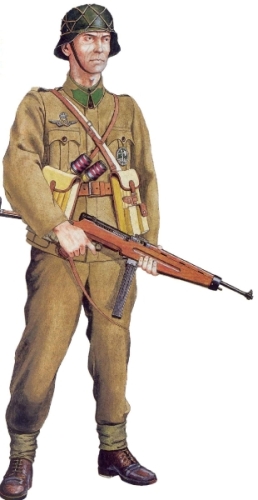
The 1943M Danuvia “Király” submachine gun
The distinctive, folding stock submachine gun had its roots in 1939, when the 1939M “Király” submachine gun has been introduced as the standard submachine gun for the Royal Hungarian Army. The 1939M had a full sized stock, a folding magazine, and could be fitted with bayonet. Its shape and size with folded magazine has been similar to the carbines used by the infantry, thus allowing the officers, and senior NCOs, who have used mostly this weapon to blend in more easily with the lower ranks, avoiding enemy sniper fire. The imaginative submachine gun though proven to be too long for parachute jumps, thus the 1939M had to be modified to suit better the paratroopers’ needs. Firstly a side-folding full stock model had been developed under the name of 1939MA, then after trials with the weapon a redesigned submachine gun has been requested by the paratroopers. The new weapon has come out in 1943, and bore resemblance to the German MP-40 and to the Soviet PPS-43 too, by having an under-folding stock. The folding magazine, and its reduced barrel length made this weapon to be an ideal, domestic replacement of the older MP-35 submachine guns, and used extensively by the paratroopers in WWII. Mass production made it possible to equip non airborne units too with the weapon, making the 1943M “Király” submachine gun an iconic late war weapon in the hands of the Hungarian soldiers.
At Nagyvárad the paratroopers under the command of 1st Lt. Zoltán Kiss have landed in the middle of a firefight. Their airplanes after unloading the soldiers in the runway have turned around and took off immediately. The paratroopers after a hurried rally have raced towards their public transport buses, riding them to the frontline, where they have taken up a defensive line. At dusk a combined Soviet-Romanian force has attacked the paratroopers, who have stood their ground. After some 36 hours of silence a much stronger and larger enemy force has attacked the paratroopers in defense, who after depleting their ammunition had to withdraw. After re-organizing the paratroopers have returned to assist the German forces holding the very same line. According to the paratroopers the Germans had as many tanks in defense, as many paratroopers had to hold the line days ago. After one week of defensive battle the paratroopers, acting as tank hunters and support infantry have been relieved, but not to rest at all. Their destination was Tiszafüred, the defense of the river Tisza, for eight more days. 43 of them have left the frontline to return to Pápa.
The 1st Parachute Group on the other hand has arrived to Budapest from the Carpathians on the 15th of October, on the very same day, when Regent Horthy tried to quit the war, and the Germans have helped the radical nationalist, pro-Nazi Arrow Cross Party, led by Ferenc Szálasi, under the title of “Nation Leader” to gain power, and ensure the Hungarian participation in the war. Maybe the paratroopers, loyal to the Regent were ordered to Budapest, to help Horthy in his secret plans? We will never know, as the plot has failed, the Germans have disarmed the few Hungarian units that tried to fight them, and after brief firefights the new order has been established. 1st Lt. Nagy remembers like this:
“Destination: Budapest. This word means to all of us a calm metropolis, peace, and means of entertainment. We were completely happy. The first bitter sounds have reached us in the suburbs. We have not even understood the people shouting at us:
- We have put down our arms!
We were shouting back angrily. Could not they see the machine gun on top of our train, and the weapons in our hands? As we have reached the Józsefváros train station it has been clear: Szálasi has taken over. About our poor old Regent we have not got a single word. (…) Pest was full of chaos, we were almost unable to find our place. We have not pondered a lot: our goal is to fight for Greater Hungary, and against bolshevism. There was no place in our heart for treasonous thoughts against the Germans, though they have acted abominably against both us, and our civilian population in the past. We have seen it impossible to fight against our former allies.”
The paratroopers at Budapest have been ordered to go into defensive positions in the suburbs of Soroksár and Dunaharaszti. The unit with its two battalions has been re-designated, as the 1st Parachute Regiment of the Szent László Division. The soldiers were given new badges, depicting a hatchet enclosed in a wreath, symbolizing the elite status of the division.
The paratroopers have arrived to the frontline on the 23rd of October 1944, and as 1st Lt. Nagy remembers:
“This is the second time we are in the defensive trenches, while there is no sign of the enemy at all. The first was Uzsok, where we have not waited for them to show up. Now we will wait for them. They will find not much joy in it!”
The Hungarian paratroopers held the villages of Soroksár and Dunaharaszti just east of Budapest, both being technically the suburbs of the Hungarian capital. The trenches were prepared by citizens of the city, and conscripted forced laborers. The main line of defense was a deep anti-tank trench, with additional trenches for infantry units, and the heavy weapons of the battalion.
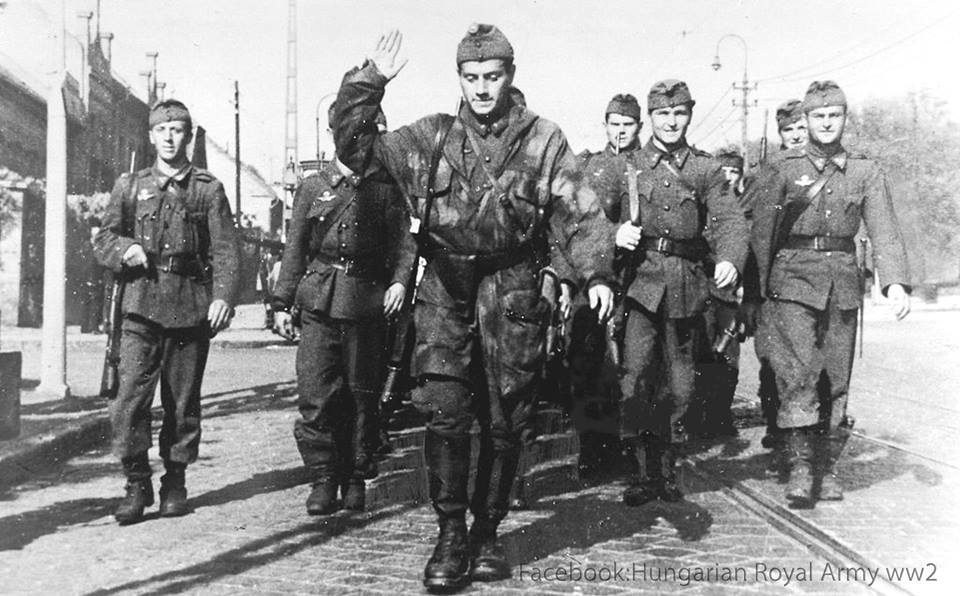 Hungarian paratroopers on the move during the early battels of 1944. Note the camo jump smock of the officer up front. -These smocks were modeled after German ones, but have been tailored personally by using shelter half/poncho materials.
Hungarian paratroopers on the move during the early battels of 1944. Note the camo jump smock of the officer up front. -These smocks were modeled after German ones, but have been tailored personally by using shelter half/poncho materials.
The soldiers were living in these trenches, sharing the area with worried civilians, and ravaging party militia of the Arrow Cross Party, rounding up Jews, executing, and looting all around the city. As a member of the 2nd Battalion has summed up his controversial feelings while deployed on the frontline:
“It seemed we are safe here, at least we are safe from meeting the members of our newest army. They have worn a distinctive armband with an arrow-cross on it, as their party symbol. They have called themselves the Árpád-stripes, mixing the name of the founder of our nation with their dirty business. It is nearly unbelievable, that soldiers of a nation felt safer on the front, than in their cities.”
It is safe that most of the paratroopers have disliked, or openly hated these militiamen, as most were seen by them as unprofessional rascals, not respecting authority at all, and worsening the sufferings of the civilian population, not to mention that it was a rare spectacle to see any of them showing up for actual combat service in the first lines. The mostly apolitical and highly professional paratroopers were the complete opposite of these militiamen.
The first Soviet attack against the defenses of the Hungarian capital has been started on the 2nd of November 1944 in the vicinity of Soroksár, south of Budapest, and lasted for only around ten minutes. As 1st Lt. Nagy recalls in his lengthy memoire:
“The outcome of the first and most fierce attack against Budapest has been decided in around ten minutes. Our paratrooper boys have crouched so low in their foxholes that not even their cap cockades were showing over the top. The tanks were approaching without any clue in the seemingly silent countryside, when clods of earth has started to roll, corn has started to move, and from the base of the trees phantoms emerged screaming hauntingly, and surrounded the shocked tank crews, like angels of death, or paratrooper beasts. The warheads of the Panzerfausts have been launched, and exploded on the tracks, and turrets of the enemy tanks, tearing them apart, turning these armored fortresses into burned down ruins, filled with the bodies of the formerly so proud red soldiers. It did not take ten whole minutes and our boys were lying in the trenches again, snarling, and waiting for the attack of the Soviet infantry.
No way that these stinkers will waltz into Budapest! The wrecks of their tanks were smoking ghostly in front of our lines, but their infantry did not come. Our sole sight has been enough for them for a life. The shouting of their political officers were in vain. It had no effect to fire on the fleeing soldiers by their own officers. After half an hour there was no sight of living Soviet soldiers in the area for kilometers around. The German field commander has thrown his cap in the mud and groaned in excitement: If I could get three divisions of warriors like you boys I will chase the Russkies back to the River Don by the end of the month!”
The Soviets after the failed attack has tried to overrun the anti-tank position of the paratrooper battalion, by using a captured German tank, or a Soviet tank masked as a German one, as a decoy. In the ensuing battle the position has been destroyed with its commander, but the attack has been halted. On the next day, the 3rd of November the paratroopers have launched a night-time counter-attack with a company sized element of 110 paratroopers, supported by machine guns, and 40M Nimrod self-propelled anti-aircraft guns. The Soviet defenders have fled, leaving behind their wounded, and most of their equipment.
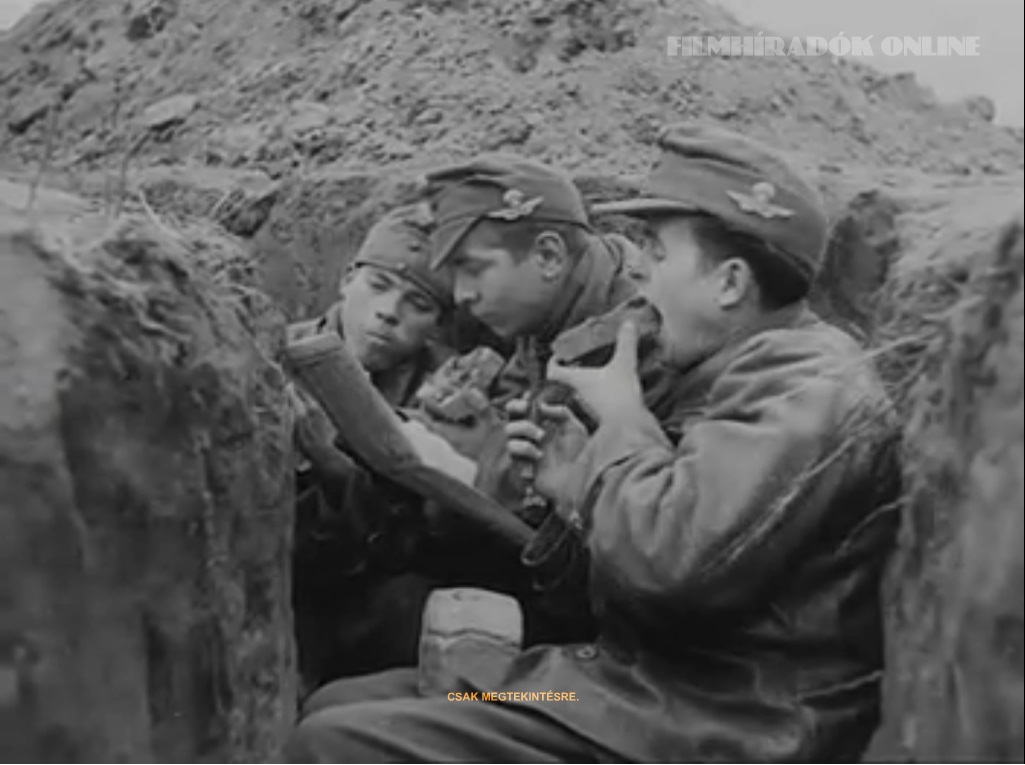 Hungarian paratroopers in their trenches during the battle for Dunaharaszti and Soroksár. Note their jumpwings pinned to their hats in an unauthorized way.
Hungarian paratroopers in their trenches during the battle for Dunaharaszti and Soroksár. Note their jumpwings pinned to their hats in an unauthorized way.
On the 4th of November the Soviets have mounted a counter-attack with joint waves of infantry and armor, but the Hungarian defenders after letting to pass the tanks have fired upon the advancing infantry, thus pinning down them, and encircling, then destroying the tanks. Many of these destroyed Soviet tanks have been used by the paratroopers as fortified machine gun nests, and even as bunkers, by turning around their turrets and firing their main cannons, or machine guns. The renewed attacks had no effect on the Hungarian lines. As 1st Lt. Nagy remembers:
“Even a week after their first big attack they have moved in front of our lines like a child in fear of being beaten again. I have almost started to feel sorry for them. In the meantime they have tried to mount attacks of various scale, but all of them have collapsed in front of our lines, as none had the necessary power or will to succeed.”
This situation could have made the commander of the battalion to become frivolously daring. Major Pokorny has ordered his paratroopers to attack the nearby village of Taksony with a force of only 38 paratroopers, drawn from the reserves of the battalion. The attackers had one hour to get ready for their suicide mission, without any artillery support, only trusting their self propelled anti-aircraft guns as moving fire support. The attack has been started on the 8th of November 1944.
The attack has started surprisingly well, as a whole battalion of Soviet infantry in static defenses have fled from the Hungarian paratroopers, mostly because of the fearsome reputation of the later. Major Pokorny led the attack sitting on top of one of the 40M Nimrod self-propelled anti-aircraft guns, shouting orders all around, using his binoculars, and waving for his force to advance. He has been soon spotted by Soviet artillery, which has started to rain down on the advancing Hungarian forces a barrage of devastating fire, while the fleeing Soviet forces have turned on the handful of Hungarian attackers, caught in the open. The outcome of the attack has been decided, when the carelessly brave commander of the tiny force has been hit by shrapnel of an exploding Soviet shell, injuring him severely.
The loss of their commander and the Soviet firewall finally stopped the charge, and made the paratroopers fall back to their former positions after losing 10 killed in action, and 17 wounded, counting in the commander of the whole battalion himself. The Hungarian paratroopers have not achieved the goal of liberating Taksony, which has been an oversized task from the beginning.
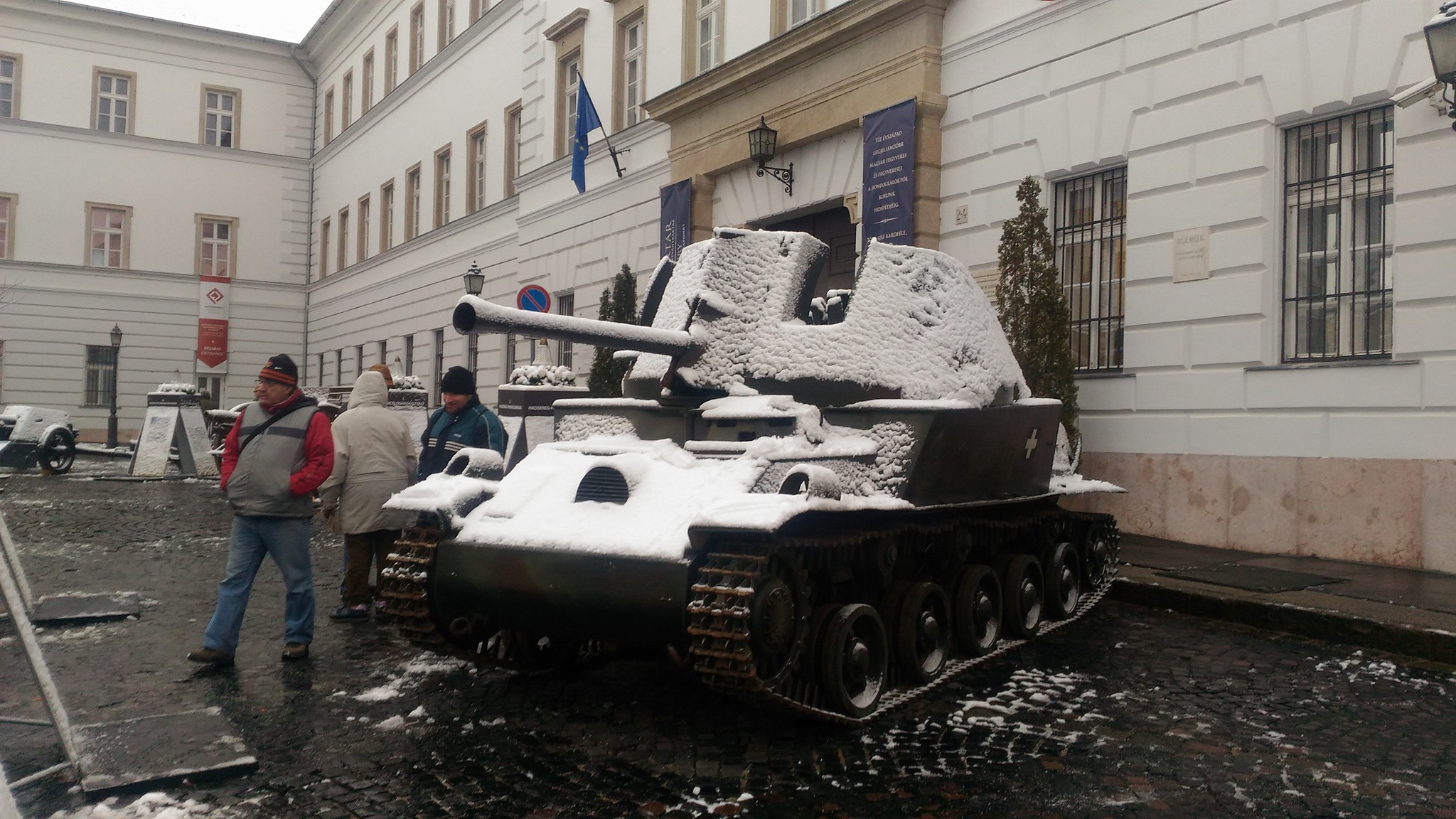 1940M Nimrod self-propelled anti-aircraft gun
1940M Nimrod self-propelled anti-aircraft gun
This has been the final act of the involvement of the Hungarian paratroopers in the defense of Budapest in the area of Dunaharaszti and Soroksár, as for the following days the lines have frozen into a static position, with the biggest danger being the enemy snipers and the artillery fire taking its toll. On the 12th of November the 1st Parachute Battalion has been relieved from the frontlines to rest and re-organize before being sent back to the front. They have lost in the ten days of defense the 40% of their manpower in killed and wounded.
The defense of Budapest has established the fame of the Hungarian paratroopers amongst their German allies, and their Soviet enemies alike, not to mention the civilian population of the capital city, who has seen the elite Hungarian soldiers as the saviors of Budapest. As 1st Lt. Nagy recalls their withdrawal from the lines:
“The crowd was cheering, and the paratroopers, filthy from the long time spent in the trenches jumped in the cars like royalty. Lots of them had to be collected in a half-drunken state. As much the people of Dunaharaszti disliked us first, they have just as much fell in love with us in the end, and stuffed us with food and drink. They have thought that we will stay there forever and protect them.”
On the 13th of November the 1st Parachute Battalion arrived to Isaszeg, east of Budapest, where the paratroopers had to defend the village in pouring cold rain against overwhelming Soviet forces. 1st Lt. Nagy laconically sums up the situation:
“It was an extremely rotten place, completely visible positions, and holes covered with corn stalks, acting as bunkers (…) It was sheer luck that thick fog covered the hillside all the time, where our battalion dig in, fully exposed. Without the fog it could have been most probable, that the physically and mentally exhausted paratroopers, facing such an enormous enemy force could not hold this impossibly-paced line.”
The paratroopers were under constant sniper fire, precisely placed mortar rounds, and tank shells made daytime movement impossible. The Soviet infantry charged the hillside and fell back in hand-to-hand combat, while the cold rain just fell. The battlefield looked more like to be one from the First World War, than belonging to a modern, mechanized war. Presence of massive artillery concentrations on both sides supported this picture more and more. Finally on the 23rd of November 1944, after ten days of hopeless, fluctuating battle the paratroopers have been relived from the front lines.
Truth to be told the staff of the Szent László Division has utilized a little artifice, and acted on its own intentions when (without official German permission) they have simply withdrawn the exhausted battalion, while promising a whole division in exchange for the paratroopers. The German answer was short and stern: “keep the division, and give us back your paratroopers.” While the higher echelons struggled, the remnants of the battle hardened 1st Parachute Battalion silently reached Pápa. They have lost around 50% of their force in dead, wounded, and missing in the defense of Budapest.
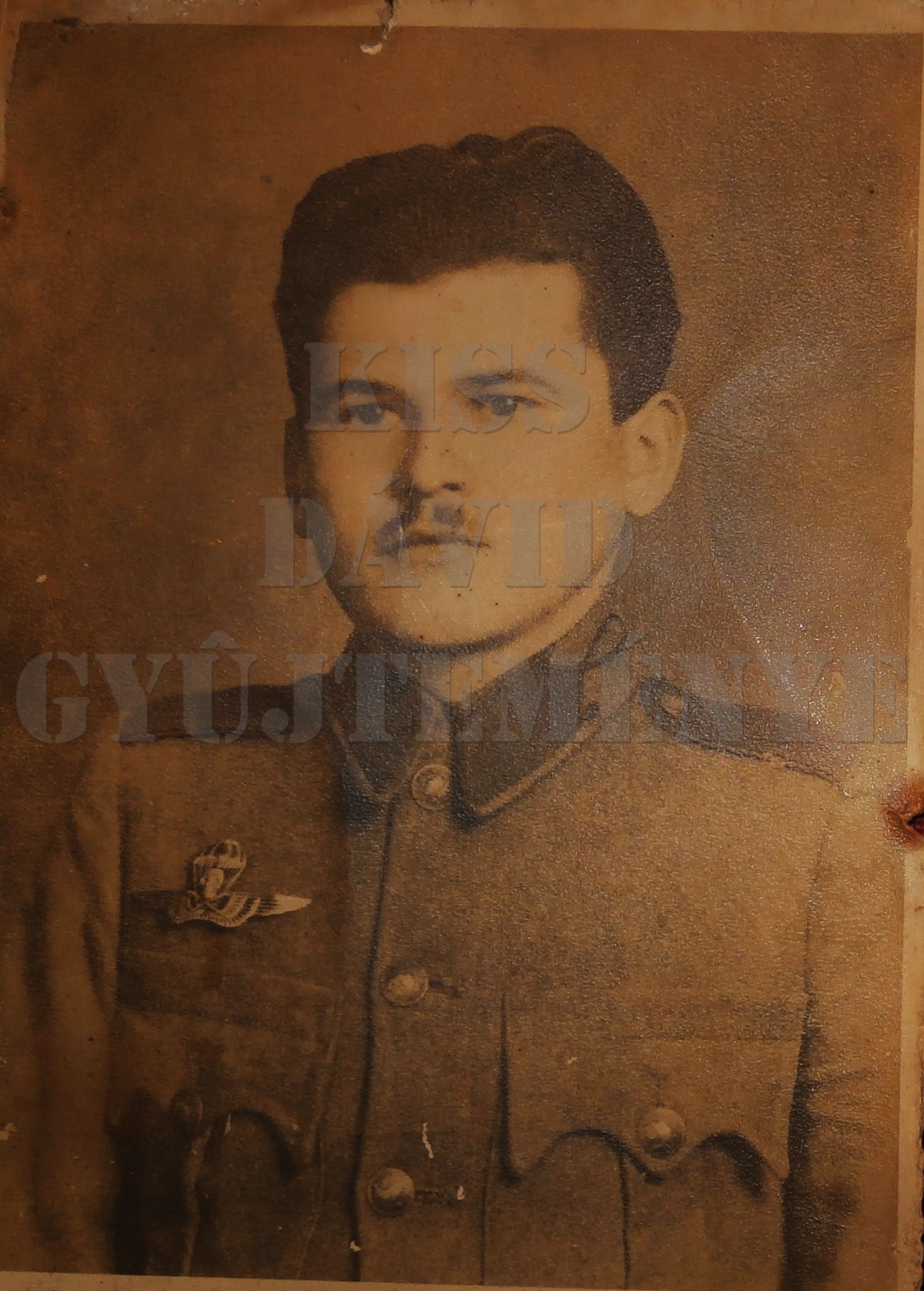 Paratrooper Private Sándor Mezei, killed in action at Soroksár on the 5th of November 1944.
Paratrooper Private Sándor Mezei, killed in action at Soroksár on the 5th of November 1944.
While the 1st Parachute Battalion marched into the pages of the history books of the defense of Budapest, the 2nd Parachute Battalion started its war at Csepel defending Budapest from the south between 1st of December to the 12th of December 1944.
The 2nd Parachute Battalion has been activated on the 17th of October of the same year, with around 1 400 paratroopers in its ranks, thus a long-awaited Parachute Regiment became reality. The core of the unit has been made up of veteran paratroopers of the 1st Parachute Battalion, while the bulk of the new battalion consisted of freshly drafted 17-18 years old Levente-paratroopers, and some non jump qualified experts from other units, who could train the young paratroopers the handling of machine guns, mortars, and radios. The new battalion went through an accelerated jump school together, qualifying by conducting only one parachute jump per soldier, instead of the officially required four, as all of the Levente-paratroopers had previous parachute training in the pre-military youth movement, and their instructors wanted to save time for combat training. One of the young Levente-paratroopers, Béla G. Ábel reasoned his choice like this in his memoires:
“I am sure that in any of the world’s armies there is no warm welcome for the recruits. The unfamiliar milieu, the harsh treatment, the series of hazing is not helping either the accommodation to the military life. About Pápa though there were different news regarding the training. It was rumored that their training system is more humane in general. We felt it that way, as we could not avoid being drafted, if we could manage to get to Pápa, we could not only be part of an elite outfit, but could also expect better treatment.”
The cloudy expectations of the recruits have been dismissed shortly after their arrival to Pápa. Paratrooper Béla G. Ábel shares his memories of basic training with us as it follows:
“In the morning, when the soldier wakes up, his first task is to run down to the marching ground half-naked in any weather to conduct physical training (…) Good physical condition was of utmost importance. (…) after that a quick wash, getting dressed, then breakfast. (…) We had to consume everything by the time we have reached our quarters, then clean our mess tins. After breakfast the daily training has started. To be honest our unit looked really miserable. We have been given the worst equipment around, handpicked by careful attention to details. (…) As during the first few weeks the recruit spends his time mostly on his belly, not on his foot, if possible lying in the deepest mud, it would be unnecessary to give him new uniforms anyways. (…) It seems to be an unwritten law too, that older soldiers feel obliged to haze newcomers constantly. It was a free hunt for recruits. Some of the older soldiers used their position to the limits. (…) This was a part, which could not have been avoided, nor explained. (…) If someone tried to show his emotions on the topic, he has ended being chewed up more intensely. (…)”
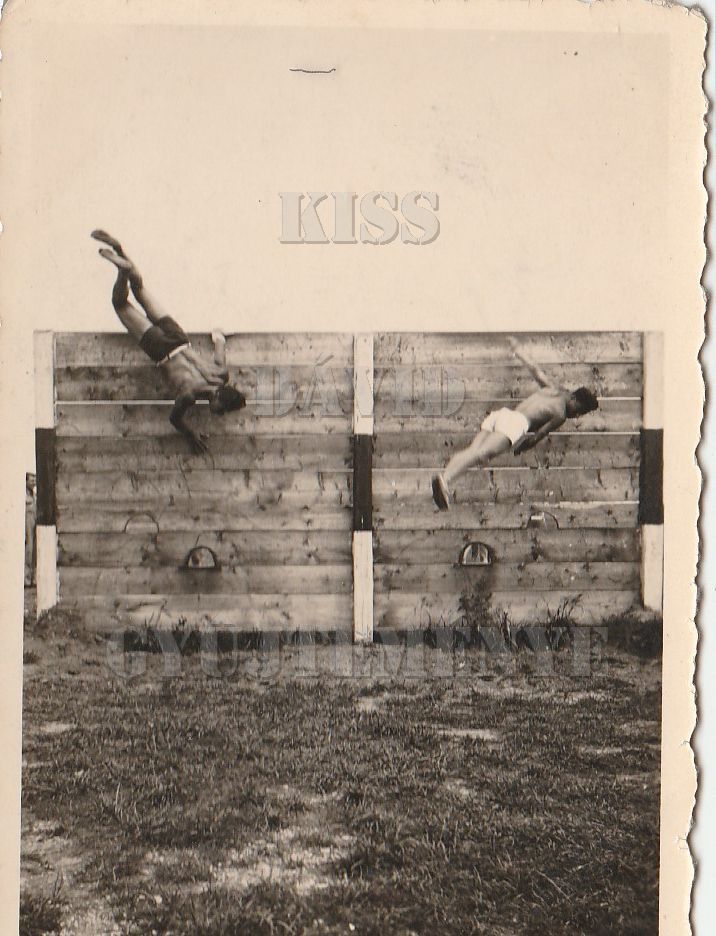 Paratroopers scaling an obstacle while wearing only shorts has been a common sight during basic training.
Paratroopers scaling an obstacle while wearing only shorts has been a common sight during basic training.
After basic training the young paratroopers have conducted their first and only parachute jump on the 1st of November 1944. The mass jump of around a thousand paratroopers lasted for a day, and took the life of one of the jumpers. Pvt. Gyula Sárosi, a 17 years old recruit of the heavy weapons company has exited the plane incorrectly, and his main canopy got caught on the tail of the plane. The panicking paratrooper deployed his reserve chute, which has broke away soon, leaving him without means of escape. Some sources claim, that at this point his jumpmaster, a seasoned paratrooper after realizing the situation, cut away the cords of the parachute, saving the plane and letting the young paratrooper to fall to his death. The tragedy, which became the last parachute accident of the Hungarian paratroopers during the war, has been witnessed by the whole battalion, but none of the recruits have refused to jump when they have been asked.
The first and in many ways unforgettable jump has been followed by extensive ground combat training, with live fire exercises, forced marches and weapons maintenance. Live fire exercises have been conducted by half of the unit shooting the targets, while the other half took cover in between the firing line and the targets, to get used to the sounds, smell, and “taste” of live fire. Hand grenade practice has been conducted in a similar way, making the paratroopers charge through the smoke of their grenades. With cautious execution there were only a few accidents, though one of the instructors lost his fingers while demonstrating the use of hand grenades. The young paratroopers have observed a change in the atmosphere and the behavior of their instructors towards them. As Béla G. Ábel remarked:
“To our enjoyment the treatment we have received so far has changed. Now we were not to salute even the lamp posts. The older soldiers trying to embitter our lives in every imaginable way, started to work on a more comradely relationship. It was not an easy task, considering the fact that just a few days ago they were the ones hazing us. Everyone knew that our game of playing soldiers will become a dark reality shortly, and no one wanted to go to the frontline with enemies in their unit.”
The 2nd Parachute Battalion has been mobilized on the 28th of November and reached its destination on the 1st of December 1944. The young paratroopers, riding blue public transport buses, wearing their parachutist badges and shiny jumpboots, armed to the teeth were eager to fight for their country. As Béla G. Ábel remarked:
“Half of the country has been lost, and the remaining parts had nothing to hope for in the future. But finally I could fight for my homeland, or at least for the remnants of it. Whether the whole thing made sense or not, it did not matter at all.”
The paratroopers at Csepel have got into well-prepared positions, guarded by minefields, barbed wire, and electric cables, electrocuting anyone who tries to cut them. In addition a large artillery concentration has gathered behind the Hungarian lines, 120 various artillery pieces supported the fight of the paratroopers. A Soviet attack has been repelled easily on the 6th of December, and then six days later the paratroopers of the 2nd Parachute Battalion have left their relatively comfortable foxholes to get a taste of real war.
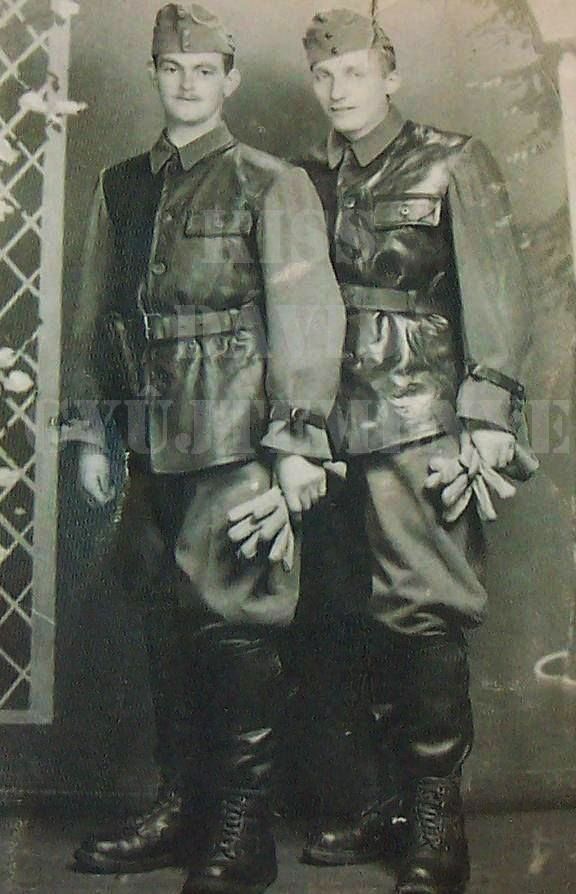 Paratroopers of the 2nd Parachute Battalion in typical late-war uniform. On the left memoire-writer, Béla G. Ábel
Paratroopers of the 2nd Parachute Battalion in typical late-war uniform. On the left memoire-writer, Béla G. Ábel
In these days the 1st Parachute Battalion has been reorganized at Pápa, by the calling up of reservists, volunteers, and by the return of recovered paratroopers from hospitals. Morale was high due to the traditional paratrooper fighting spirit, but there was a bit of cautiousness in the air, due to the presence of seasoned veterans with healed scars on their bodies, but open wounds in their souls. As 1st Lt. Nagy states:
“Our old warriors were like steel hardened in fire, dressed in uniform. They have scorched anyone near, and the girls have tried to avoid the flames shining in the eyes of these boys by shutting theirs. But these flames burned through eyelids, clothes and skin alike. These guys were not the same paratroopers as they were before. And now the vehicles packed full are rolling out, leaving behind flaming hearts to ride into battle with the First Battalion. Again the First, that has fought so much, suffered so much, and lost so many. I don’t want to tell lies, we were not happy to go. We have even cursed sometimes about it. Enlisted men cursed because of the canceled rest, us, officers because of the lack of trained reinforcements. We had soldiers, who were there for one week, without any military training. They could barely fire a rifle. We had to trust in the high morale of the unit. Maybe the veterans will pass down the paratrooper fighting spirit!”
The battalion has moved out on the 2nd of December 1944 to the lake Balaton to halt the advancing Soviet forces. The paratroopers have reached their destination near Kéthely and engaged the enemy on the 6th of December, in co-operation with German self propelled guns. The paratroopers have pushed the Soviet forces out of Kéthely with minimal losses, and reinforced the village preparing for Soviet counter attacks. On the next day, after repelling some minor Soviet attacks at dawn, the paratroopers continued their push towards the strategically important Hunyadi-castle which have been captured by the end of the day in close combat. The battalion lost 88 paratroopers in these battles alone, but held its ground until the 18th of December against the renewing Soviet attacks. The silent periods of the battle meant Soviet reconnaissance patrols, mortar and sniper fire taking its toll.
On the 18th of December the Soviets have launched an all-out assault against the Hungarian lines, trying to capture the castle. In the battle, which has been opened by artillery fire, then followed by air attacks, the Soviets even used flamethrowers against the paratroopers, who fought back in heavy hand-to-hand combat. At the end of the day the lines were unchanged, and the paratroopers got word, that they are to be relieved soon. On the 23rd of December the paratroopers left their positions, and returned to Pápa to celebrate Christmas together.
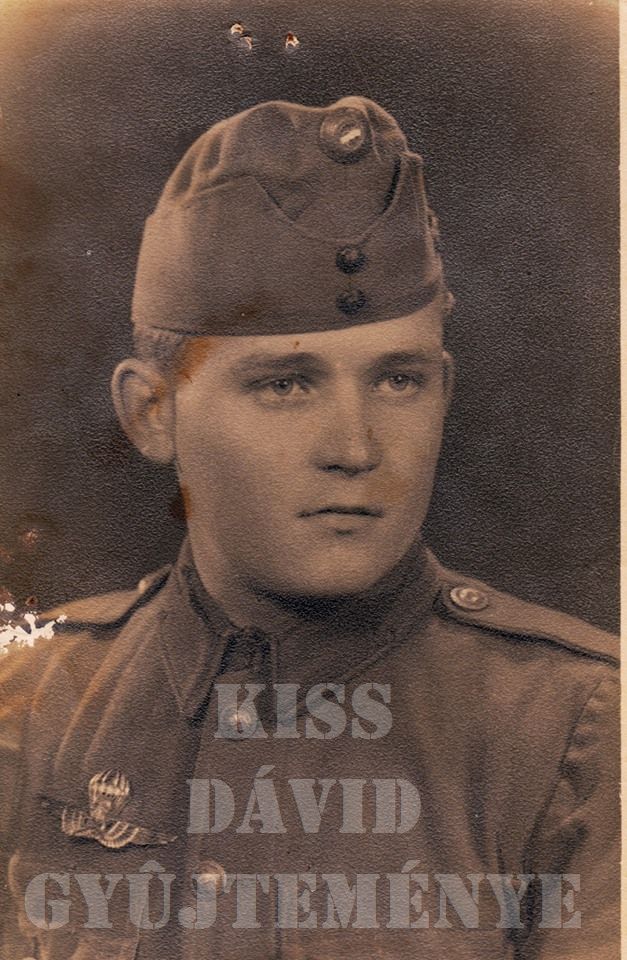 Paratrooper Private Sándor Lendvai killed in action on the 12th of December 1944. at Kéthely
Paratrooper Private Sándor Lendvai killed in action on the 12th of December 1944. at Kéthely
While the 1st Parachute Battalion fought in the Balaton area, the 2nd Parachute Battalion moved to Fót, near Budapest. On the 13th of December 1944 the inexperienced paratroopers have reached Fót and started to move towards their positions, to relieve a battalion of policemen fighting there. To their surprise the defenders were nowhere to be found in the trenches, while the Soviets have got closer and closer rapidly. Thus the paratroopers decided to withdraw to the nearby hills of Megyer, the closest natural line of defense, while the city of Fót has been taken by the Red Army.
Some of the paratroopers could not bother less, as they were more hungry than afraid. One of the young soldiers has decided to pay a visit to his grandparents, living just in Fót, under Soviet occupation at the moment. The motivations of this young paratrooper have been clear: he wanted to get some homemade food instead of the rations he has consumed. He has even asked for permission to leave, and has been granted to do so – it seemed that his squad leader was hungry too. Our hero then left towards the occupied town, with the promise of a fast return. As time has passed, and he has been nowhere to be found, his comrades became more and more nervous. Absence without official leave has been a military offense, punishable by death under martial law, as the paratroopers all knew.
Finally after hours of waiting the young paratrooper has showed up with two dead chickens under his arms, and a Soviet map case around his neck. During his visit he has crossed paths with two Soviet soldiers, also trying to find something to eat, and in the ensuing battle for the chicken house, he has been victorious. Disposing his adversaries of their weapons, and picking up souvenirs he has found the map case, and brought it back to support his story. Finally the chickens transformed into dinner, and the maps went to the higher command. As it turned out the case has contained detailed maps of Soviet artillery emplacements in the village, thus enabling the paratroopers to raid them on the following night. The lucky paratrooper has got away with his adventure without any punishment or decoration, but has been forbidden to go out for food anymore.
After the defense of Fót the 2nd Parachute Battalion has been sent to an other battlefield, to defend the little village of Ipolyszalka, which became just as important to the Hungarian paratroopers, as Bastogne to their American counterparts. The Hungarian paratroopers fought to keep two bridges intact for the retreating Axis forces in the area. They have been there from the 19th of December to the 27th of December 1944, and by the end of the battle only a handful of the once 1 400 strong unit were alive, without equipment, proper uniform, exhausted following a breakthrough and swimming across an icy river. Our other article deals with the heroic defense of this area in details, putting it into perspective by comparing the sieges of Ipolyszalka and the Belgian town Bastogne.
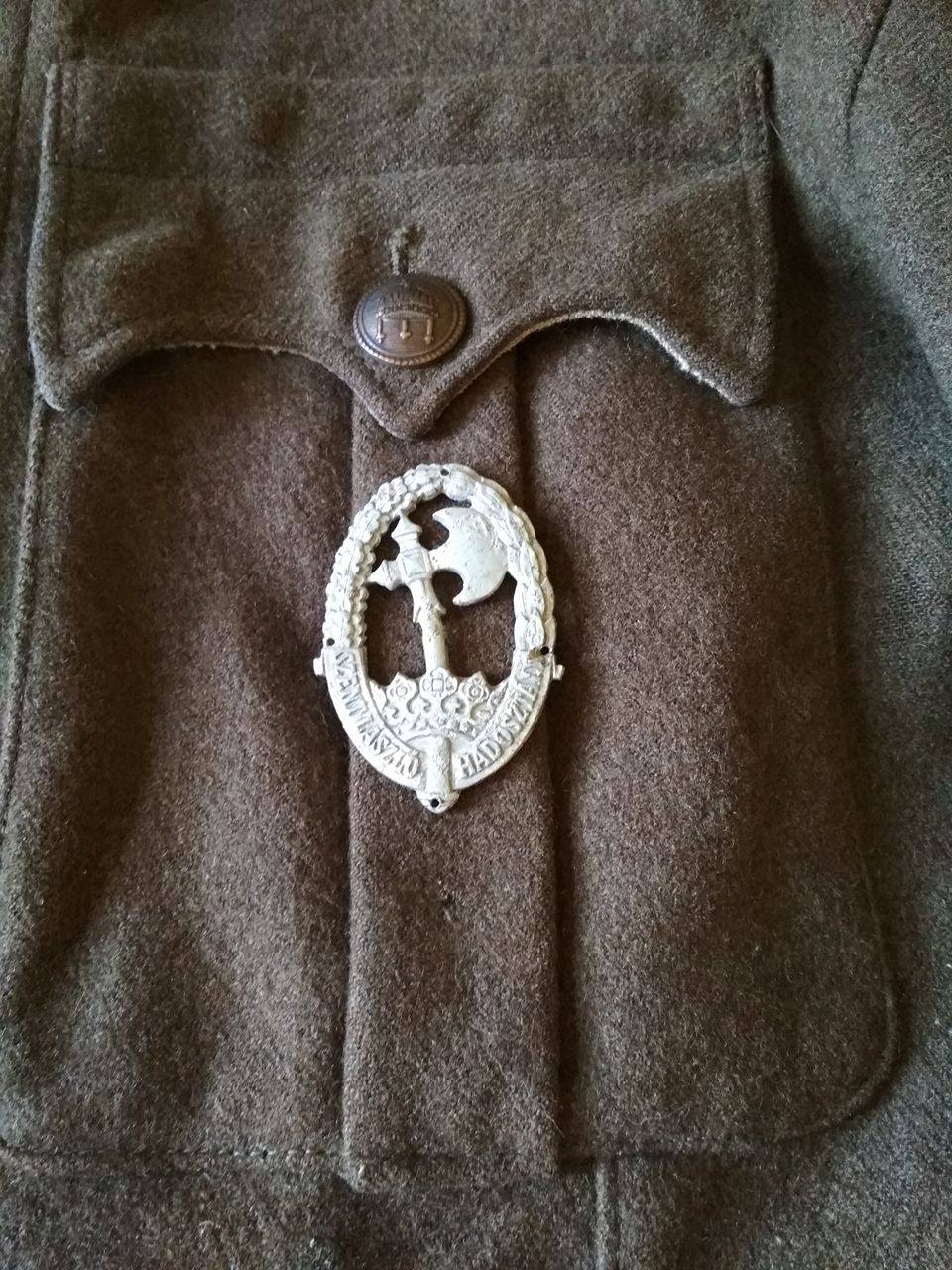 Badge of the elite Szent László Division in which the paratroopers fought recovered from around Ipolyszalka
Badge of the elite Szent László Division in which the paratroopers fought recovered from around Ipolyszalka
After the annihilation of the 2nd Parachute Battalion and the decimation of the 1st, a new unit has been established at Pápa on the base of the Parachutist Replacement Battalion, which has been tasked with training new volunteers, accommodating veteran paratroopers returning from the hospitals, and securing the steady flow of replacements. The volunteers were mostly young boys, who were locals to Pápa, or war refugees who got stuck there. Their level of military training was mixed to none, and their medical and physical evaluation has been similarly short. Around 400 of them showed up to Pápa between the first days of December 1944 and January 1945. Their motivations were different. Most of them were locals, who wanted to avoid conscription into construction and labor units, working on fortifications all around the country, or young Levente kids whose units started to pack and move towards Germany. Others like war refugees were eager to serve and stop the Soviet war machine at any costs.
These youngsters, after dressed in used military uniforms have got a short training in small arms handling, shooting only with rifles, and getting a demonstration on machine guns and hand grenades. There was no time for jump training at all, so these young soldiers have not earned their jumpwings. Their instructors tried to prepare the young soldiers to the realities of war, by emphasizing physical training, small unit tactics training and most of all the core values of the paratrooper spirit. after one month of rapid training a 100 strong company of the Parachutist Replacement Battalion has been mobilized and sent to the front. The soldiers were re-equipped with anything they could get from the storages, but have not got weapons to carry, as they were promised to get them behind the frontline. On the 3rd of January 1945 the company has arrived to Bátorkeszi, near the river Danube, in modern day Slovakia. The remnants of the 1st and 2nd Parachute Battalions have also rallied in this vicinity, so the units were to be blended to create a battle-ready battalion. The new unit had a force of around 400 soldiers, with varying level of experiences. The paratroopers of the new battalion have got 43M padded winter uniforms to wear.

1943M padded winter uniform
The devastating experiences of the Russian winter of 1942 – 1943 made the leadership of the Royal Hungarian Army to re-evaluate winter uniforms. Up to that date all soldiers were equipped with long coats, knitted gloves and tubular head scarves to wear during the milder Hungarian winter, but this equipment, fitting to the milder winters of Hungary, deemed to be useless on the frozen fields of the Eastern Front. Thus in 1943 new winter uniform sets have been introduced, copying the German winter parkas. The set consisted of a padded jacket and trousers, both reversible, with plain white snow camo on one side, and a grey-green camo on the other side for urban and field combat. The modern and compared to the bulky greatcoats more effective set has been highly sought after by the soldiers, and rarely seen worn as a whole, as there was never enough around to equip everyone, thus handing out trousers to one soldier, while giving the jacket to another one became a routine.
On 4th of January 1945 around 300 of the paratroopers have got on German trucks and moved to the front, while the new recruits stayed behind for more infantry training. On the next two days constant roaring of Soviet tank engines foreshadowed the upcoming battle, which has started on the night of 6th of January 1945. Soviet artillery and “Katyusha” rocket launchers started pouring on the thin line of defenders defending the railroad heading to Párkány. Soon after Soviet armored units broke through, followed by a massive infantry charge, simply washing away the paratroopers in defense, who have not got any anti-tank weapons, only their rifles, hand grenades and submachine guns at hand. Absurd scenes followed each other, as Hungarians and Soviets mixed up and tried to sort out enemy from friend in the dark. There were some examples of Soviet and Hungarian soldiers marching together for a while, then realizing the mistake and firing in panic in every direction hitting friends and foes alike. In other sectors the well-concealed paratroopers have simply let the Soviets to roll over their heads then sneaked out of their positions and regrouped. In general the makeshift battalion had little to none chance against the overwhelming Soviet forces, yet tried its best to hold off them. In this chaotic battle Cpt. Zoltán Kiss, the legendary paratrooper officer has been captured, when his car ran into a Soviet unit heading the opposite direction. After regrouping and collecting the detached sub-units the whole of the Szent László Division has relocated to Pápa on the 14th of January 1945.
At Pápa the old Hussar garrison has been found crowded with young local volunteers who have joined because of fear of eviction and forced march to Germany. As Gusztáv B. Ábel recalled:
“New faces all around. Memories are still inside these walls, only our friends, with whom we have connected to these memories were missing. There we have realized how many of them were absent.”
On the basis of several hundreds of volunteers a new Parachute Regiment has been established. There were old soldiers from the 1st Parachute Battalion, the Levente-paratroopers of the 2nd Battalion, and the local volunteers with minimal or zero combat experience. This ragtag group of soldiers had to be re-organized into squads, platoons, companies and battalions by dispersing the few seasoned veterans between the mass of inexperienced newcomers. Every squad had at least one jump experienced veteran, to spread the old paratrooper spirit amongst the ranks, while the NCOs were mostly acting as platoon commanders. Officers were needed in the higher positions in the Parachute Regiment.
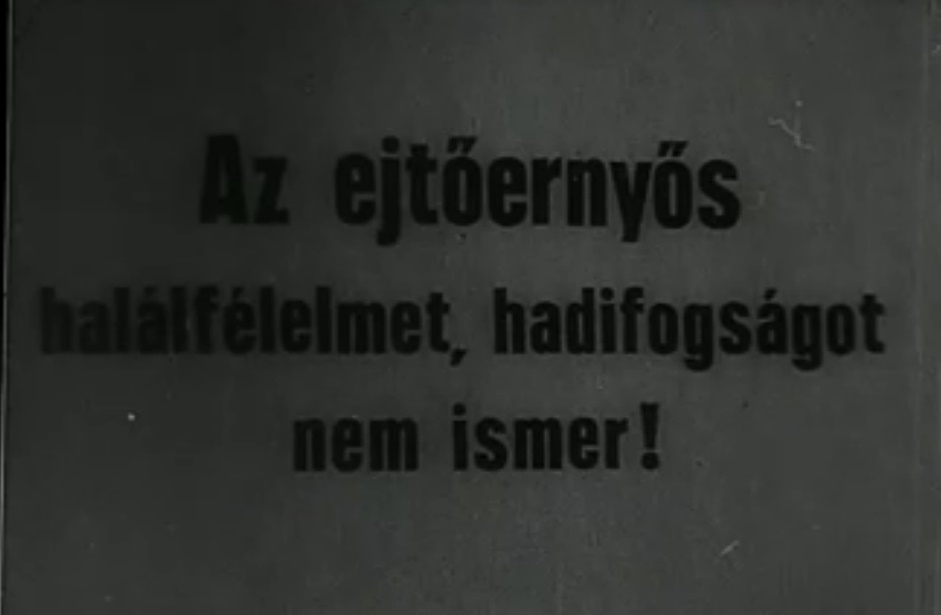 "A paratroopers knows no fear of death nor captivity!" Motto of the Hungarian paratroopers
"A paratroopers knows no fear of death nor captivity!" Motto of the Hungarian paratroopers
The new Parachute Regiment has started to work on its military skills. Most importantly the young soldiers have undergone a daily physical training course, then worked on their weapons skills and small unit tactics. Drill training and old fashioned “spit-and-polish” hazing has gone, as the soldiers of the Parachute Regiment had a lot of work to do. Daily four or five meals were a common treat in the unit, in a time of rationing and distress, which also built up the morale of the soldiers in the unit. On the weekends the soldiers not on duty have got free time to spend together, and even had a glass of vine during lunch. These small luxuries made it possible to the soldiers to bond better, spend time together and know each other a bit more, not to mention to learn from the stories and experiences of their veteran comrades.
A new officers school has been also started to train new paratrooper officers and NCOs for the Regiment. The school has been organized as Gusztáv B. Ábel remembers:
“Six weeks in school, then six weeks on the front as Sergeants. We had to prove that we are able to lead men and keep them disciplined under hard conditions. Then back to the school for an other six weeks, followed by six weeks on the front again. If someone was alive at the end of all of this, he could be promoted to be an officer in the rank of a Lieutenant.”
Of course there was a war raging all around. From February 1945 the news on the frontlines started to become more and more devastating. Budapest has fallen, and the Soviets were heading towards the western parts of Hungary, endangering Pápa. In the first half of February the 1st Parachute Battalion has deployed again near Mány, west of Budapest, most probably to help the struggle for the capital city.
The Parachute Regiment has also started to prepare for the defense of its “nest” by digging trenches and foxholes, picking strategically important points of the city of Pápa, and fortifying them. As Gusztáv B. Ábel, now acting platoon leader and promoted paratrooper Sergeant recalls:
“We have not had to go to the front anymore, as it came to Pápa. Thus on the 15th of March we have dig in ourselves in the castle garden. Because of the springtime rains ground-water was so high that we could not reach the regular one meter depth for our mortar pits. We had to cut down some trees, and by these we have constructed angular positions, filled with earth from the outside, to give it strength.”
The paratroopers have never tested these positions against the advancing Soviet forces, as the leadership of the city, and the commander of the Parachute Regiment has agreed on that they will declare Pápa to be an “open city”, against all standing orders, and avoid the unnecessary destruction of buildings, cultural heritage and human lives. The paratroopers of the 1st Parachute Battalion dug in near Veszprém on the 23rd of March 1945, while the 2nd Parachute Battalion have left Pápa on the night of 25th of March 1945. Thus after seven years of constant presence in the city the Hungarian paratroopers had to leave behind their beloved city.
Both the 1st and the 2nd Parachute Battalions have started their long journey towards west, away the advancing Soviet forces, which were hunting for the volunteer paratroopers of the Szent László Division. As paratrooper Sergeant Gusztáv B. Ábel remembers:
“During daytime we have fought as much as we could, then after dark, we have ran like rabbits. In the meantime we were singing patriotic songs about victories, heroic battles, and our victorious homecoming!”
The paratroopers also had to avoid their German comrades too, as they have tried on several occasions to leave behind the Hungarian paratroopers as a bait, or to save time for their own retreat. Sources, like memoires of officers support these claims, and show us the real horrors of war, where survival became the only motivation. The memoire of Sergeant Gusztáv B. Ábel also supports this view:
“Our activities looked more like a survival training than anything else. The most extraordinary thing was that no one tried to escape.”
The paratroopers, low on morale, ammunition and exhausted by the constant retreating have finally reached the border of Hungary on the 3rd and 4th of April 1945. The paratroopers here had to decide whether they continue the fight and try to reach the Western Allies, or leave their unit and try to reach their homes in civilian clothes. Their officers have not tried to stop them, understood completely their feelings. Just like if a volunteer paratrooper decided not to jump out of a plane, these soldiers have felt that they have did everything to defend their country, and standing on its border decided to end their war after fulfilling their military oath.
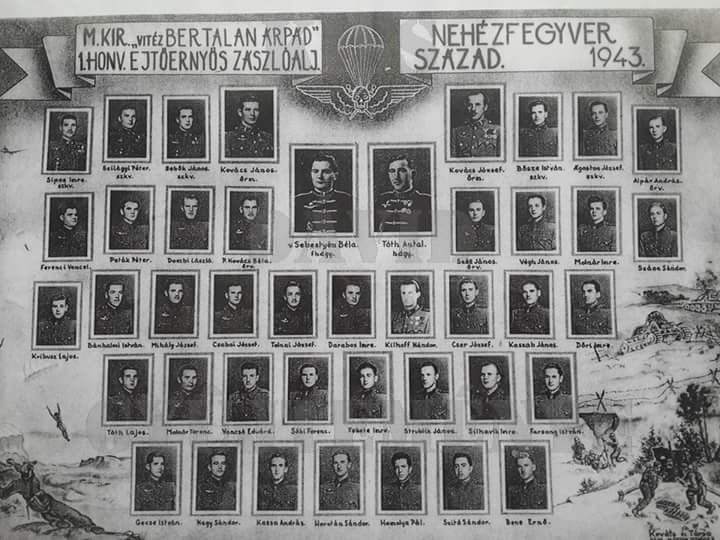 Members of the parachute heavy weapons company in 1943. 2/3 of them has died or wounded during the last two years of WWII.
Members of the parachute heavy weapons company in 1943. 2/3 of them has died or wounded during the last two years of WWII.
The remaining paratroopers have headed for Graz, in the Third Reich where they had several days on their own. During this free time the paratroopers have started to ponder on their future. As Sergeant Gusztáv B. Ábel recalls:
“Now, feeling that the finale is not so far at all, my country, I wanted to serve is under foreign occupation, my future was not so bright (…) The only positive point was that I could prove myself that I can stand my ground in any circumstances, thus in these days it meant to me nothing.”
After a few days in Graz, the paratroopers have took up defensive positions along the river Mura near Wernsee, where they had to wage a different war. Sergeant Gusztáv B. Ábel remembers like this to his time there:
“No one liked this place. It was the swampy flooding area of the river. From tree to tree only a ropeline could help us to move around. This sector has changed owners a several times before in the past weeks. The handful of bunkers 2-300 meters behind our first line were not comfortable at all, the hay on its floor was packed with lice thanks to its previous residents. Our first line was not a line, just a bunch of foxholes dig in the riverbank. Weather was also not kind to us, as it rained all the time. We had to use our shelter halves to protect our weapons, as we could been used wet, but those are not, so the weapons were more important.” (…) Now the Russians were not in a hurry, as time worked for them, so we had only had some sporadic firefights. Our largest problem became the lices and the marsh.”
The paratroopers have remained there until the 7th of May, when word come down, that small units of covering forces have to remain in the positions to keep the withdrawing main body safe. Of course Sergeant Gusztáv B. Ábel was one of the few chosen to command one of these covering units. His frustration is understandable as he recalls his last wartime mission:
“According to regulations, a unit on the march has to have appropriate security forces. Ten days ago, when we came here we were at war, and we have just strolled around, and no one cared about regulations for situations like this. Now, when we were in peace, we had to have security again! Who can understand this? The main thing is that me and my platoon were left behind for another 24 hours, to cover our battalions retreat. Like many times in these days they have forgotten to tell us, how to stop the Russians if they decide to come after us? If our whole remaining army has proven to be ineffective in this role, how could a single platoon of tired soldiers could achieve this goal?”
Finally the paratroopers have marched in peace, after five years of war, without fear for their lives, as the word of the end of the Second World War in Europe has reached them on the 8th of May. The official goal of the Parachute Regiment became to reach the Western Allies and surrender. Five years of terror has ended, and in Europe started a chain of spontaneous celebrations. Sergeant Gusztáv B. Ábel remembers like this:
“On the happy occasion of the end of the war locals have started large fires on the hilltops. During nighttime our paratroopers have also contributed to the party by fireworks with great enjoyment. Sometimes there was such a big gunfire, that could not even been heard in actual battles. It was a very dangerous fun to have. Our boys liked tracer rounds and signal flares the most.”
The paratroopers of the Parachute Regiment of the Szent László Division have reached Deutschlandsberg on the 10th of May 1945, where the tail element of their column has been raided and captured by Soviet forces, and linked up with the British Army in Preitenegg on the same day, after conquering 2 000 meters of alpine mountains. Near Preitenegg the soldiers of the Szent László Division, including the Parachute Regiment have got ready for a parade. With weapons on their shoulder, platoon after platoon the Hungarian paratroopers have marched past the amused British commanders, who have expressed their admiration by re-arming the Division and tasking it with military police duties in the sector instead of disarming and sending them to POW camps.
Surrendering to the British meant life for many of the paratroopers. Many of them left for Canada, the USA, or to other Western countries, while a handful has returned to Hungary. Those, who have been captured just hours before reaching the British zone, were sent to the GULAG-system for forced labor for years as enemies of the state.
After the war the lives of the Hungarian paratroopers has taken different paths, but their story has not been told for decades. The People’s Republic of Hungary could not embrace a volunteer elite force fighting against Soviet soldiers, and for the territorial gains of the Horthy-regime, so these once young volunteers, who have signed up to jump out of airplanes behind enemy lines, and ended up fighting as an elite light infantry outfit, decimated many times, but refitted and sent to an other battle again, were mostly forgotten in Hungary. After the fall of the communist state in 1989 the now old paratroopers started to write. They have written down their memories, their struggles and their victories alike to remind and remember those who are buried all around in Hungarian soil and could not get any older. Now in 2018 it is free to remember. The Hungarian Defense Force has again got a military unit bearing the name of the founder of the Hungarian airborne forces. The HDF 2nd “Vitéz Bertalan Árpád Special Purpose Brigade keeps alive the traditions of the first Hungarian paratroopers by remembering, honoring, and serving in the spirit of its legendary predecessors.
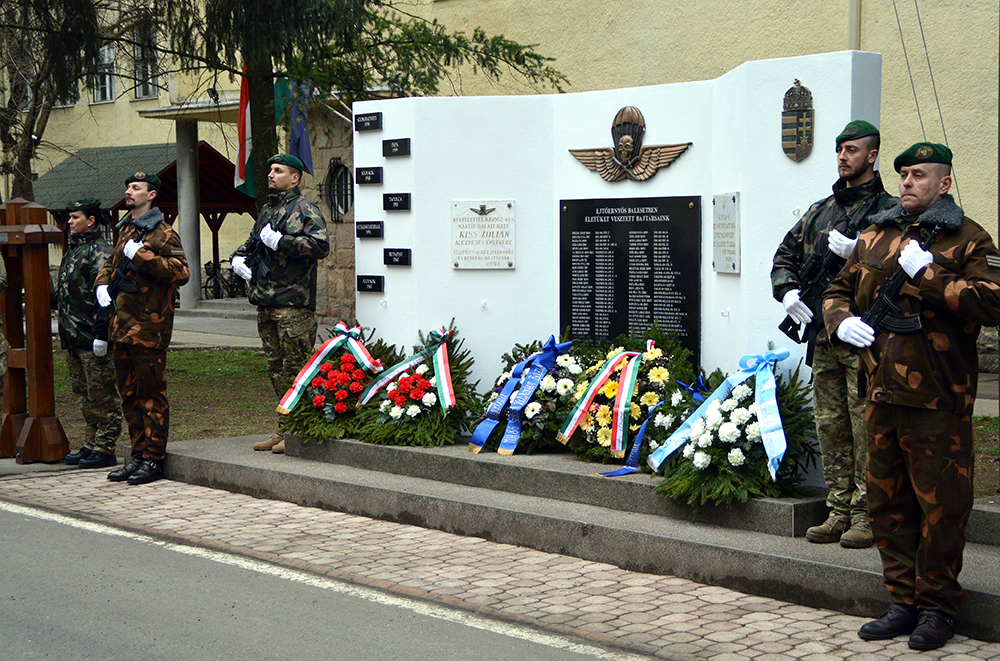 The Paratrooper Memorial Wall at Szolnok, Hungary with the 1940M Parachutist Wings on top of it
The Paratrooper Memorial Wall at Szolnok, Hungary with the 1940M Parachutist Wings on top of it
My study ends here in the hope that the Hungarian paratroopers of the Second World War would be better known and appreciated all around the world by publishing their story in English. It is impossible to incorporate every source, or to write down the whole of the truth, but as a comprehensive informative work it could serve a better understanding of a forgotten but special unit in a time when heroes started to jump from the skies.
- Kiss Dávid -
Sources:
- http://nagyhaboru.blog.hu/2017/10/27/egy_legenda_nyomaban_az_isonzo_partjan (2017-11-28)
- Dr. CSONGOR Győző: Testnevelési Szaktanfolyam (in.: Magyar Szárnyak ??? PDF)
- https://www.facebook.com/kulonlegeskutatas/posts/438881316292335 (2017-11-28)
- https://www.masodikvh.hu/erdekessegek/alakulatok/1602-a-magyar-kiralyi-honvedseg-ejternys-alakulatanak-toertenete-1938-1945 (2017-11-28)
- https://hu.wikipedia.org/wiki/Hehs_%C3%81kos (2017-11-28)
- https://www.masodikvh.hu/erdekessegek/alakulatok/3163-magyar-ejtoernyosok-a-donnal-ejtoernyos-katonak-a-m-kir-2-honvedhadsereg-kotelekeben-1942-1943 (2017-11-28)
- vitéz MAKRAY Ferenc hadnagy: Az ejtőernyős csapatok magyar szemmel nézve (in.: Magyar Katonai Szemle IX. évf. 1939. 9. sz. Budapest, 1939.)
- SZOKOLAY Tamás hadnagy: Ejtőernyőugrás, a jövő legkatonásabb sportja (in.: Magyar Katonai Szemle IX. évf. 1939. 9. sz. Budapest, 1939.)
- VADAS Mihály őrmester: A légi gyalogságról (in.: Honvéd Altiszti Folyóirat VI. évf. 1939. 9. sz. Budapest, 1939.)
- https://en.wikipedia.org/wiki/MP35 (2017-12-09 22:15)
- ÁBEL Béla Gusztáv: Göröngyös Utakon…! Vissazemlékezések
- Letter of István Pruzsina to his sister (Dated 21st of June, 1940)
http://felderitokblogja.blog.hu/2017/08/25/halalfej_szarnyak_es_ejtoernyo_az_1940m_ejtoernyos_csapatjelveny_es_utoelete (2018-01-18 16:20)
- SZOKOLAY Tamás: A Magyar ejtőernyősök lovagkora 1938 – 1941 (in.: Kanadai Magyar Szárnyak 1987. p. 56.)
- Dr. VÁNDOR Ferenc: Ejtőernyős csapatok egészségügyi szolgálata (In.: Magyar Katonai Szemle 1941/12. pp. 708 - 718.)
- RESZEGI Zsolt: Légi Huszárok Az ejtőernyős csapatnem kialakulása és harcai 1938 és 1945 között (Budapest- Pápa 2013.)
- HUSZÁR János: Honvéd ejtőernyősök Pápán 1939 – 1945 (Pápa, 1993.)
- MARTIN Kornél: Nagy Árpád ejtőernyős főhadnagy háborús jegyzetei (in.: Hadtörténelmi Közlemények 1991/1. pp. 1. – 42.)
http://felderitokblogja.blog.hu/2017/12/01/_meg_hogy_pestre_akarnak_a_budosek_bemenni_magyar_ejtoernyosok_soroksar_es_dunaharaszti_vedelmeben (2018-05-08 19:21)
Source of pictures:
- Dávid Kiss Collection
- Photos of Pál Muzslai (http://www.repulomuzeum.hu/Adomanyok/MuzslaiPal/MuzslaiPal.htm)
- Illustrations of Róbert Hadnagy
- Eriks Collectables (https://www.erikscollectables.com/2019/02/13/return-of-transylvania-to-hungary-in-1940-koloszvar-and-nagyvarad/)
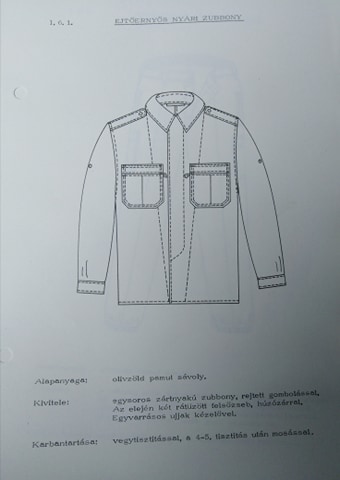
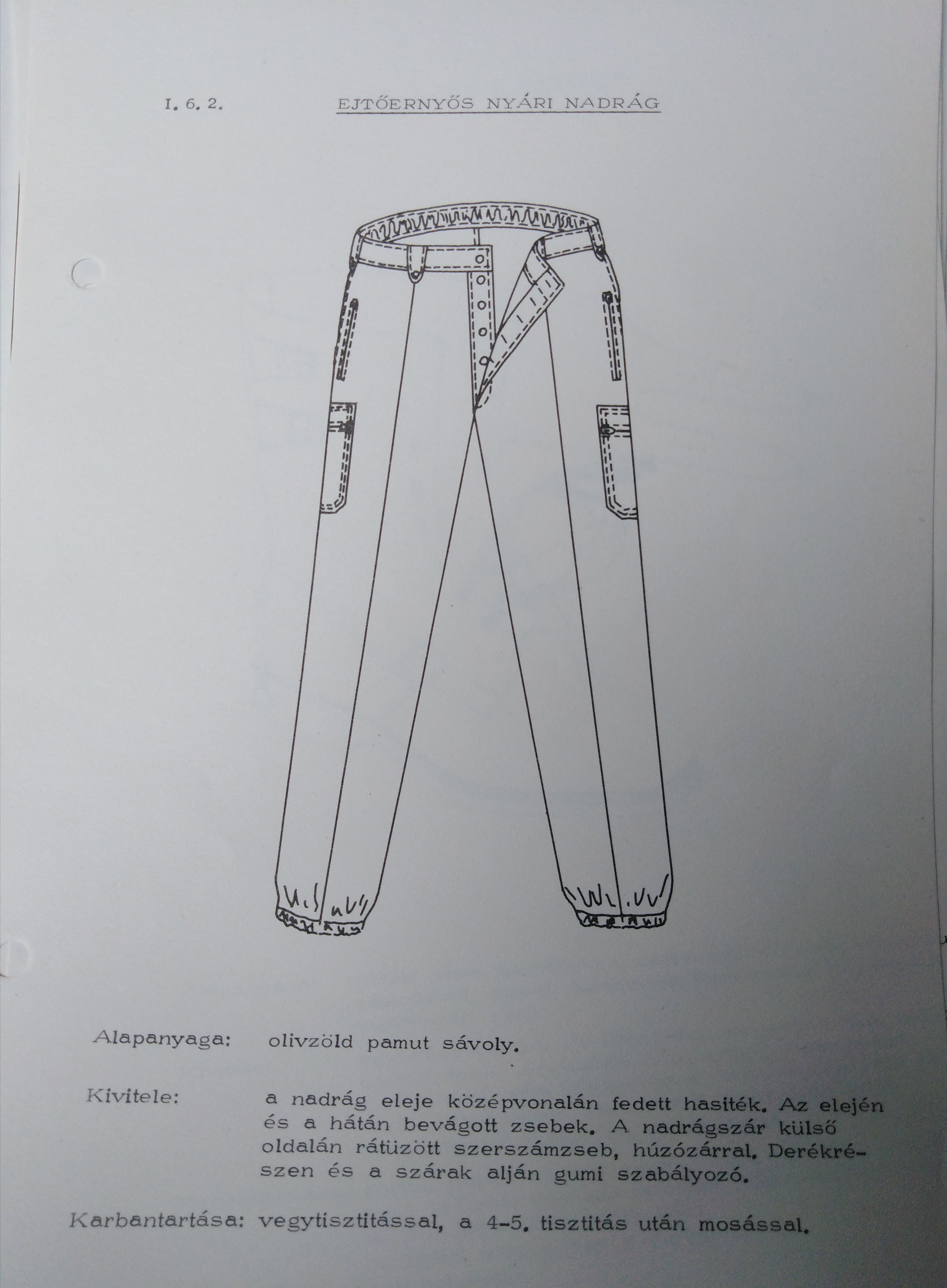
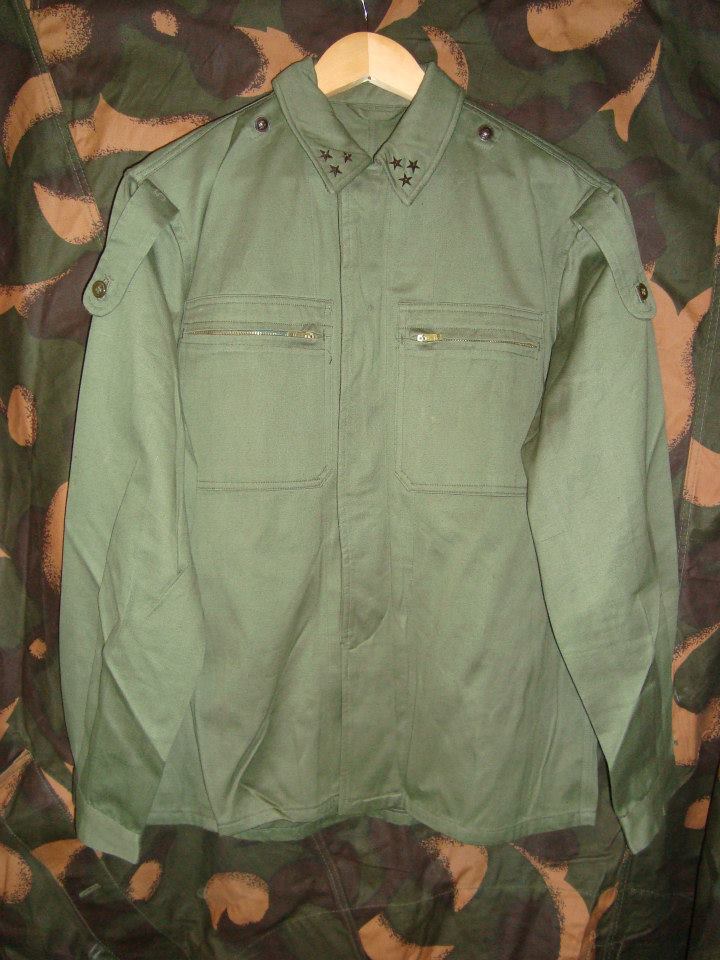 Az 1965M nyári ejtőernyős gyakorlóöltöny zubbonya barna bakelit szakaszvezetői rendfokozati jelzésekkel, réz húzózárakkal
Az 1965M nyári ejtőernyős gyakorlóöltöny zubbonya barna bakelit szakaszvezetői rendfokozati jelzésekkel, réz húzózárakkal Az 1965M nyári ejtőernyős gyakorlóöltöny nadrágja műanyag húzózárakkal
Az 1965M nyári ejtőernyős gyakorlóöltöny nadrágja műanyag húzózárakkal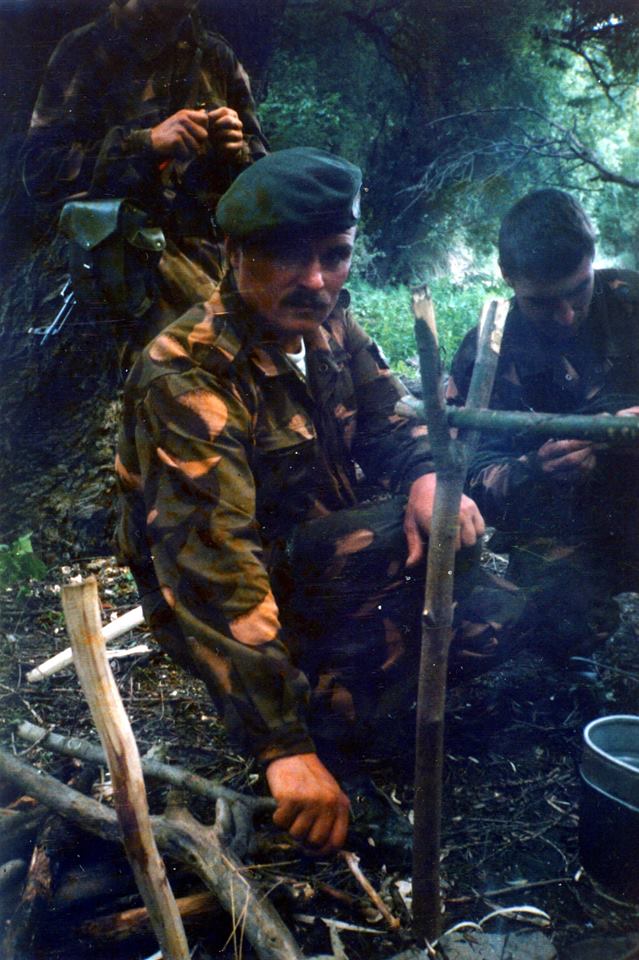 Mélységi felderítők túlélési gyakorlaton 1995-ben. Jól látható az álcaminta és a zöld háttér kontrasztja (Kiss Buda Tamás felvétele)
Mélységi felderítők túlélési gyakorlaton 1995-ben. Jól látható az álcaminta és a zöld háttér kontrasztja (Kiss Buda Tamás felvétele)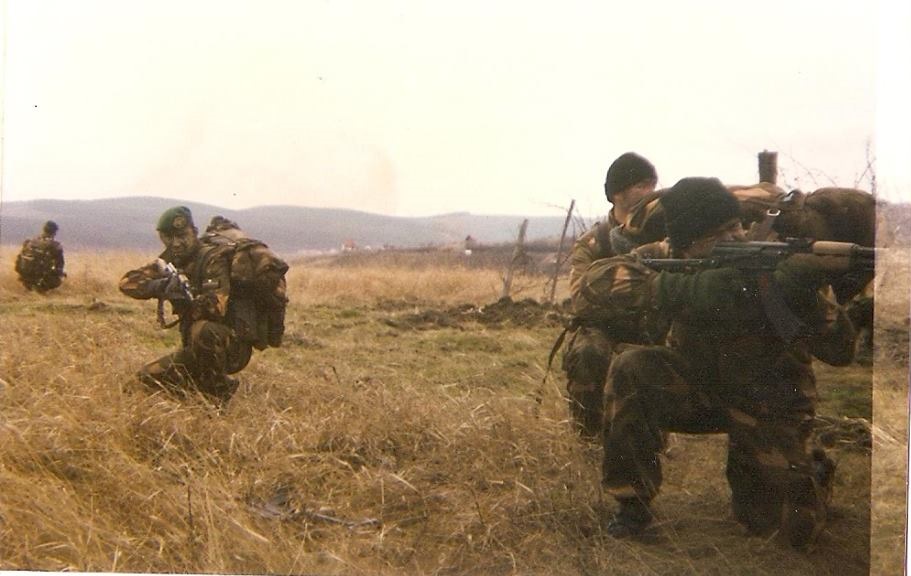 Menetgyakorlat 1997-ben. Az álcaminta itt már jobban érvényesül. (Tahoczki András felvétele)
Menetgyakorlat 1997-ben. Az álcaminta itt már jobban érvényesül. (Tahoczki András felvétele)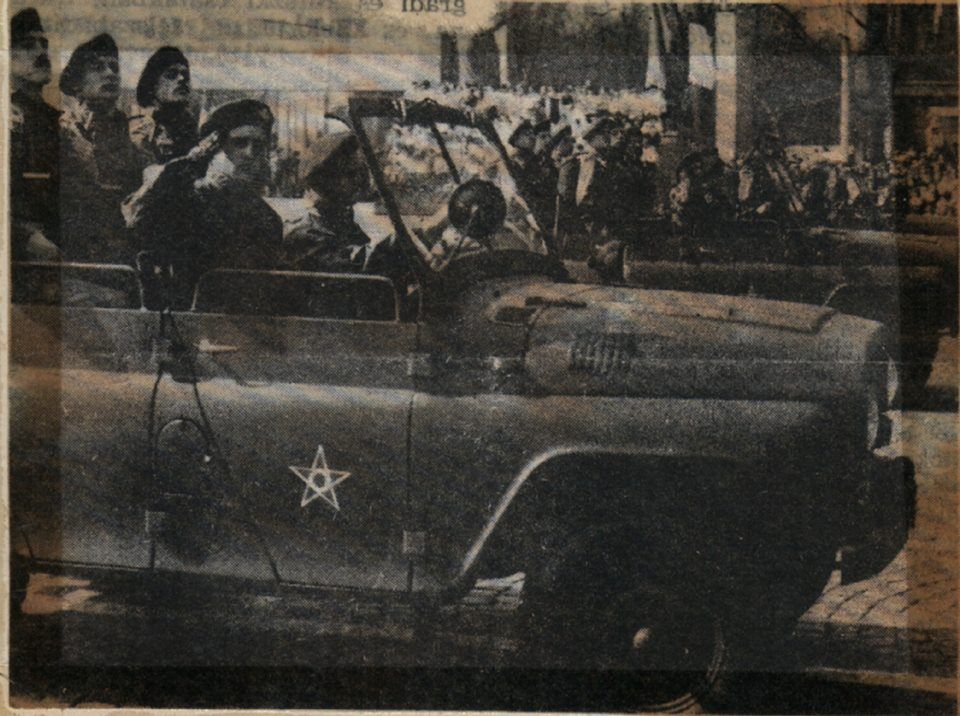 Mélységi felderítő katonák az 1985-ös díszszemlén
Mélységi felderítő katonák az 1985-ös díszszemlén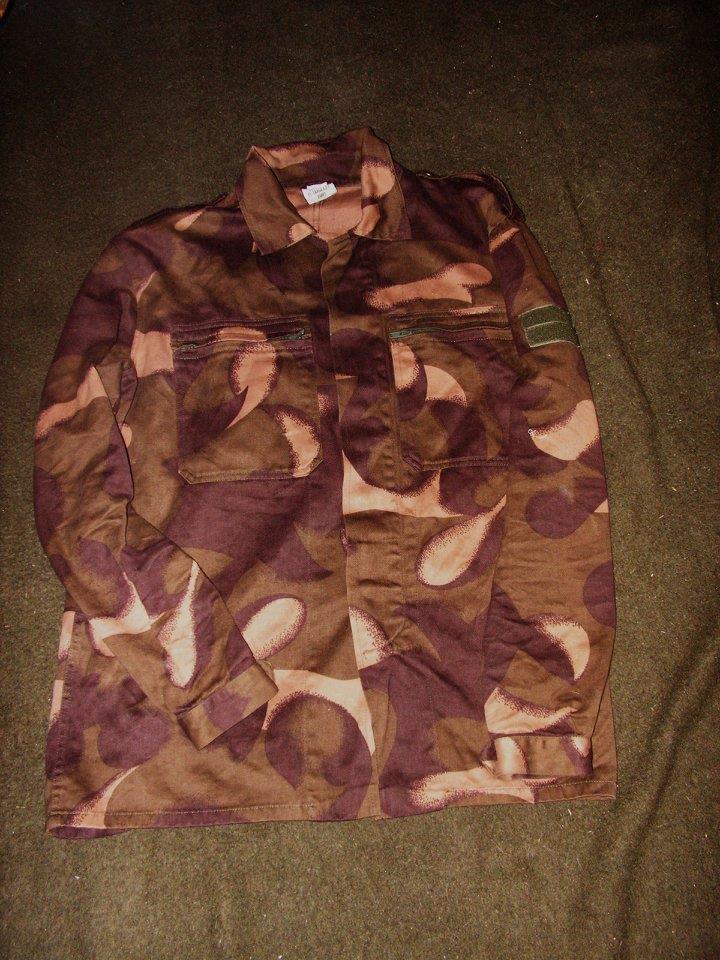 1987M ejtőernyős nyári gyakorlózubbony
1987M ejtőernyős nyári gyakorlózubbony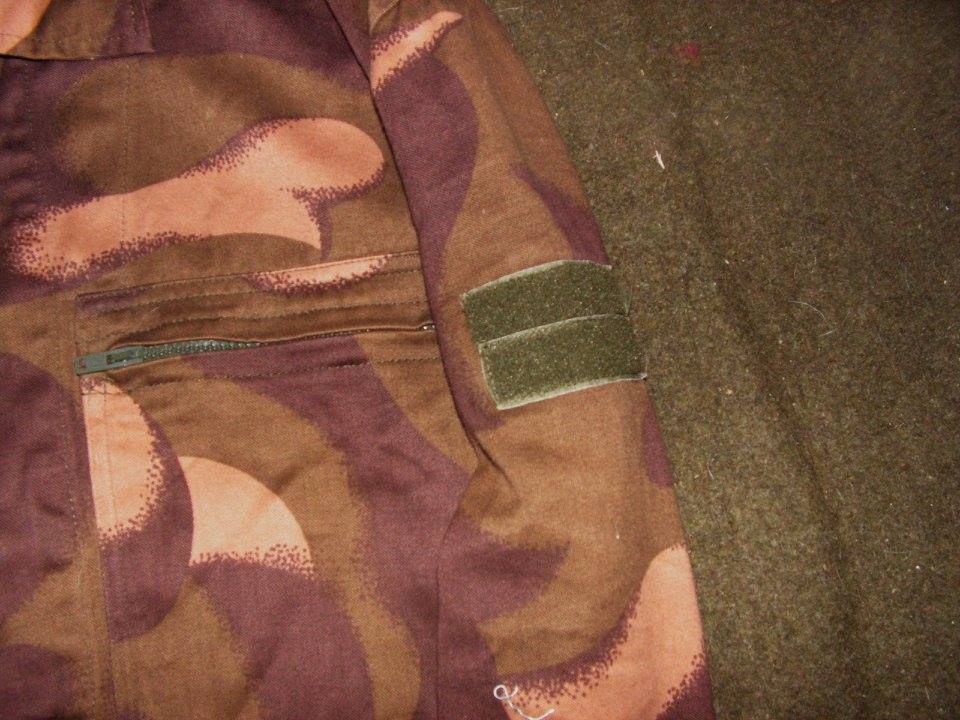 Az 1987M ejtőernyős nyári gyakorlózubbony tépőzáras rendfokozati jelzésének helye
Az 1987M ejtőernyős nyári gyakorlózubbony tépőzáras rendfokozati jelzésének helye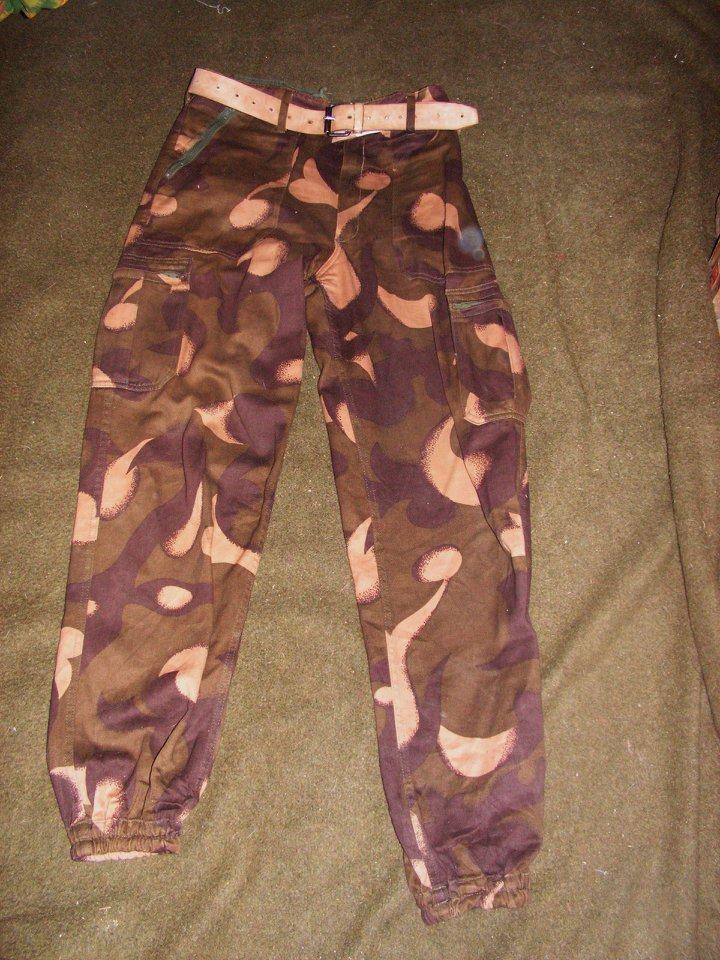 1987M ejtőernyős nyári gyakorlónadrág
1987M ejtőernyős nyári gyakorlónadrág Az 1987M ejtőernyős nyári gyakorlónadrág húzózáras combzsebe
Az 1987M ejtőernyős nyári gyakorlónadrág húzózáras combzsebe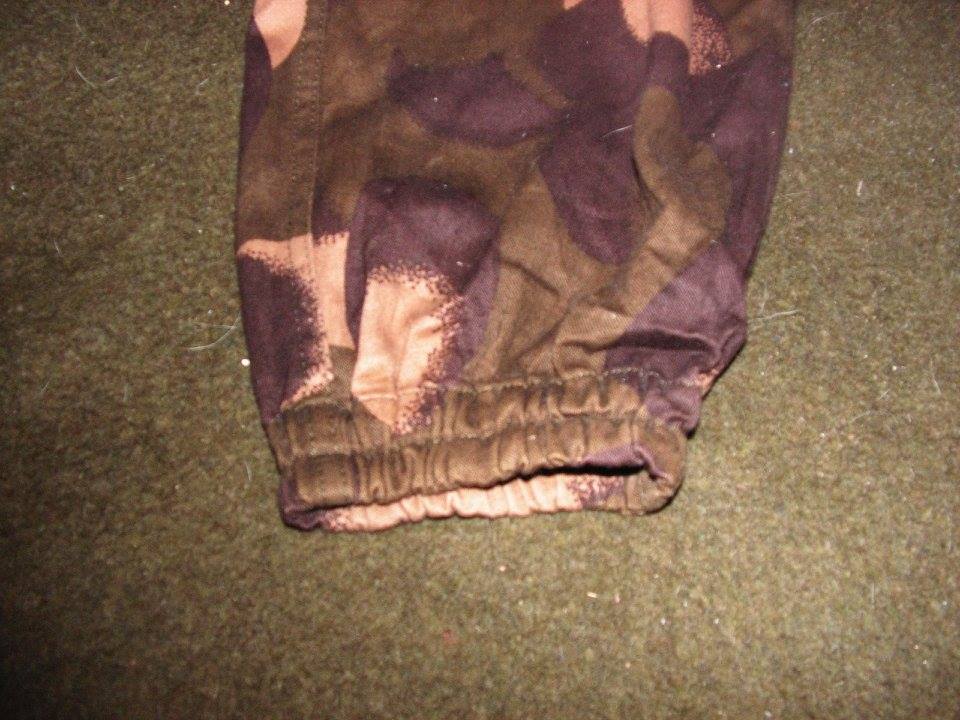 Az 1987M ejtőernyős nyári gyakorlónadrág gumis szára
Az 1987M ejtőernyős nyári gyakorlónadrág gumis szára
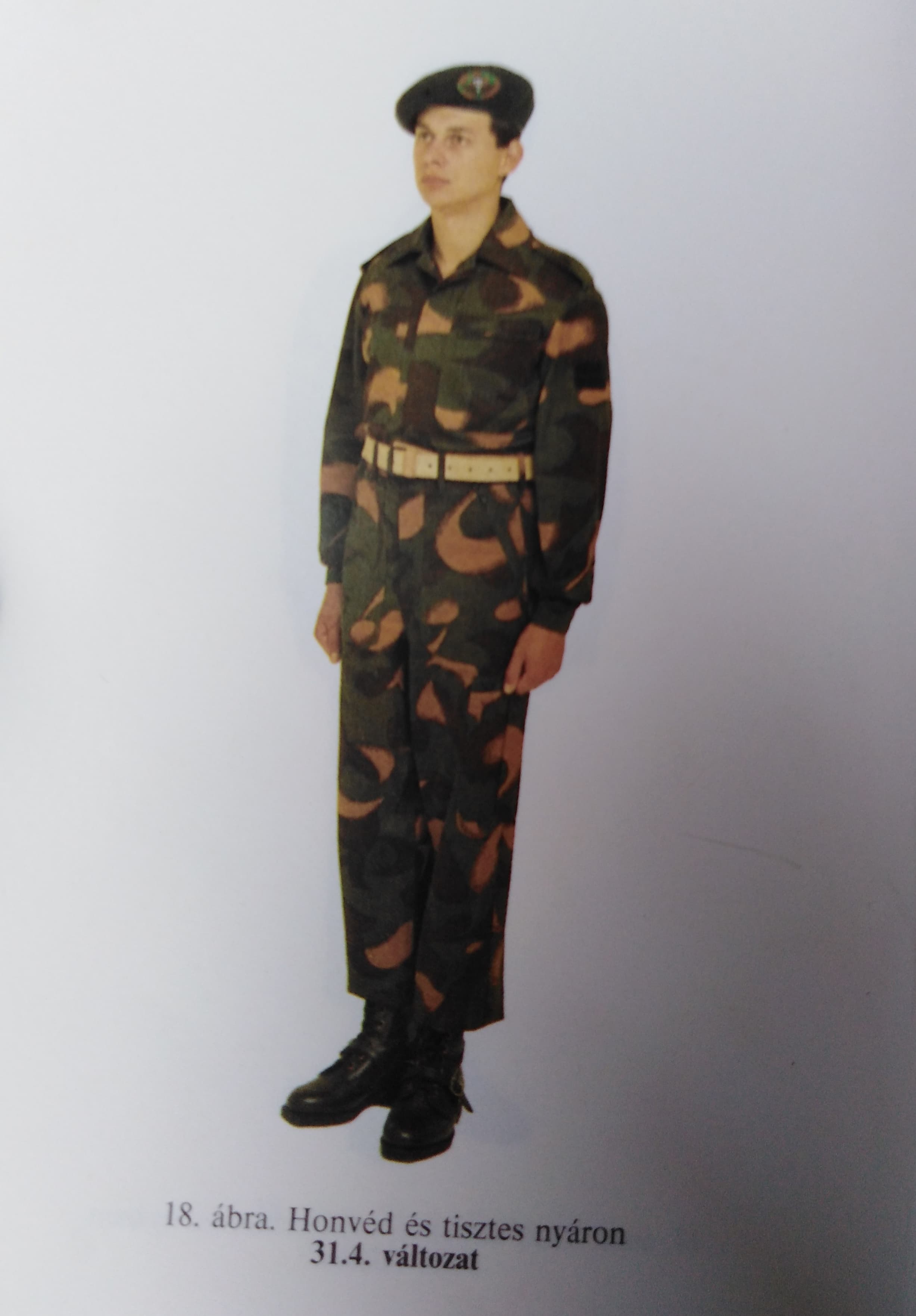
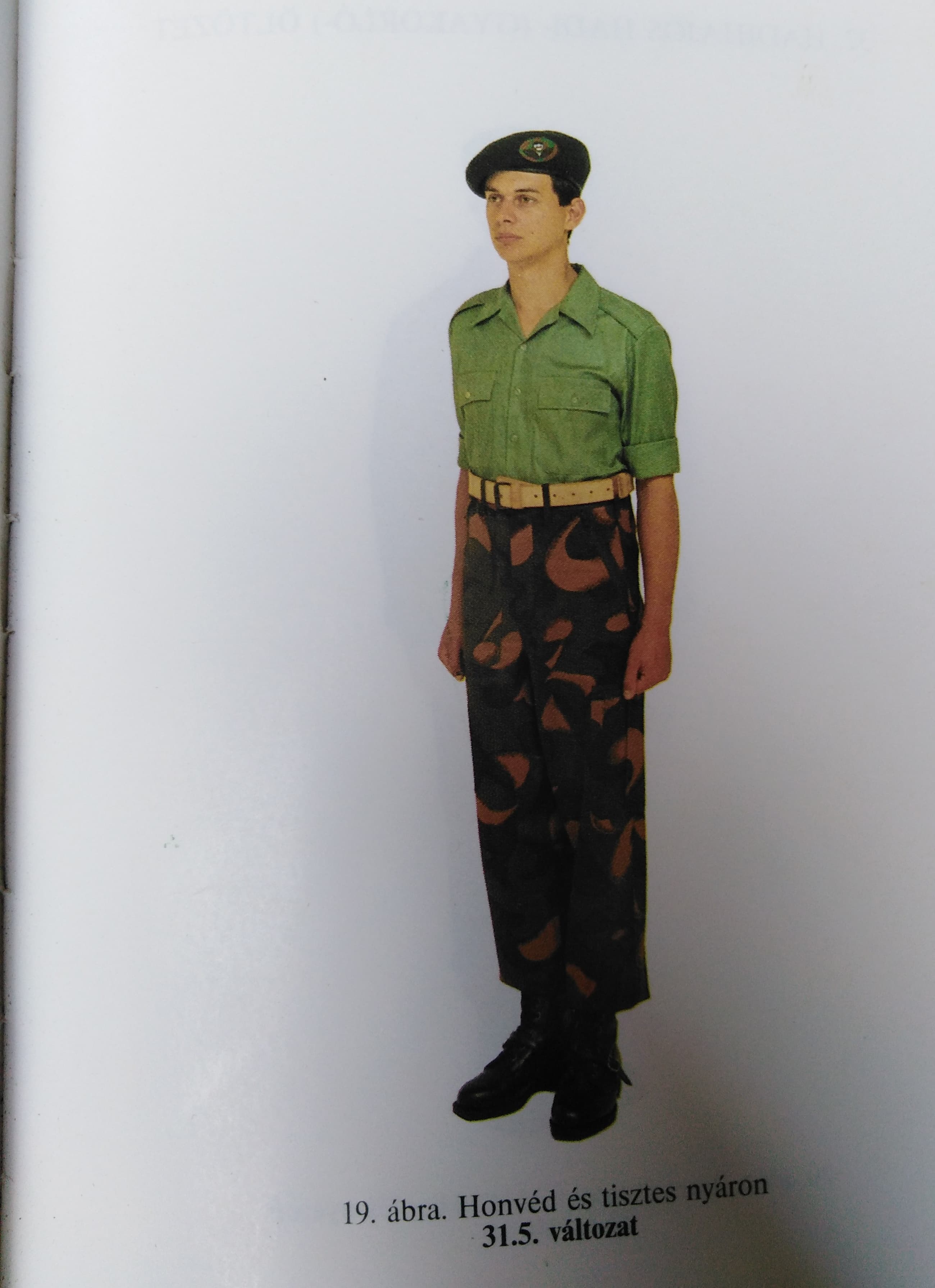
 Magyar mélységi felderítő katona nem rendszeresített „Special Force Hungary” feliratú pólóban (Krancziczki György felvétele)
Magyar mélységi felderítő katona nem rendszeresített „Special Force Hungary” feliratú pólóban (Krancziczki György felvétele) „Flottillások” kék színű 1987M hadihajós gyakorló egyenruhában (Máté József felvétele)
„Flottillások” kék színű 1987M hadihajós gyakorló egyenruhában (Máté József felvétele)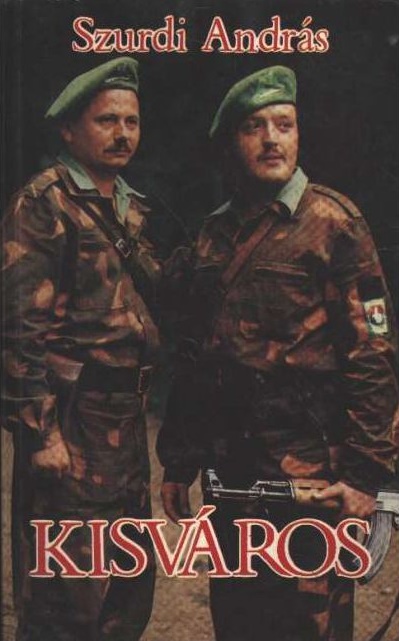 Az ország kedvenc határőrei
Az ország kedvenc határőrei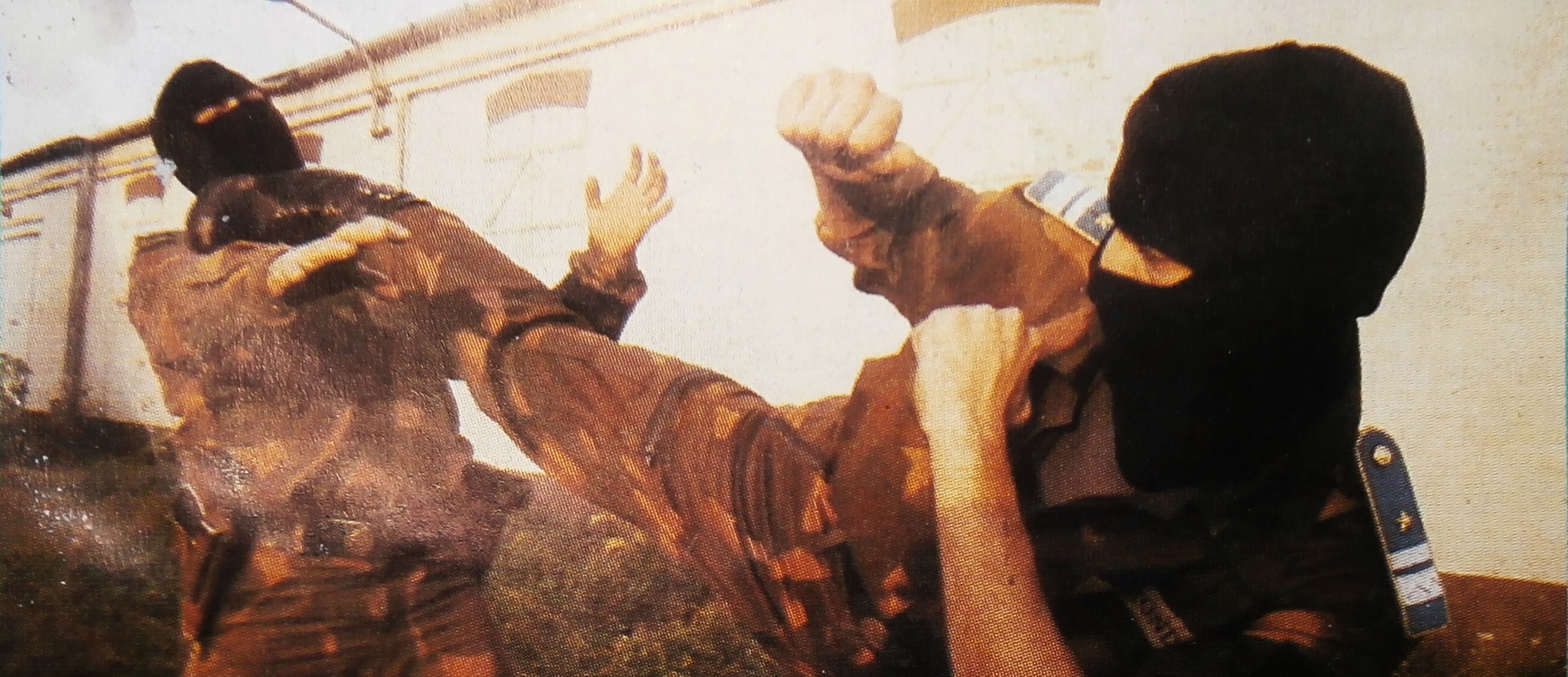
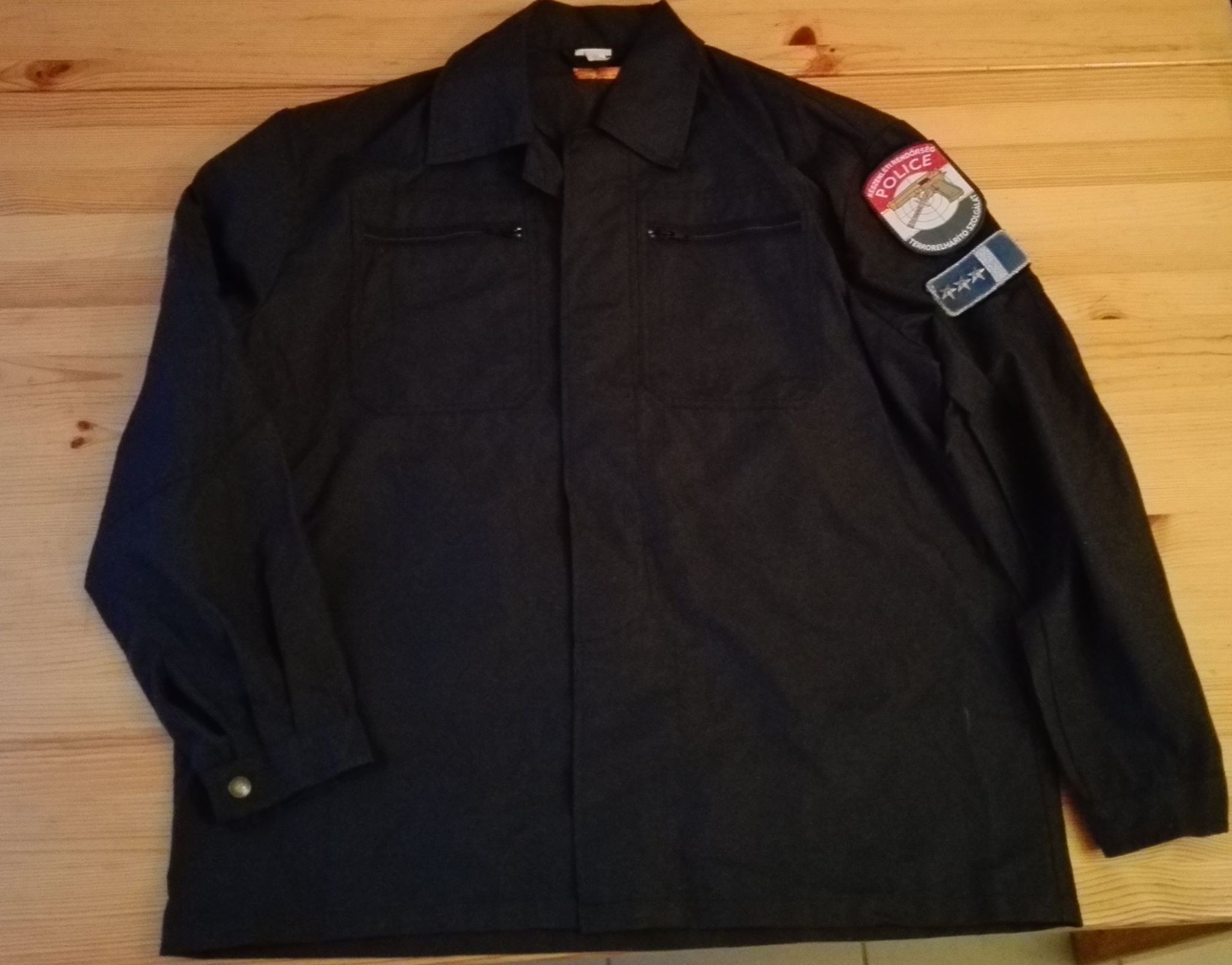

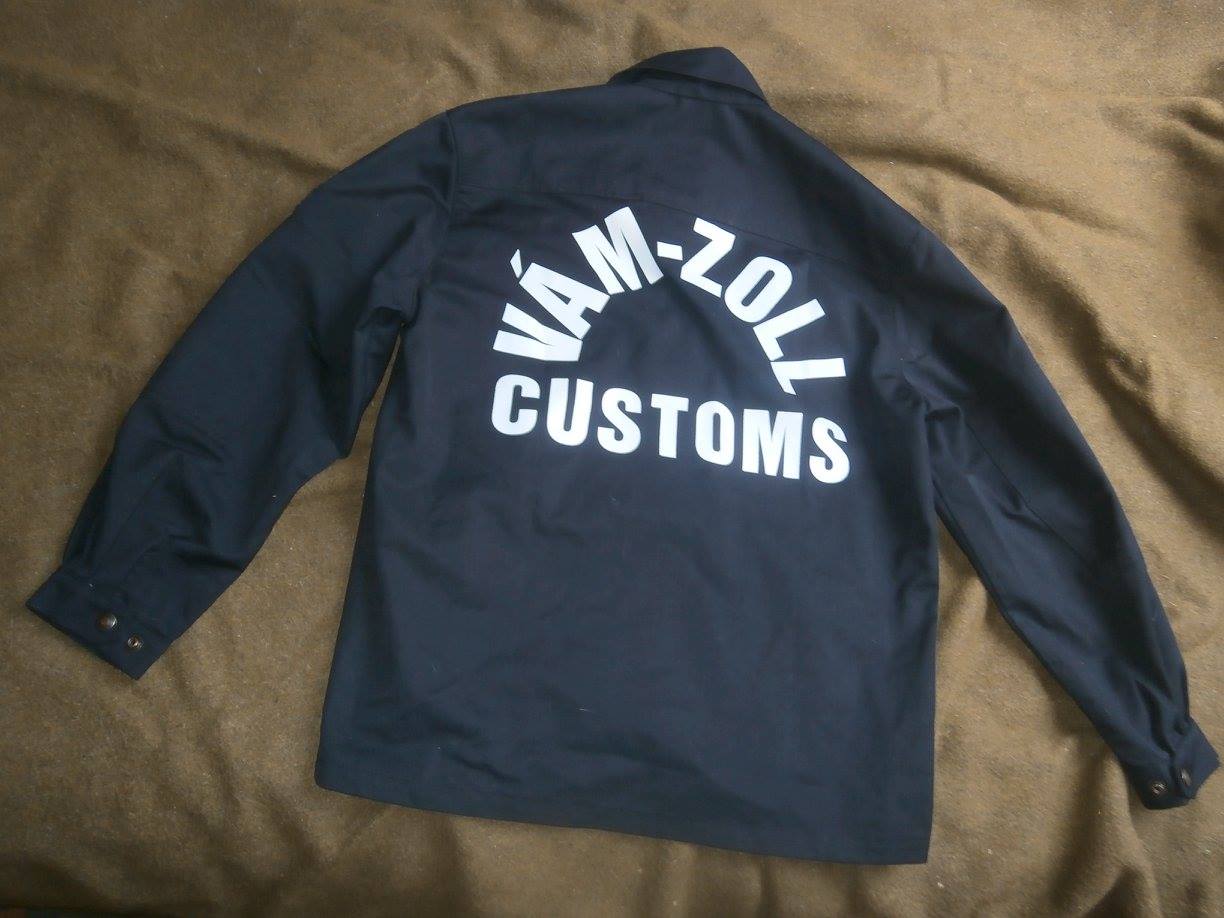
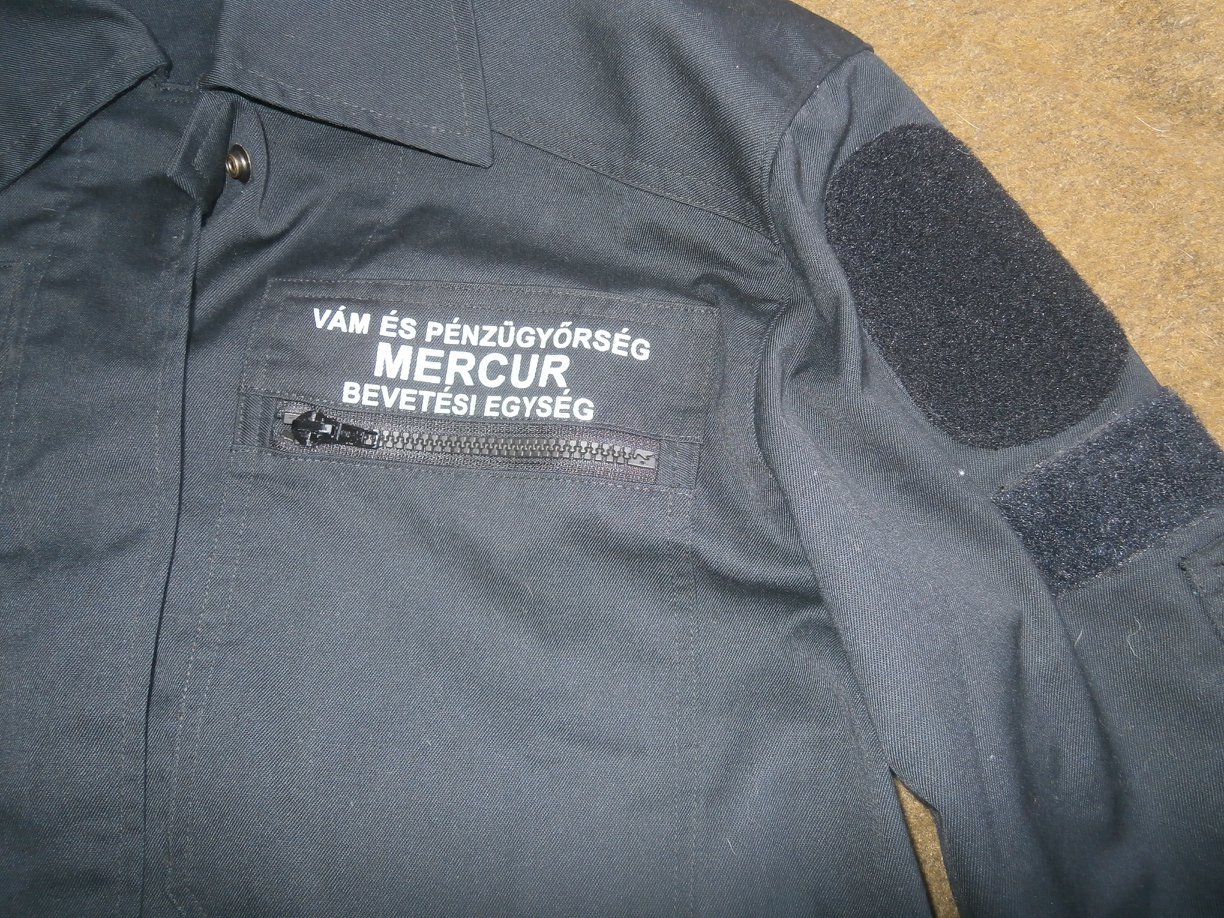
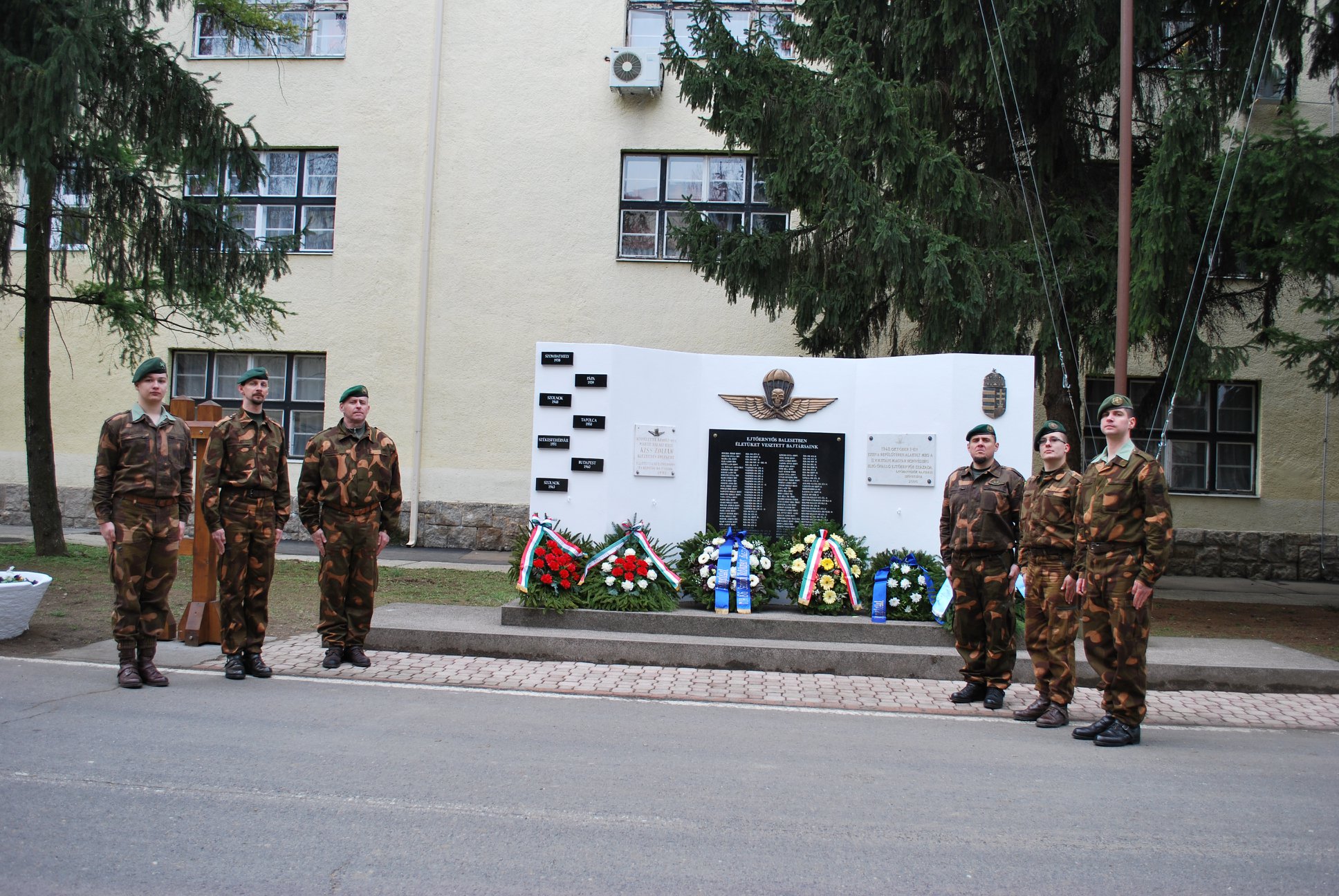 Baráti Körünk hagyományőrzői 1987M ejtőernyős gyakorlóöltönyben Szolnokon, az Ejtőernyős Emlékfalnál 2018. március 23-án, a száz éves magyar katonai ejtőernyőzés emléknapján.
Baráti Körünk hagyományőrzői 1987M ejtőernyős gyakorlóöltönyben Szolnokon, az Ejtőernyős Emlékfalnál 2018. március 23-án, a száz éves magyar katonai ejtőernyőzés emléknapján.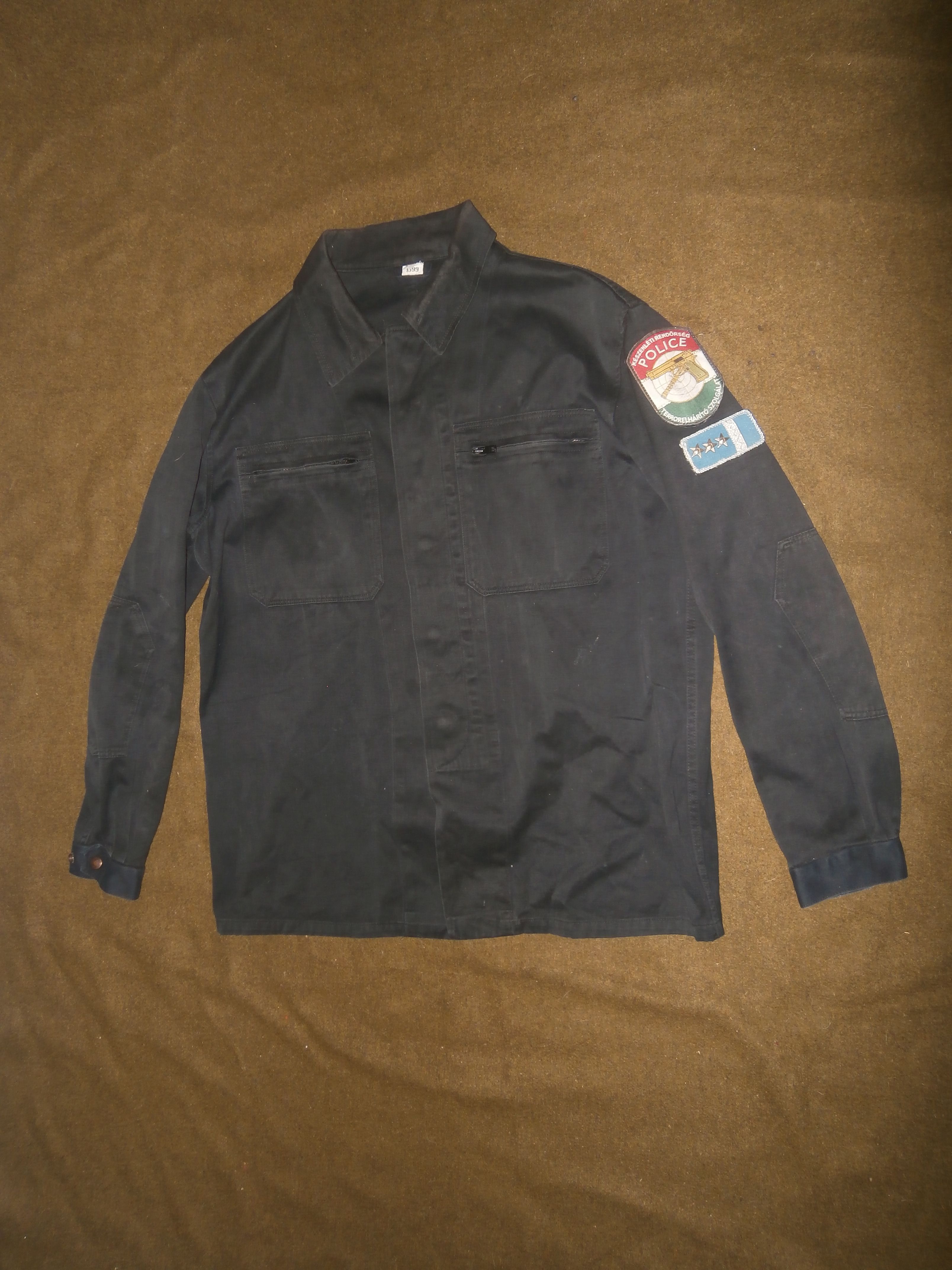
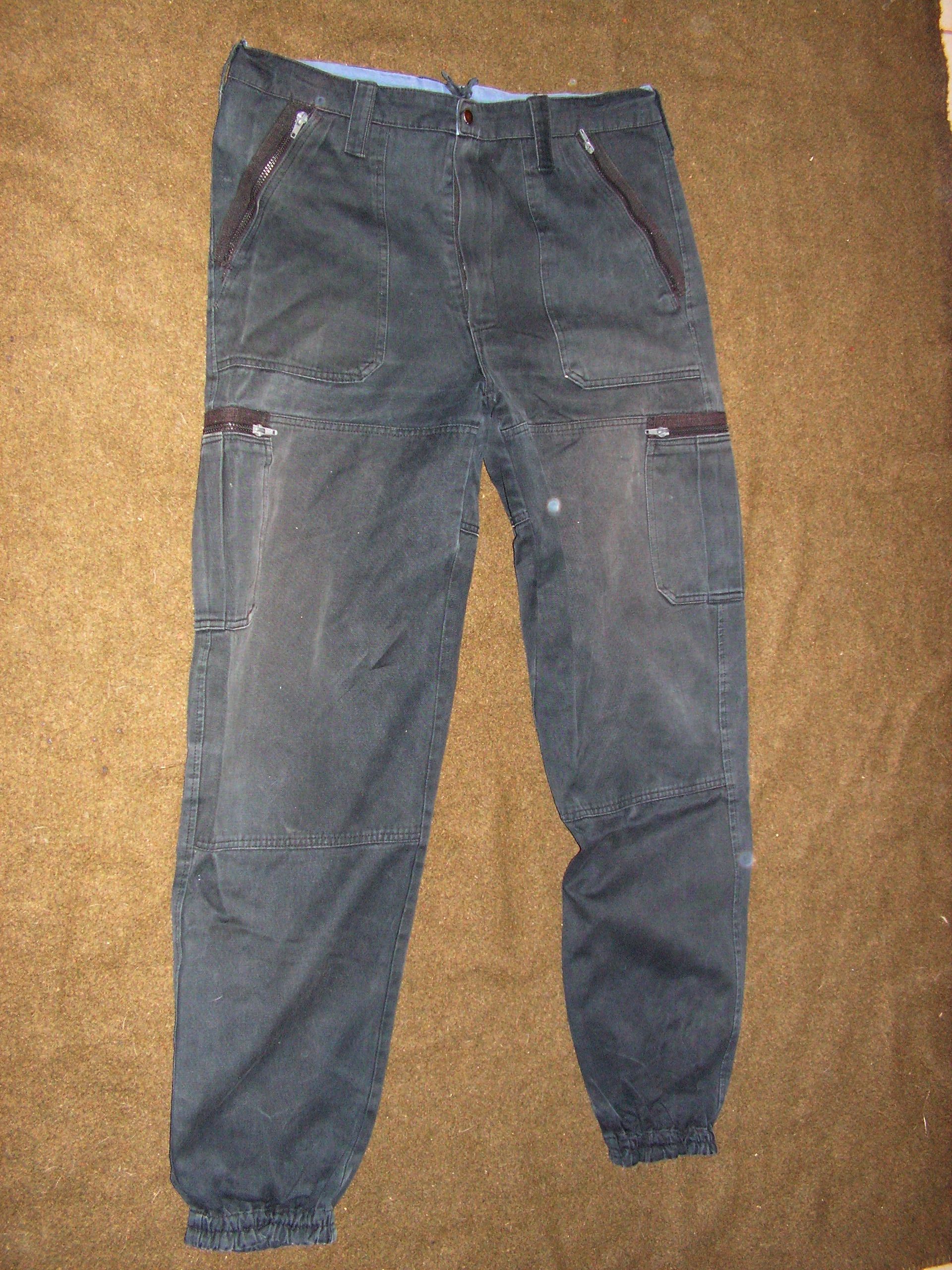
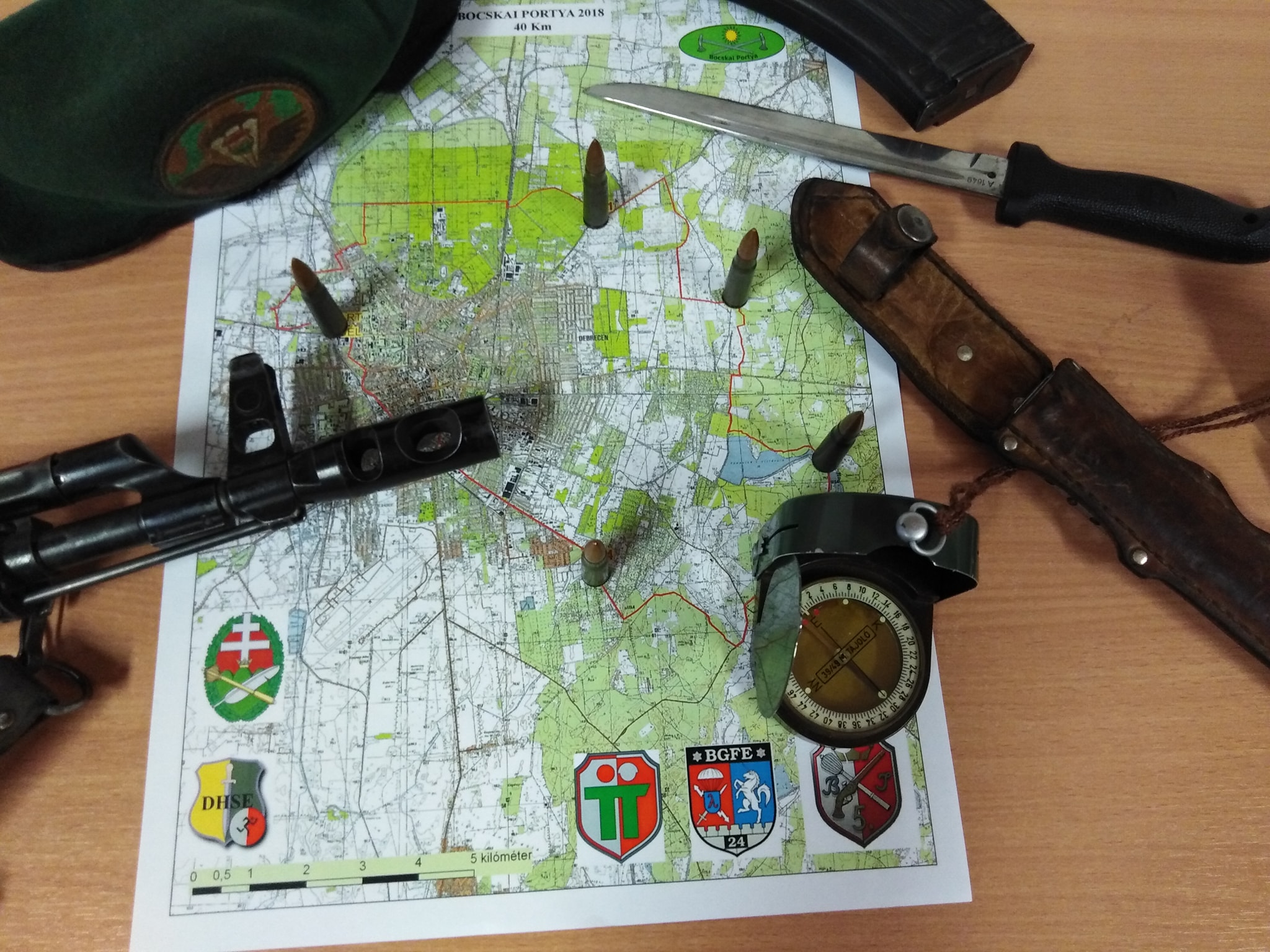 Csendélet portya előtt - hatástalan eszközökkel
Csendélet portya előtt - hatástalan eszközökkel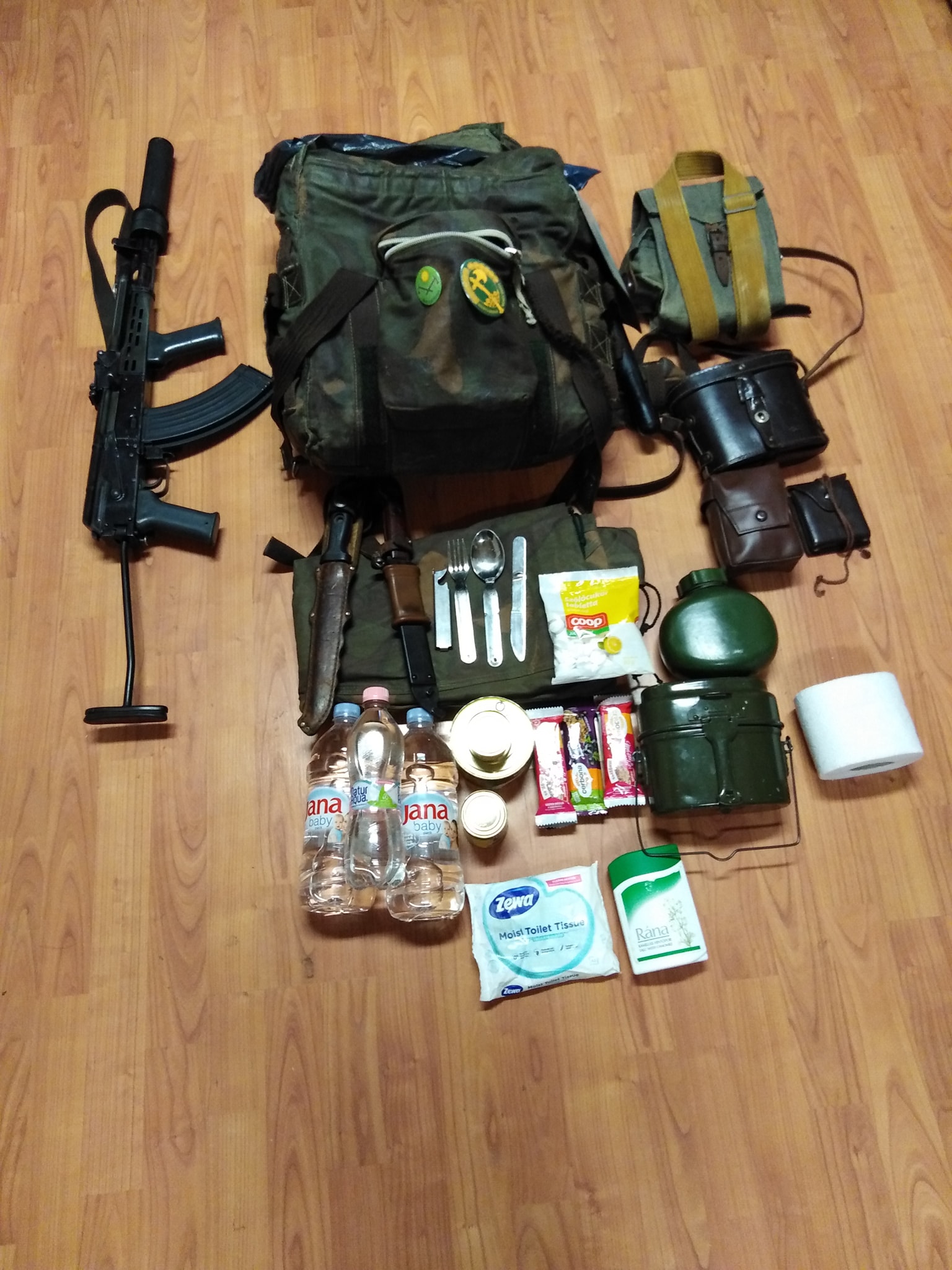 Túrafelszerelés ellenőrzése
Túrafelszerelés ellenőrzése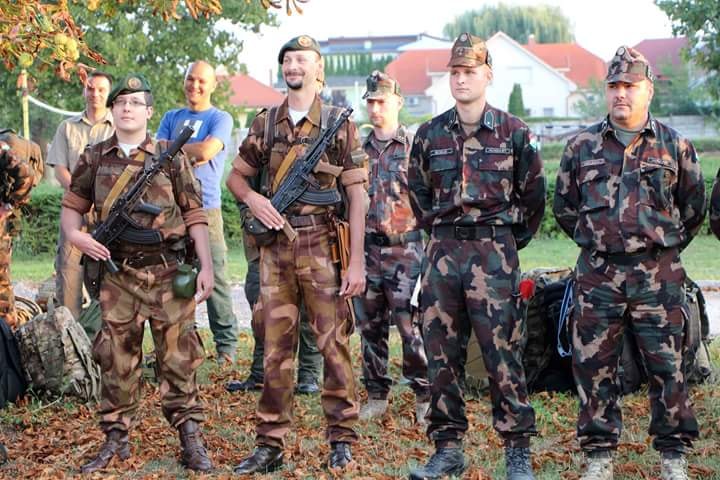 Baráti Körünk "portyázó" állománya a megnyitóbeszéd alatt
Baráti Körünk "portyázó" állománya a megnyitóbeszéd alatt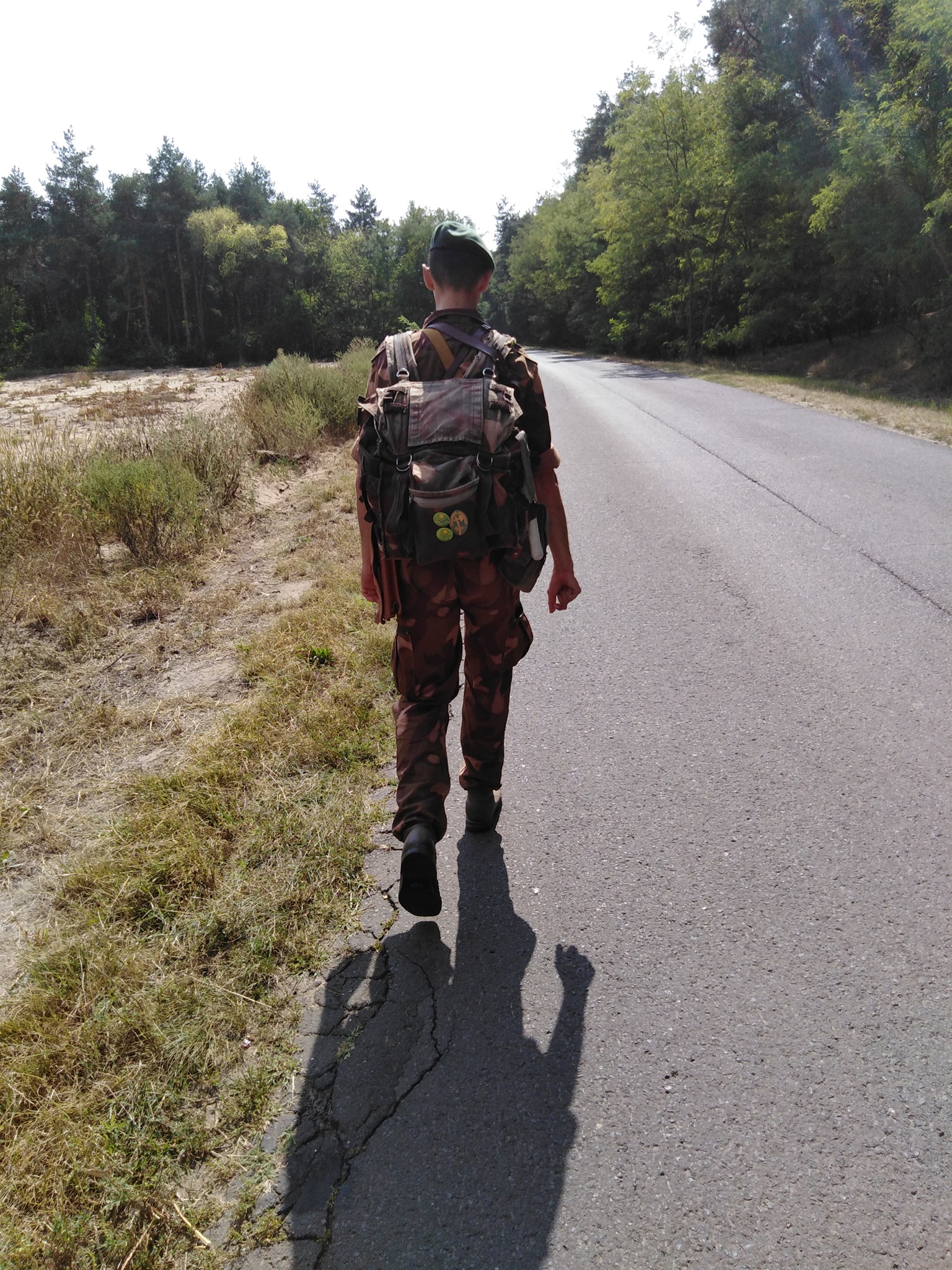 Pontról - pontra haladunk
Pontról - pontra haladunk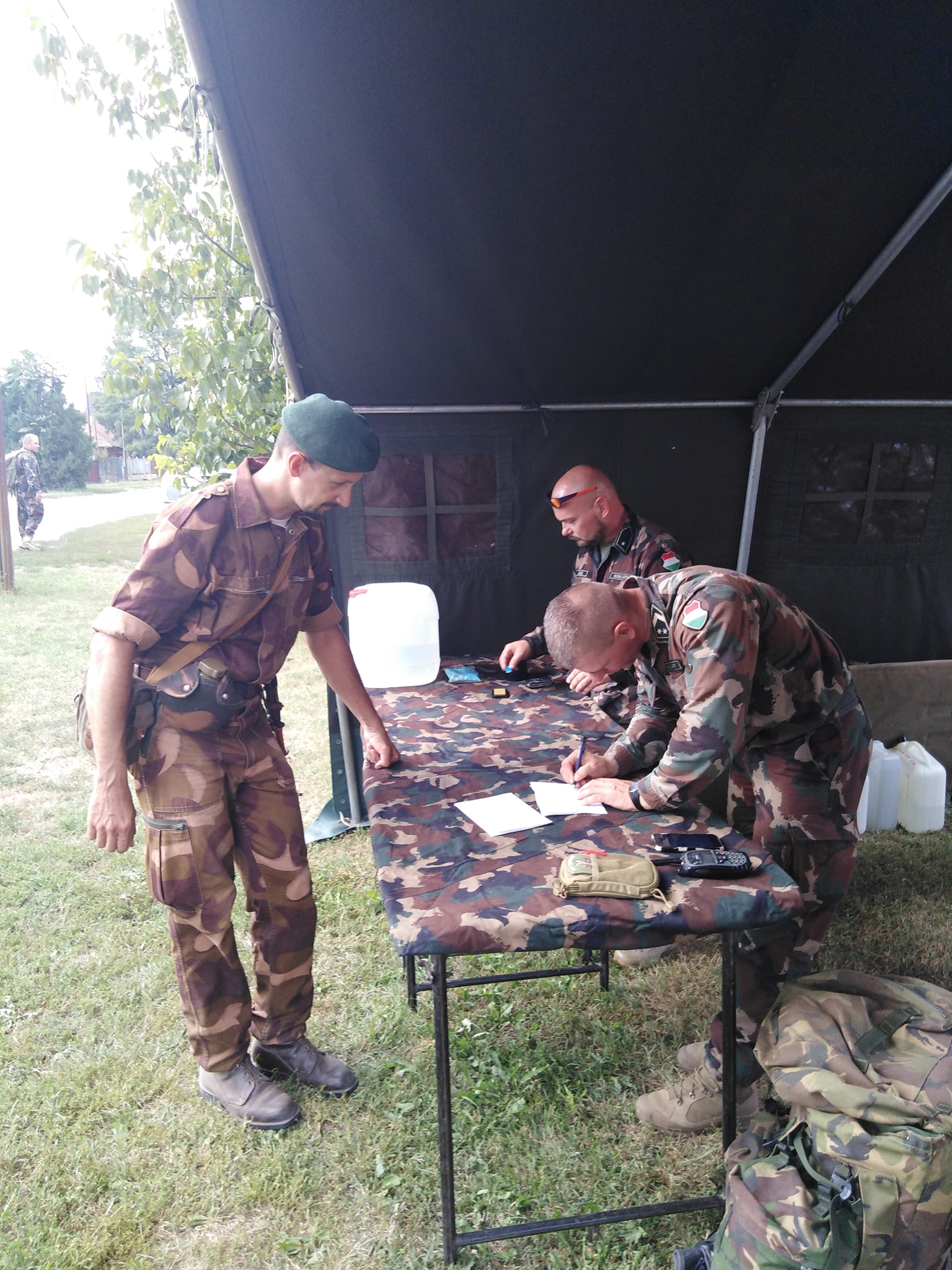 Az utolsó ellenőrzőpont a cél előtt
Az utolsó ellenőrzőpont a cél előtt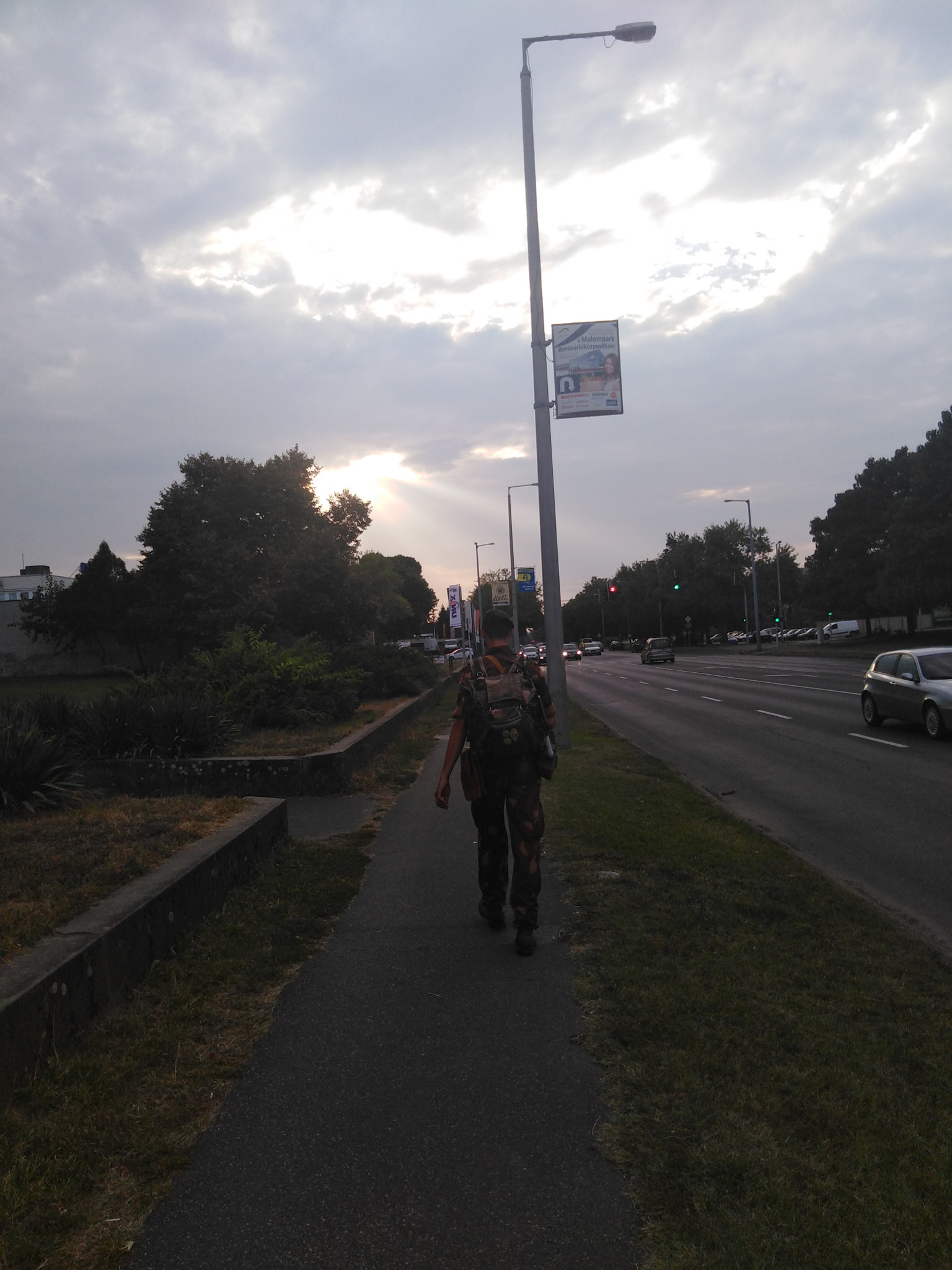 Már Debrecenben - a felhők fölött mindig süt a Nap!
Már Debrecenben - a felhők fölött mindig süt a Nap!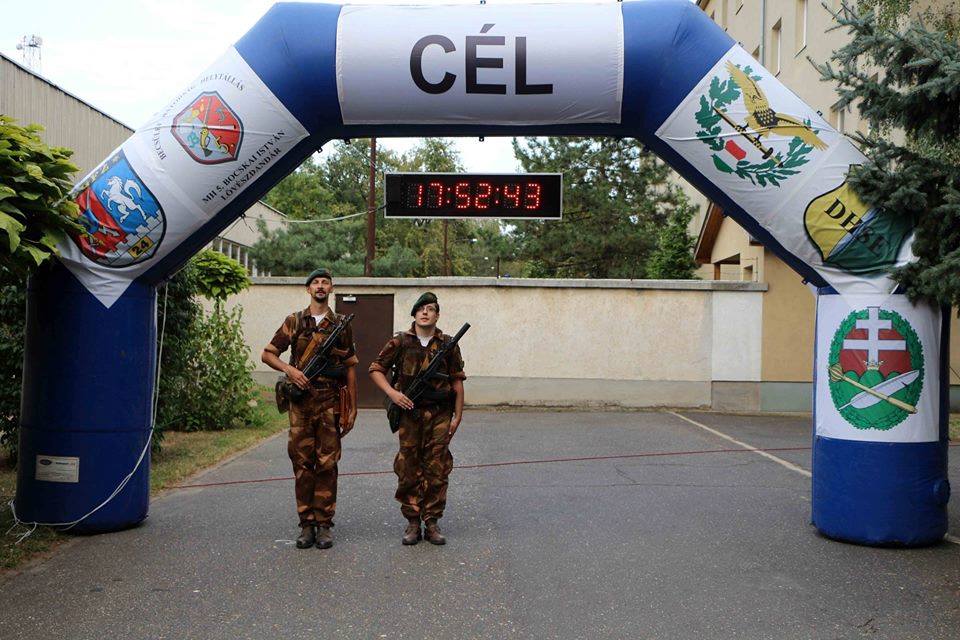 Célba érés után, rántott hús előtt
Célba érés után, rántott hús előtt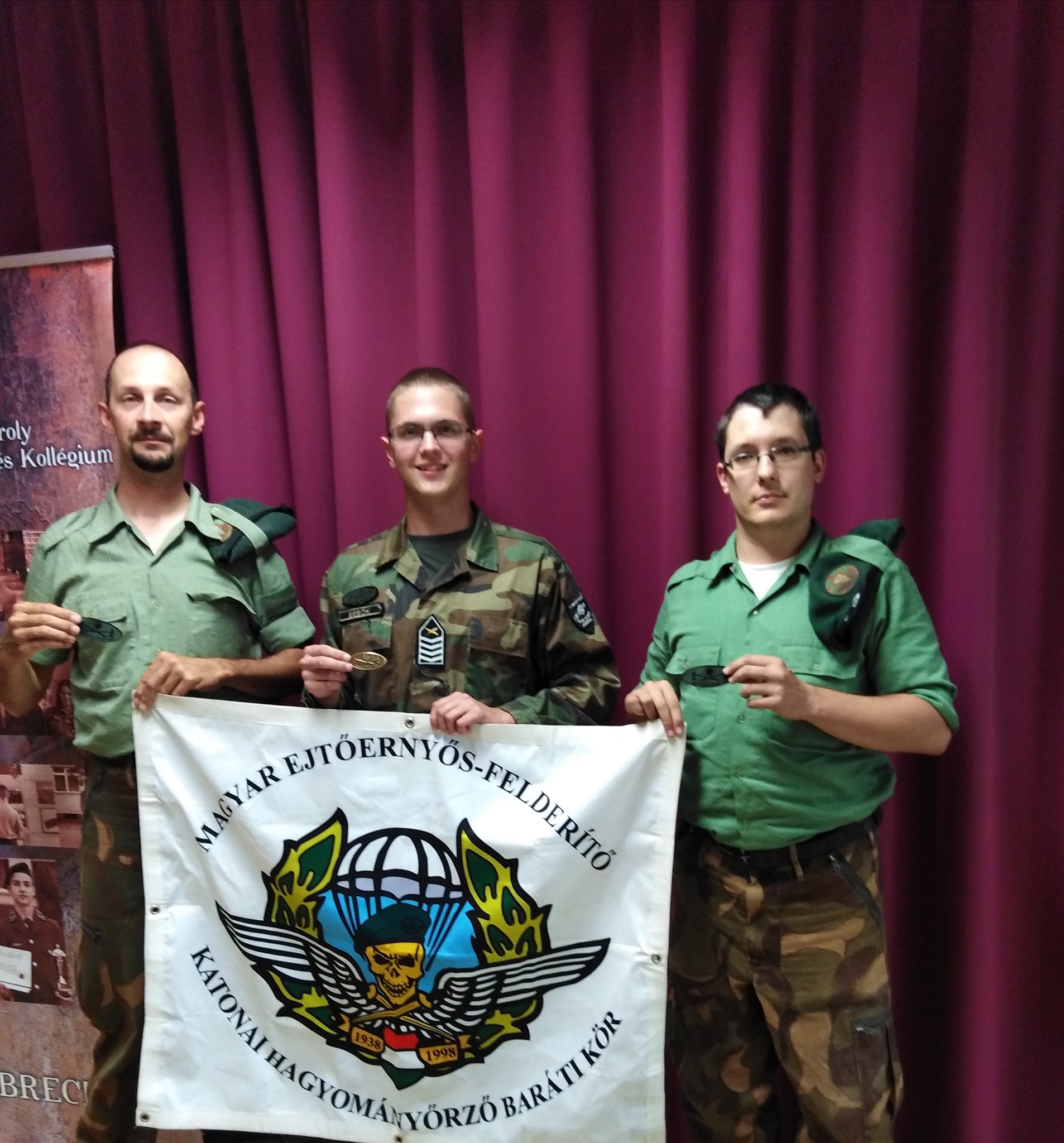 Közös kép Bebők Bence növendékkel és a kiérdemelt túrajelvényekkel
Közös kép Bebők Bence növendékkel és a kiérdemelt túrajelvényekkel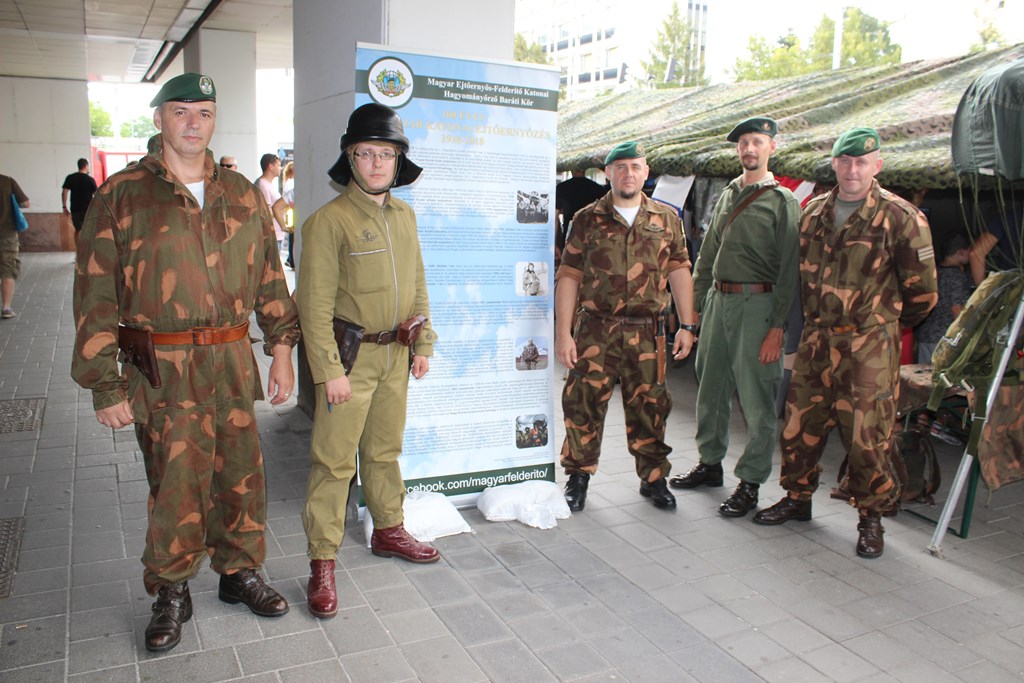 Baráti Körünk hagyományőrzői a száz éves magyar katonai ejtőernyőzés történetét bemutató tablónk előtt
Baráti Körünk hagyományőrzői a száz éves magyar katonai ejtőernyőzés történetét bemutató tablónk előtt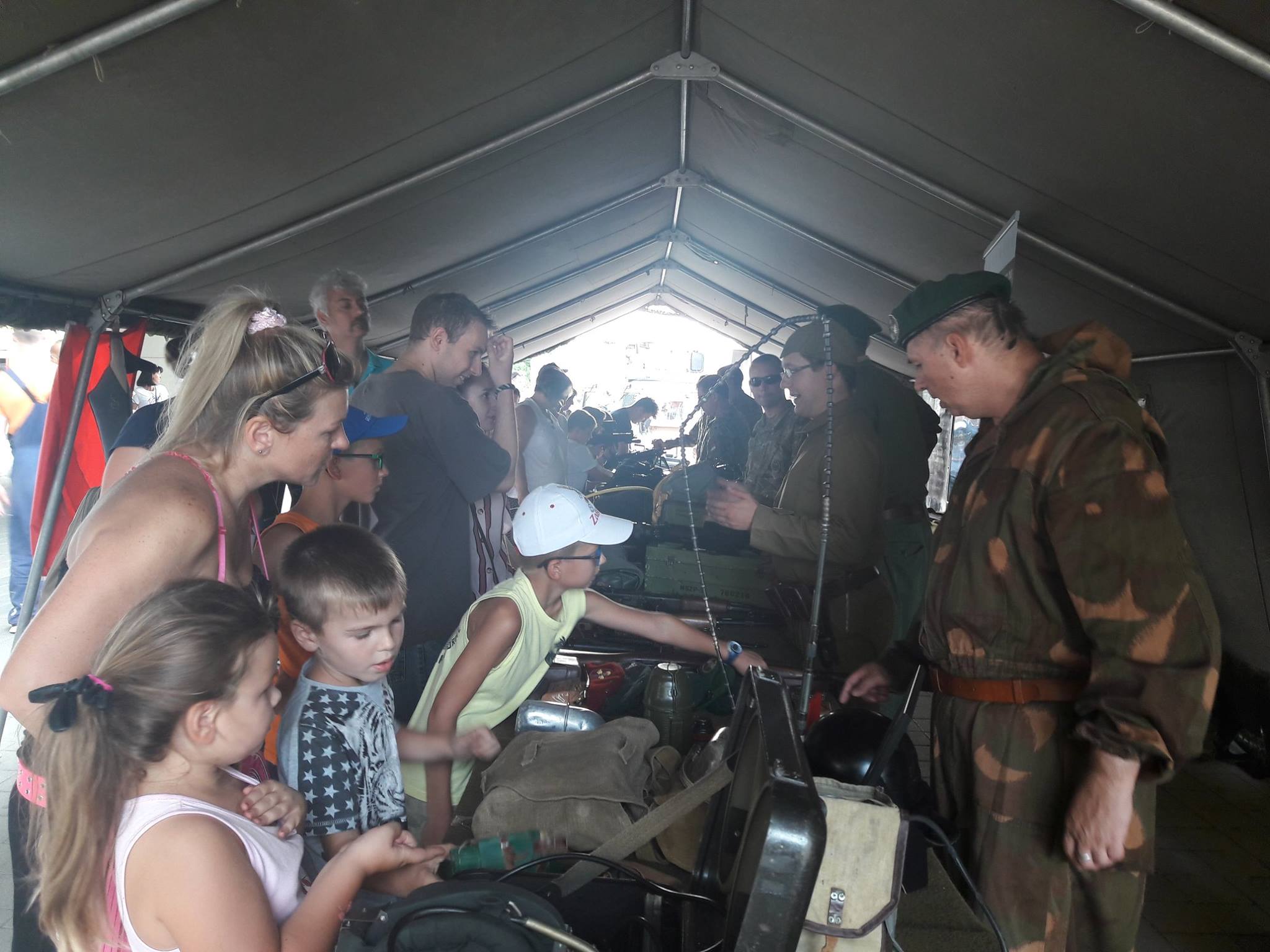 Látogatók rohama
Látogatók rohama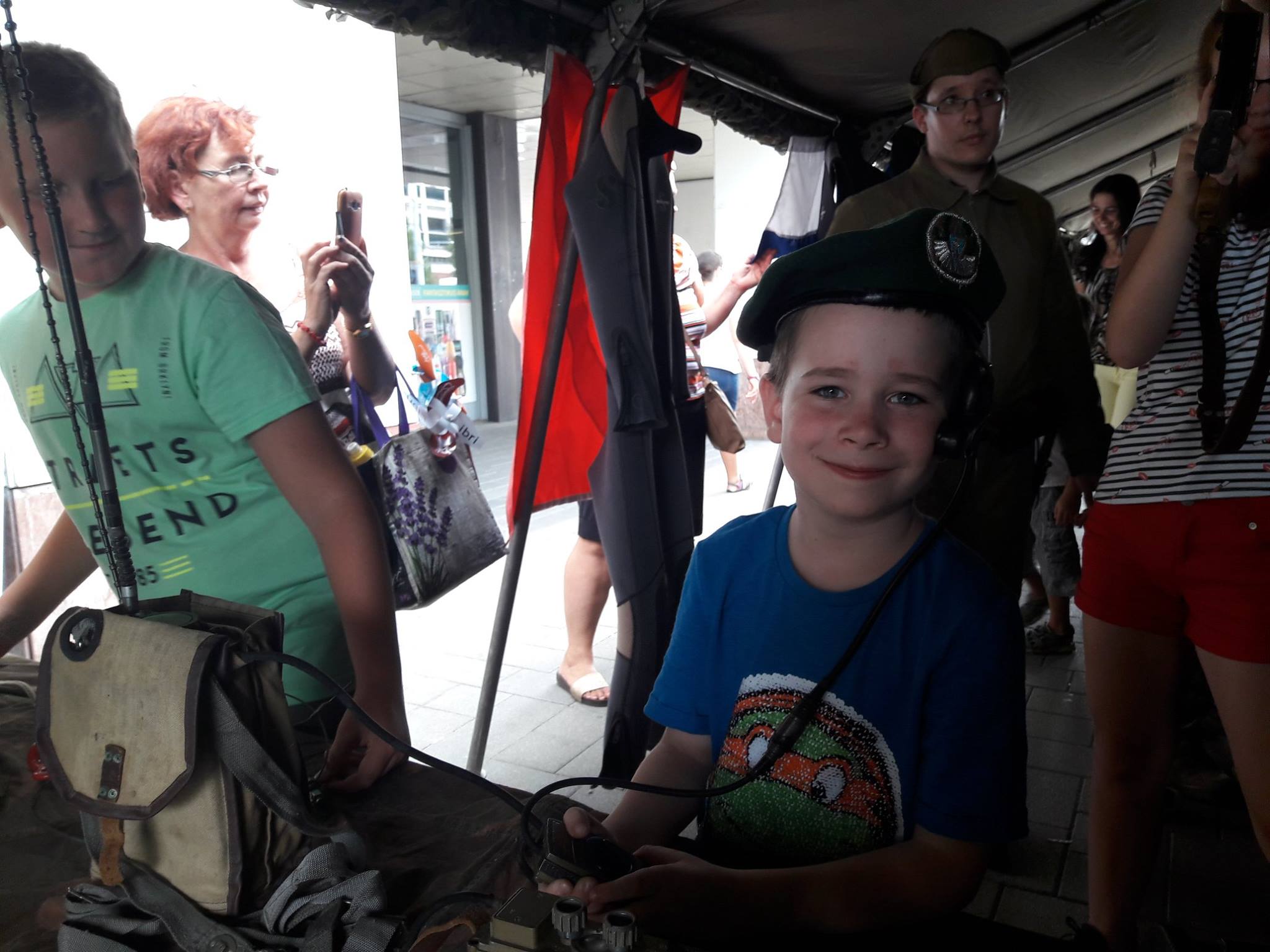 Fiatal "rádiós" zöld barettben
Fiatal "rádiós" zöld barettben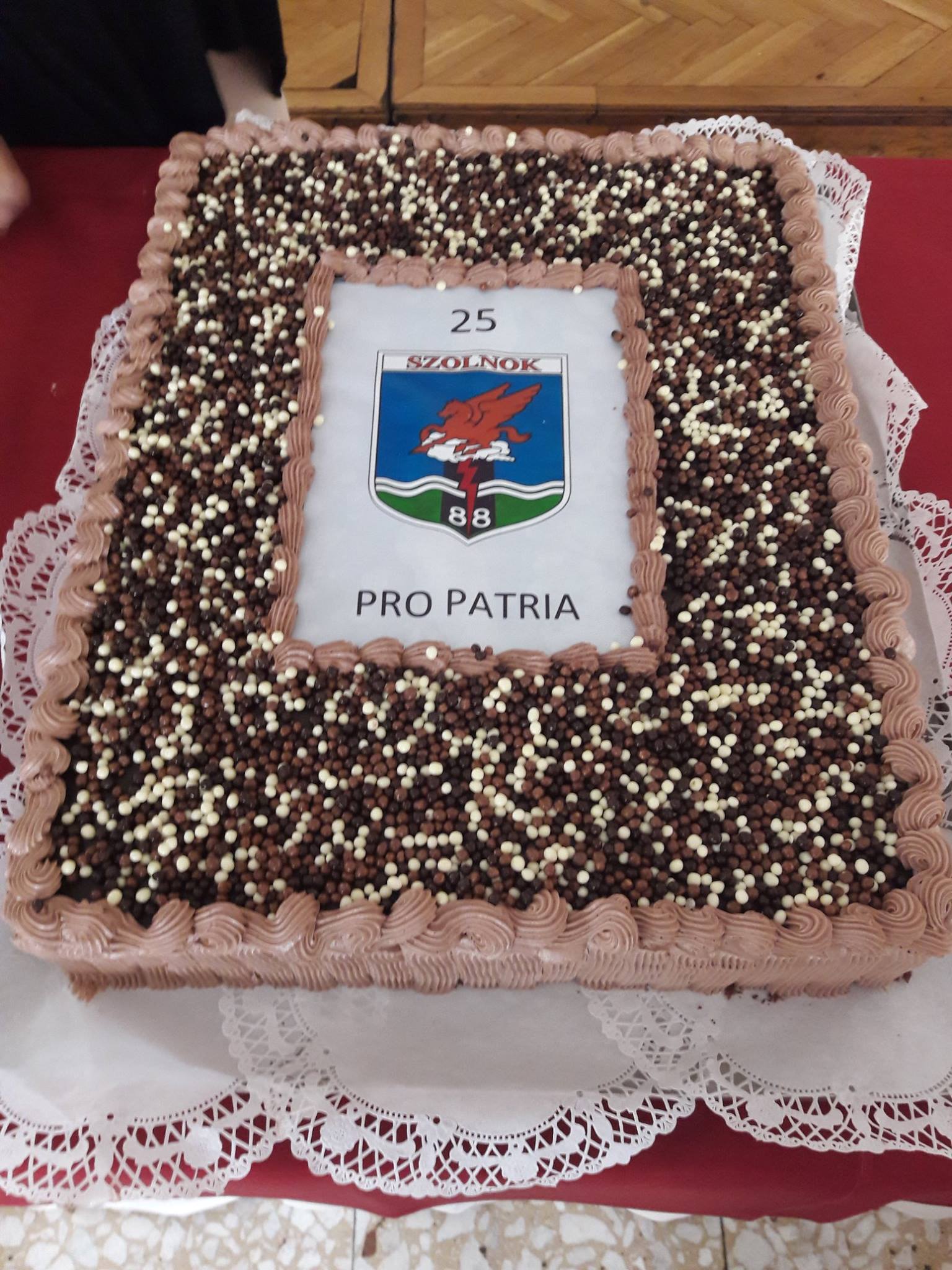 Az ünnepi torta
Az ünnepi torta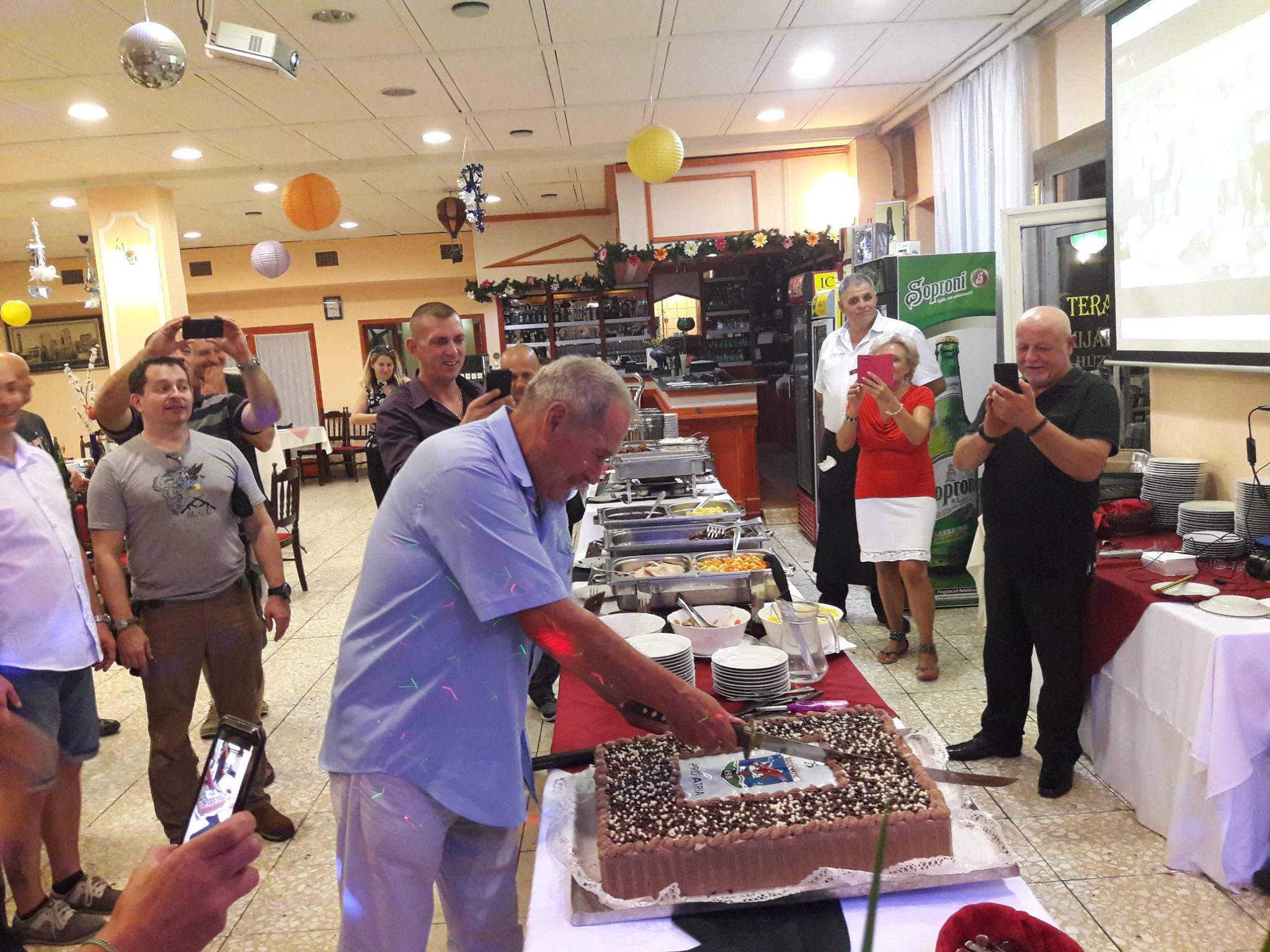 Keresztúri László ezredes úr felszeli a tortát
Keresztúri László ezredes úr felszeli a tortát
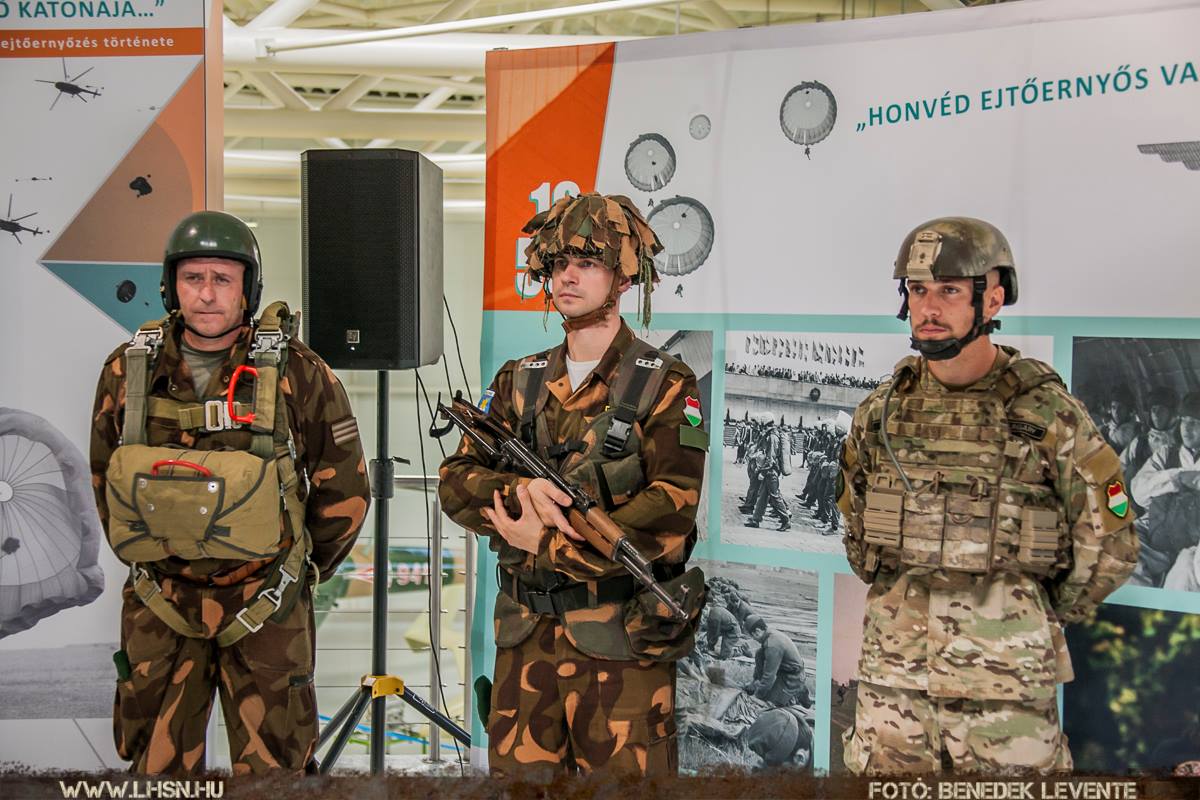
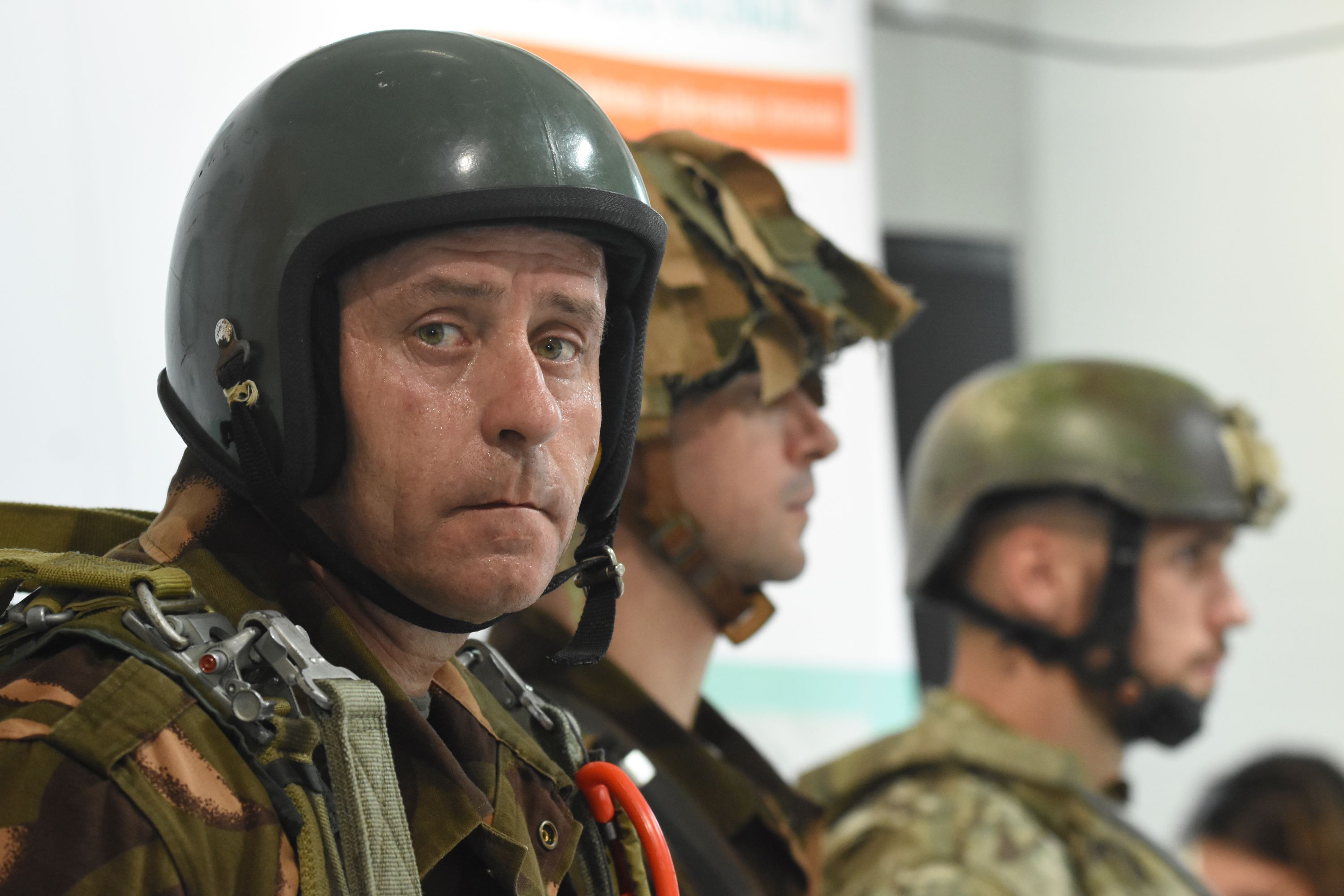
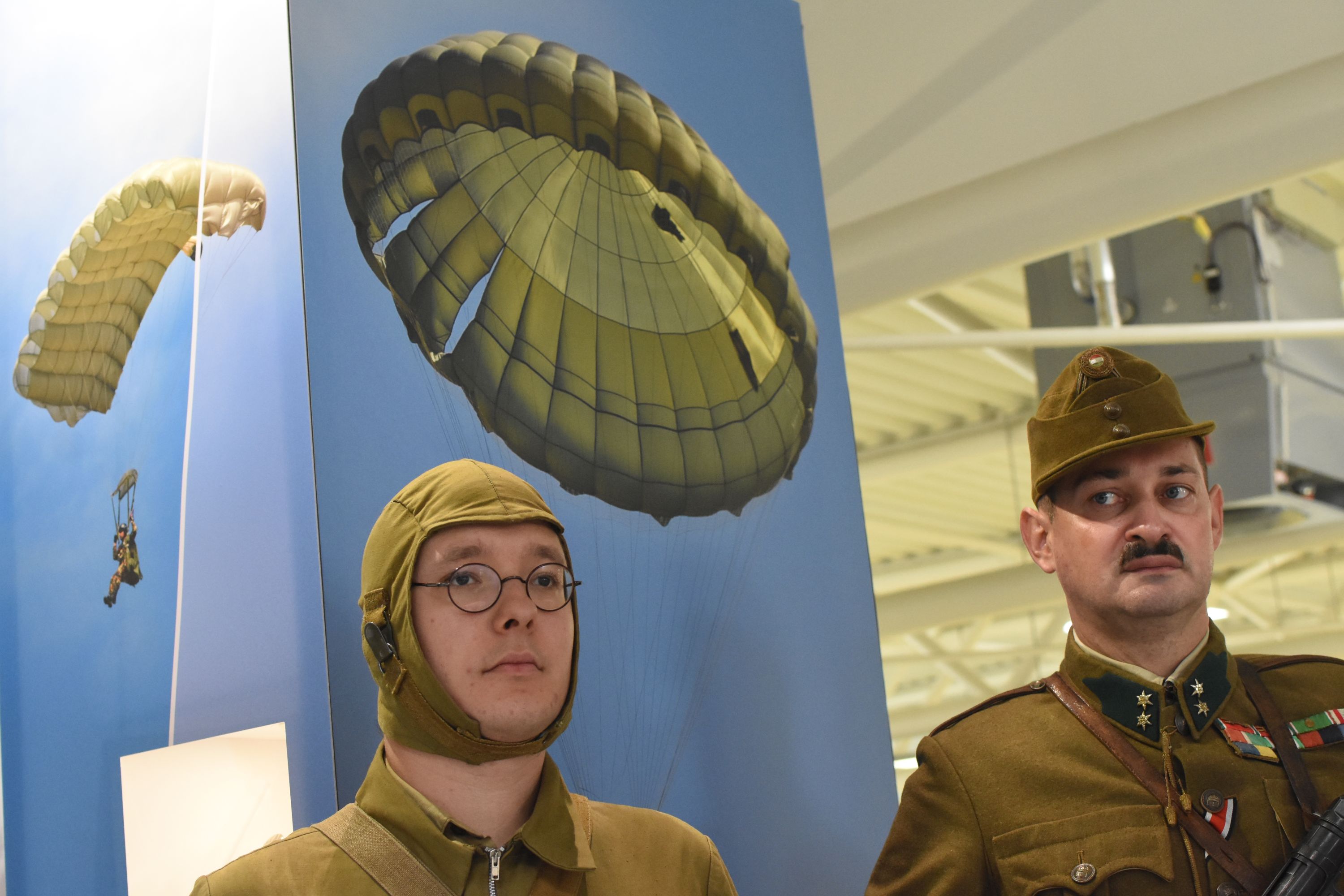
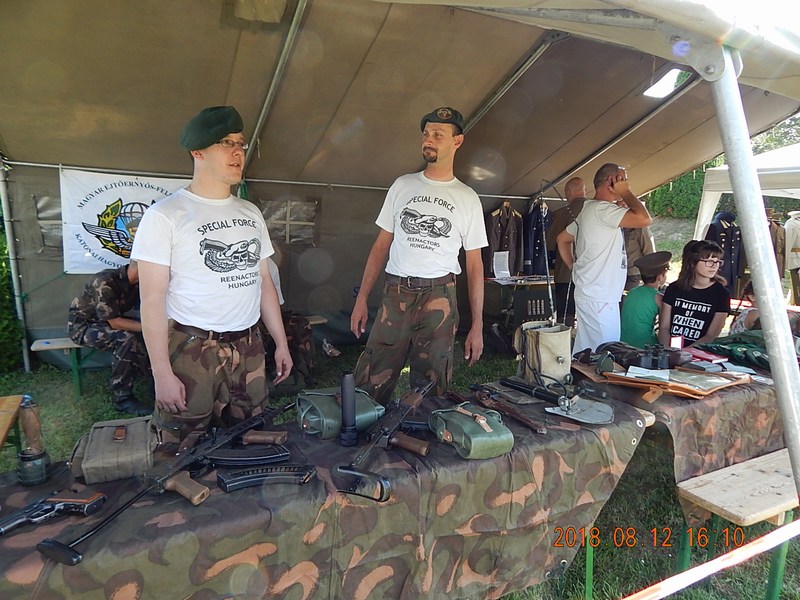 Látogatókra várva
Látogatókra várva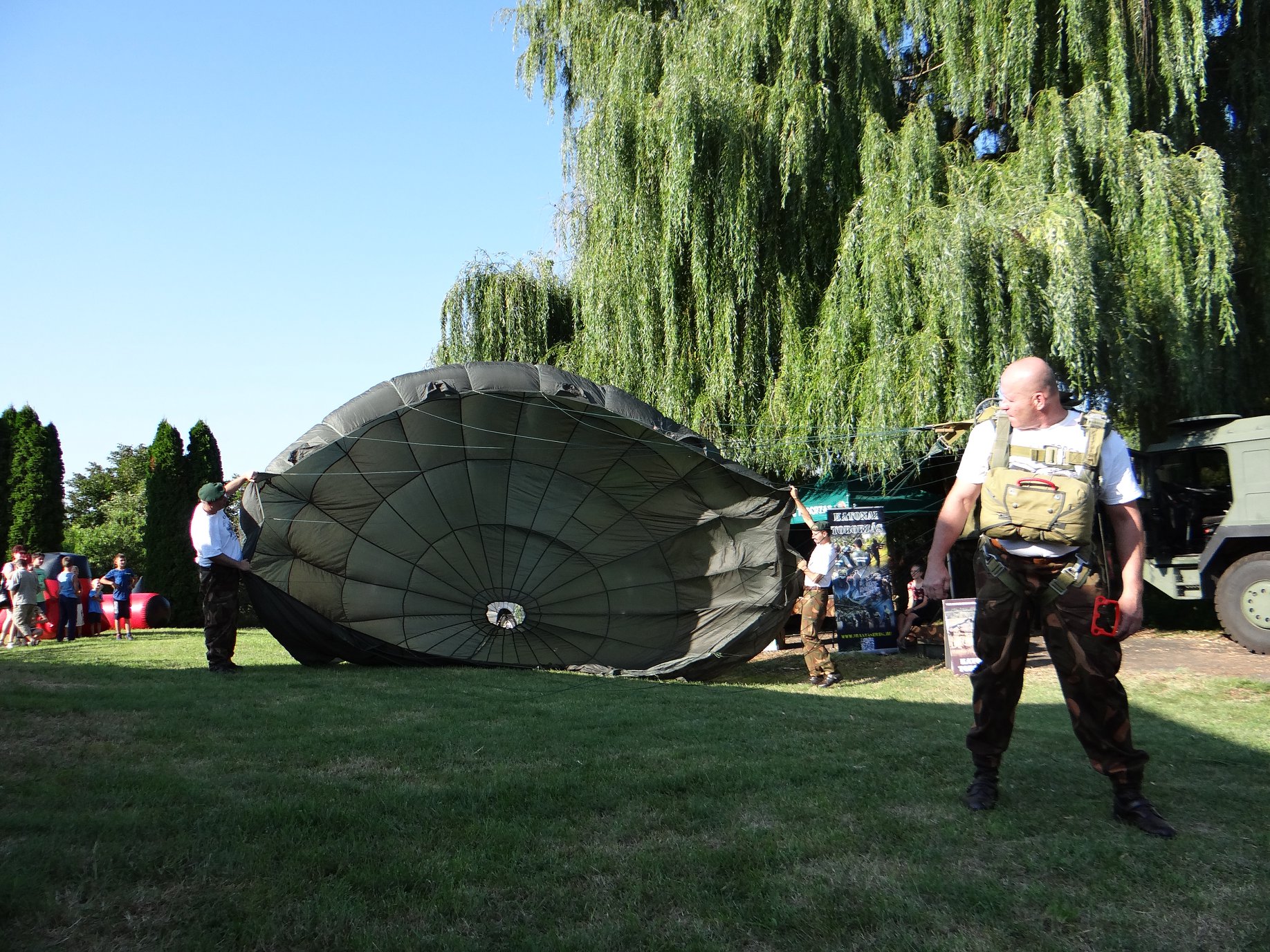 Lobban a kupola...
Lobban a kupola... Paratroopers riding a train
Paratroopers riding a train
 Hungarian paratroopers on the move during the early battels of 1944. Note the camo jump smock of the officer up front. -These smocks were modeled after German ones, but have been tailored personally by using shelter half/poncho materials.
Hungarian paratroopers on the move during the early battels of 1944. Note the camo jump smock of the officer up front. -These smocks were modeled after German ones, but have been tailored personally by using shelter half/poncho materials. Hungarian paratroopers in their trenches during the battle for Dunaharaszti and Soroksár. Note their jumpwings pinned to their hats in an unauthorized way.
Hungarian paratroopers in their trenches during the battle for Dunaharaszti and Soroksár. Note their jumpwings pinned to their hats in an unauthorized way. 1940M Nimrod self-propelled anti-aircraft gun
1940M Nimrod self-propelled anti-aircraft gun Paratrooper Private Sándor Mezei, killed in action at Soroksár on the 5th of November 1944.
Paratrooper Private Sándor Mezei, killed in action at Soroksár on the 5th of November 1944. Paratroopers scaling an obstacle while wearing only shorts has been a common sight during basic training.
Paratroopers scaling an obstacle while wearing only shorts has been a common sight during basic training. Paratroopers of the 2nd Parachute Battalion in typical late-war uniform. On the left memoire-writer, Béla G. Ábel
Paratroopers of the 2nd Parachute Battalion in typical late-war uniform. On the left memoire-writer, Béla G. Ábel  Paratrooper Private Sándor Lendvai killed in action on the 12th of December 1944. at Kéthely
Paratrooper Private Sándor Lendvai killed in action on the 12th of December 1944. at Kéthely Badge of the elite Szent László Division in which the paratroopers fought recovered from around Ipolyszalka
Badge of the elite Szent László Division in which the paratroopers fought recovered from around Ipolyszalka
 "A paratroopers knows no fear of death nor captivity!" Motto of the Hungarian paratroopers
"A paratroopers knows no fear of death nor captivity!" Motto of the Hungarian paratroopers Members of the parachute heavy weapons company in 1943. 2/3 of them has died or wounded during the last two years of WWII.
Members of the parachute heavy weapons company in 1943. 2/3 of them has died or wounded during the last two years of WWII. The Paratrooper Memorial Wall at Szolnok, Hungary with the 1940M Parachutist Wings on top of it
The Paratrooper Memorial Wall at Szolnok, Hungary with the 1940M Parachutist Wings on top of it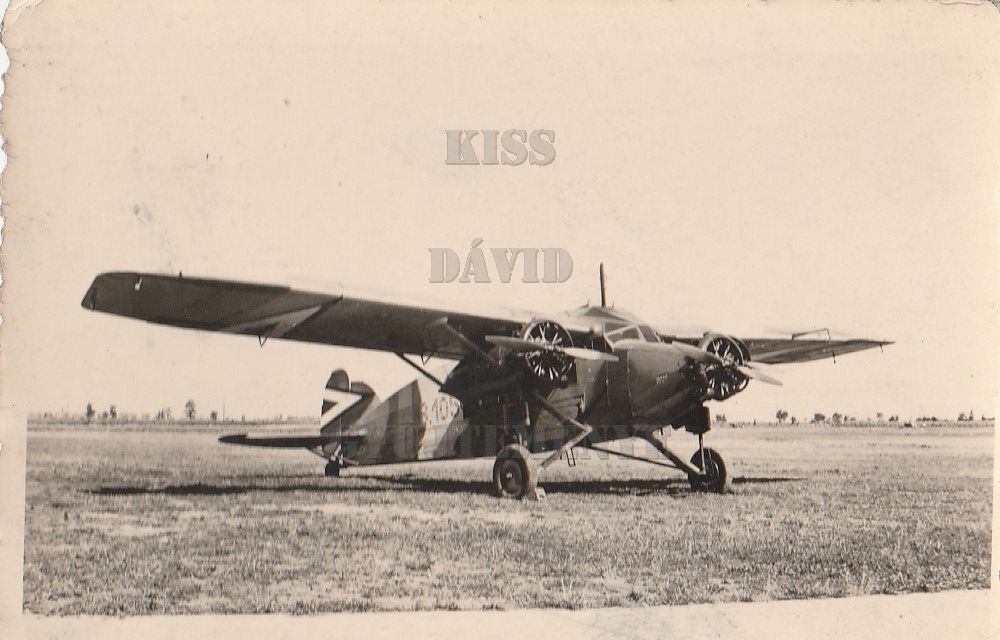 Caproni Ca. 101. bomber/transport airplane in Hungarian service
Caproni Ca. 101. bomber/transport airplane in Hungarian service Savoia-Marchetti SM.75 paratrooper transport plane of the Parachutist Transport Company
Savoia-Marchetti SM.75 paratrooper transport plane of the Parachutist Transport Company Paratroopers boarding their planes before taking off for a practice jump. Their combat load is clearly visible.
Paratroopers boarding their planes before taking off for a practice jump. Their combat load is clearly visible.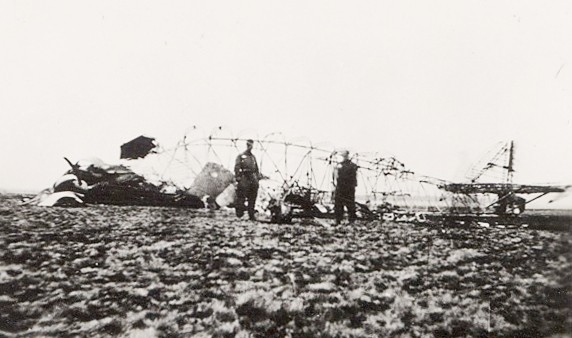 The crashed SM.75 after it has burned out
The crashed SM.75 after it has burned out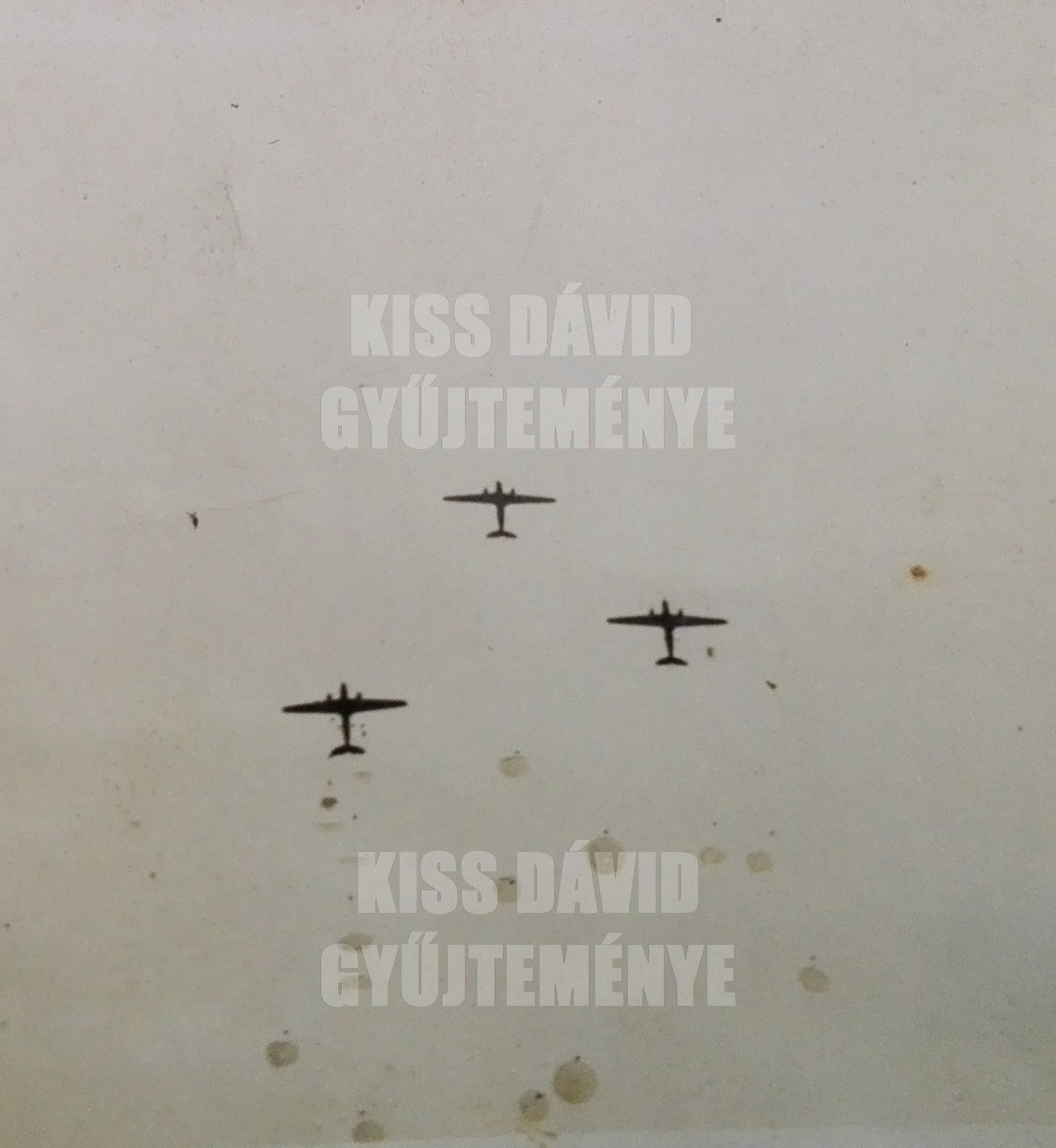 Hungarian paratroopers during a mass jump exercise
Hungarian paratroopers during a mass jump exercise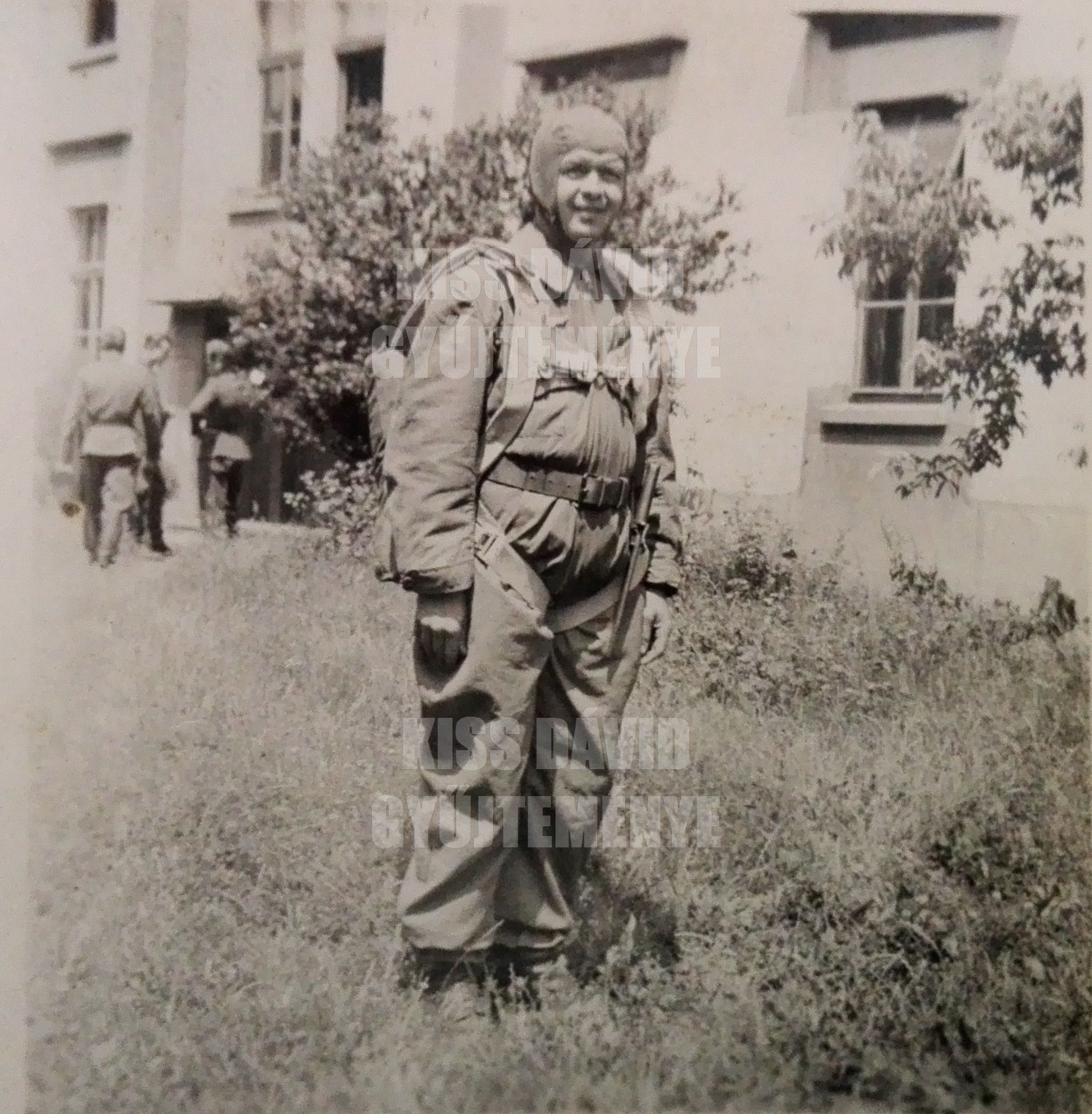 Paratrooper Private József Jelics, acting interpreter during the combat jump.
Paratrooper Private József Jelics, acting interpreter during the combat jump.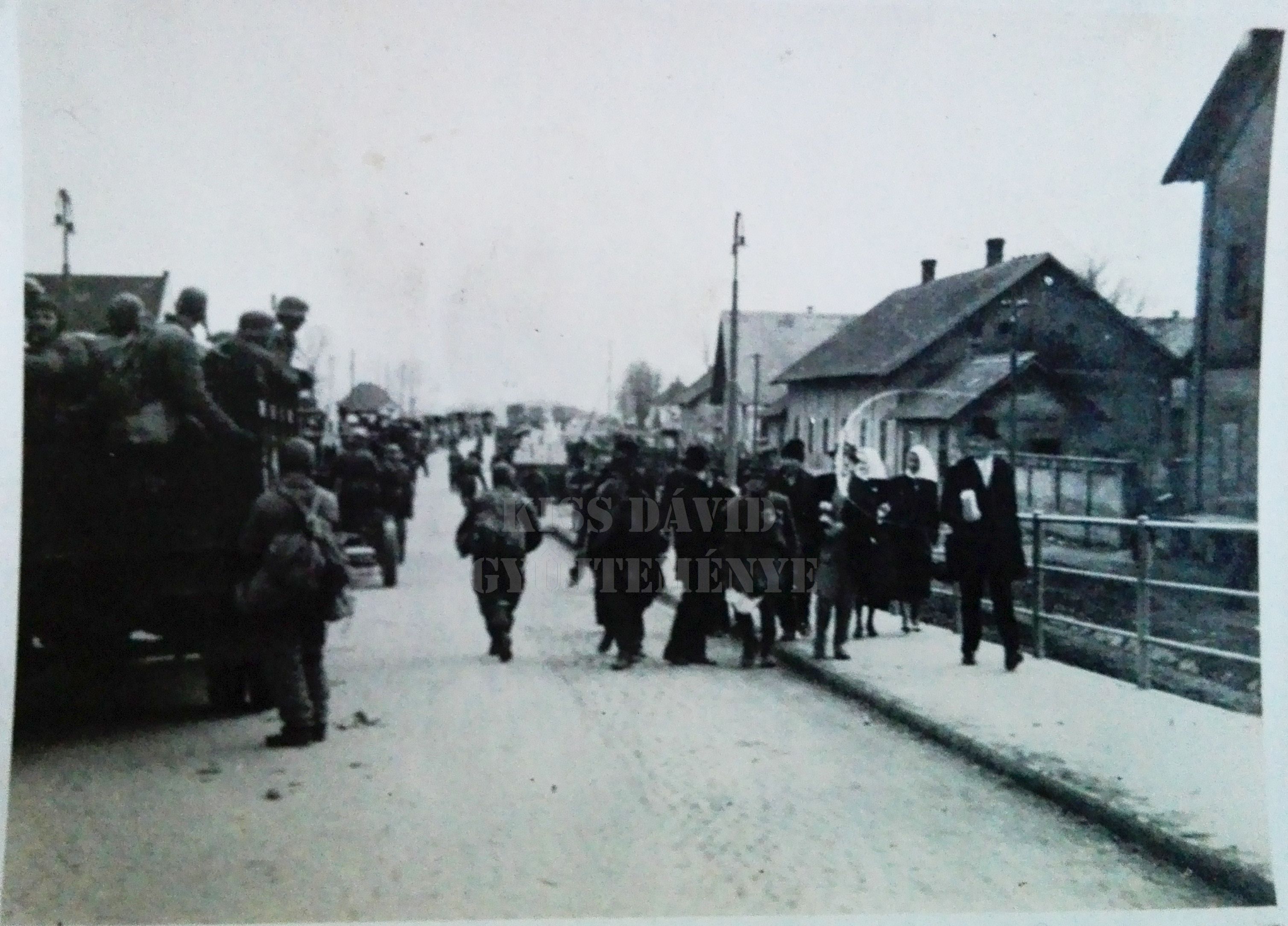 Hungarian paratroopers and mechanized units moving forward during the campaign. The paratroopers are easily recognizable by their "haube" caps and their backpacks.
Hungarian paratroopers and mechanized units moving forward during the campaign. The paratroopers are easily recognizable by their "haube" caps and their backpacks. Paratrooper honor guards on the funeral of their fallen comrades at Veszprém, Hungary
Paratrooper honor guards on the funeral of their fallen comrades at Veszprém, Hungary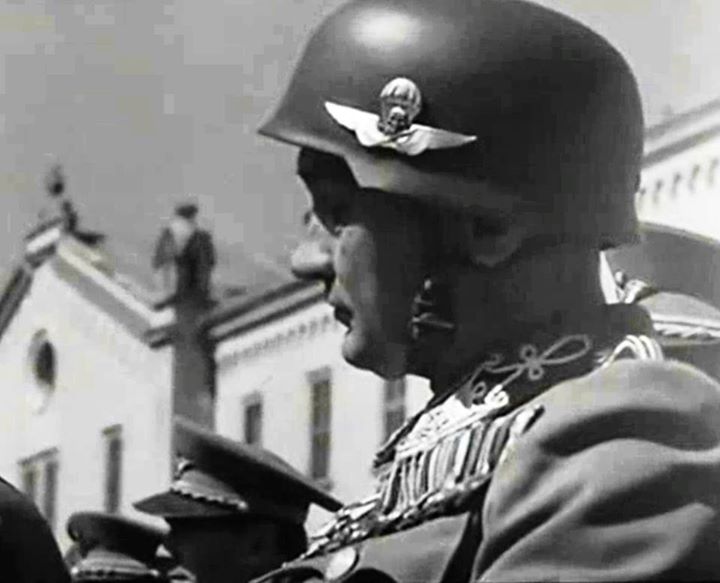 Colonel Vitéz Zoltán Szügyi during an oficial parade of flight officers, wearing a "homemade" parachutist helmet, designed for parade use, and modeled after the German M38 parachutist jump helmet.
Colonel Vitéz Zoltán Szügyi during an oficial parade of flight officers, wearing a "homemade" parachutist helmet, designed for parade use, and modeled after the German M38 parachutist jump helmet.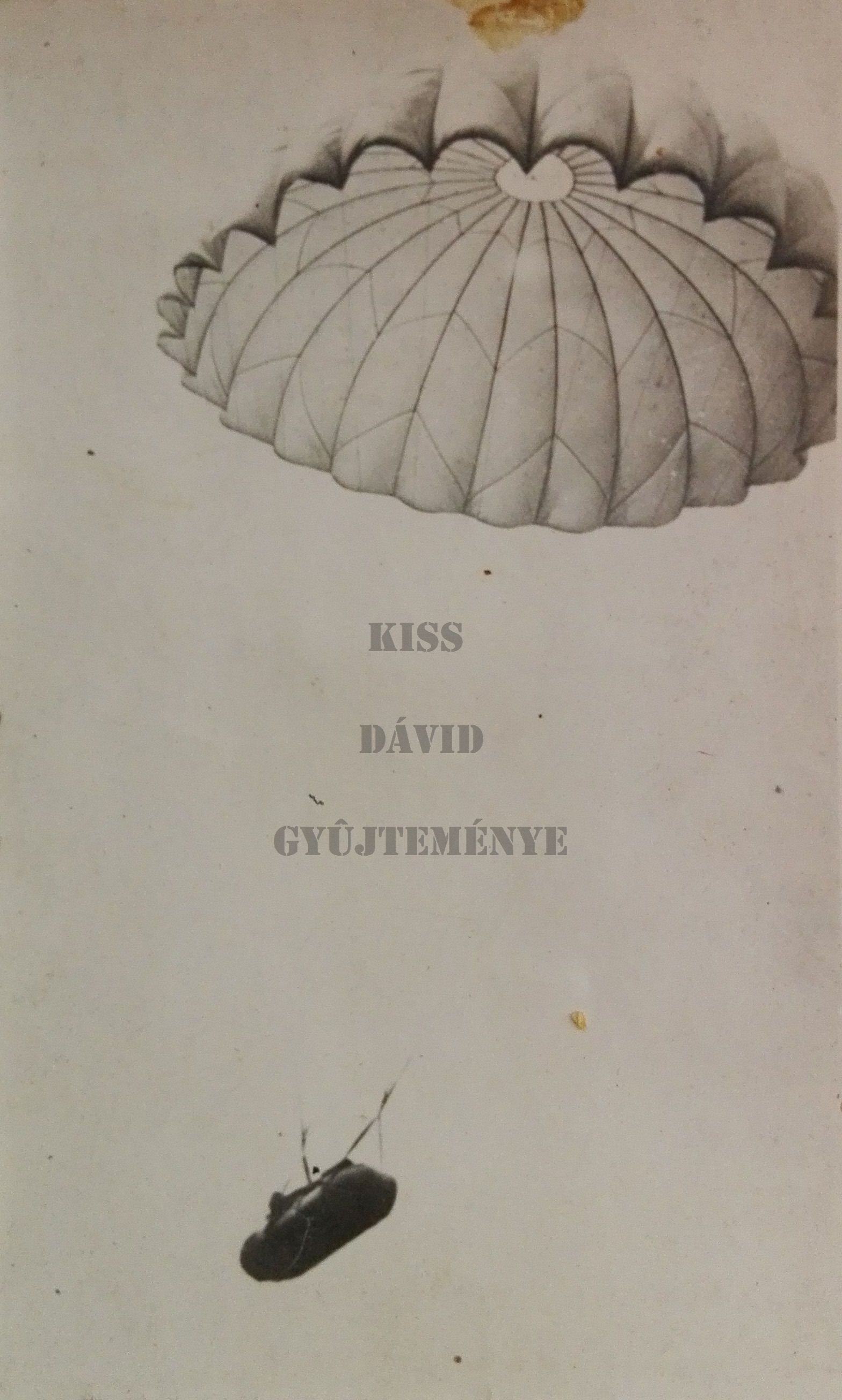 Hungarian drop canister slowly descending on a parachute.
Hungarian drop canister slowly descending on a parachute.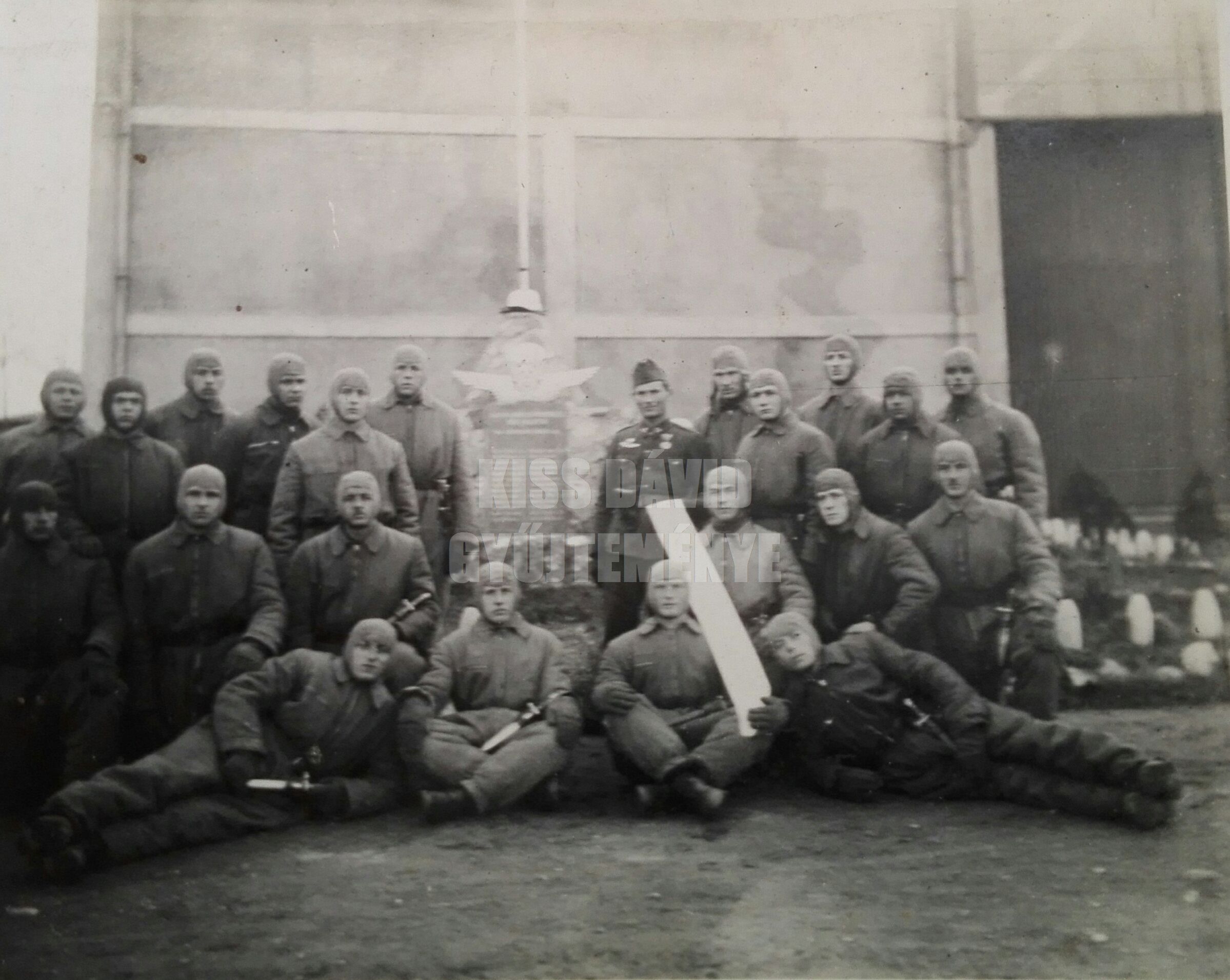 Paratroopers next to the memorial of the fallen comrades at the Pápa airport in 1943.
Paratroopers next to the memorial of the fallen comrades at the Pápa airport in 1943.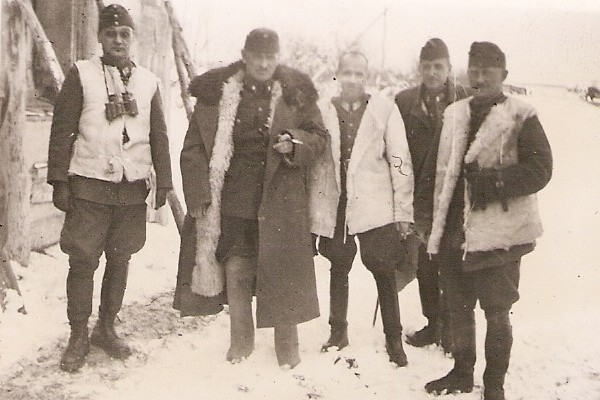 Hungarian officers on the Eastern Front during the winter of 1942-'43. On the left with binoculars is Colonel Zoltán Szügyi.
Hungarian officers on the Eastern Front during the winter of 1942-'43. On the left with binoculars is Colonel Zoltán Szügyi.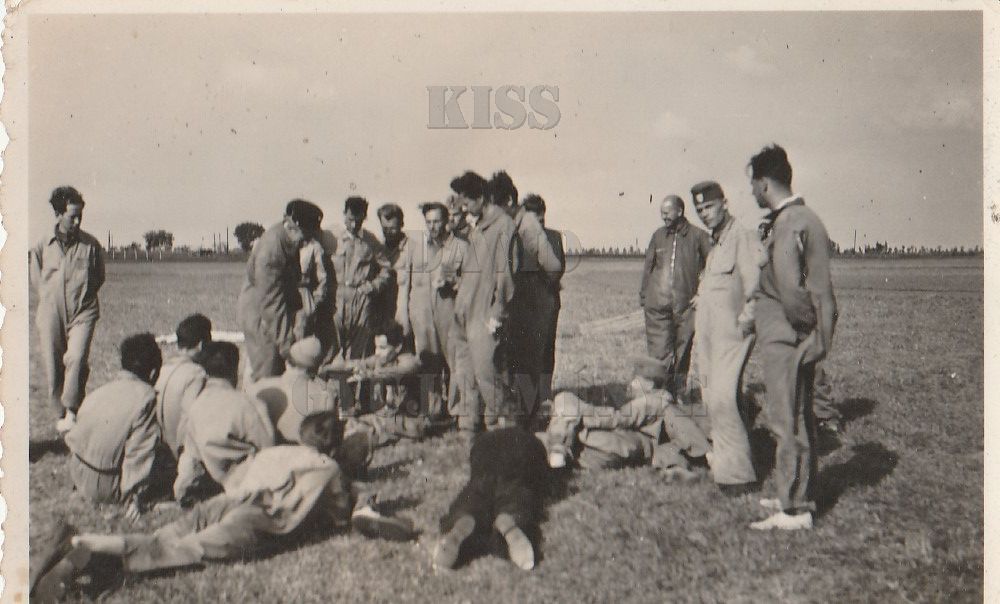
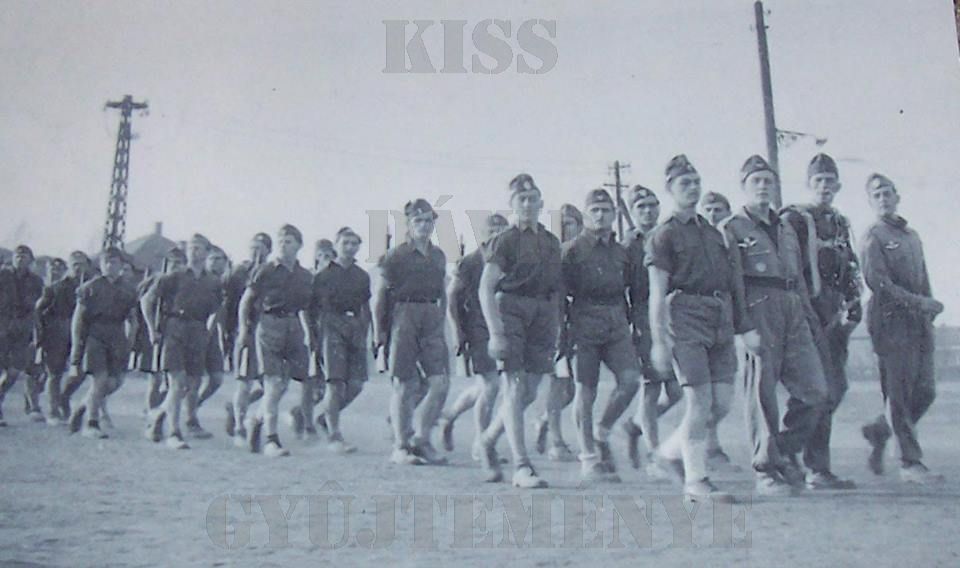 Levente-paratroopers on the march
Levente-paratroopers on the march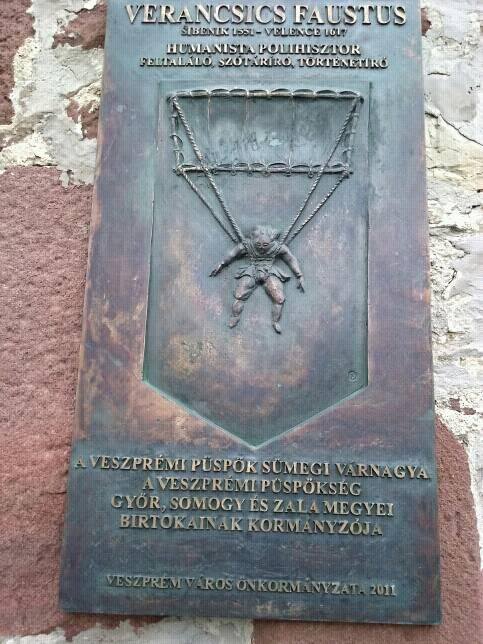 Memorial plaque of Faustus Verantius, the Dalmatian-born Hungarian humanist who has invented a type of parachute system in the 17th Century
Memorial plaque of Faustus Verantius, the Dalmatian-born Hungarian humanist who has invented a type of parachute system in the 17th Century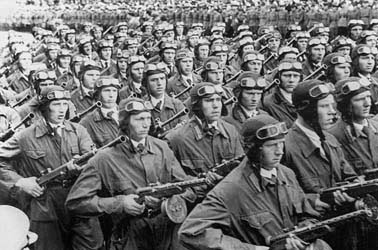 Soviet paratroopers on a parade before 1941.
Soviet paratroopers on a parade before 1941.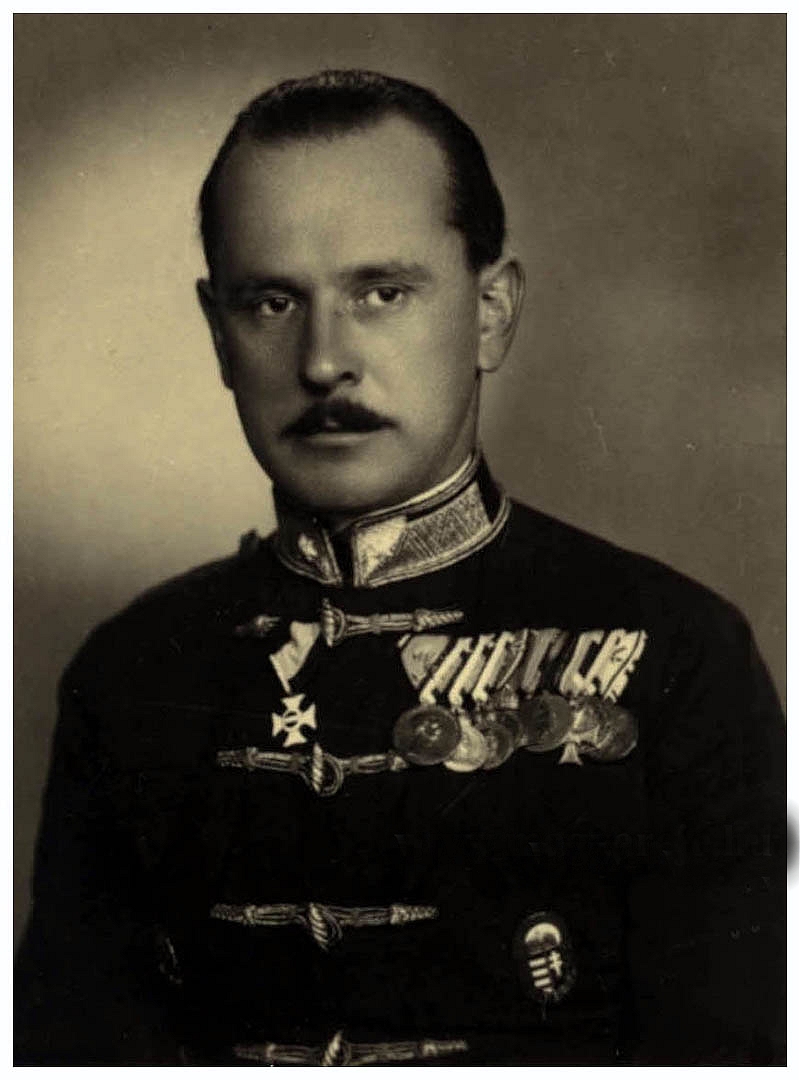
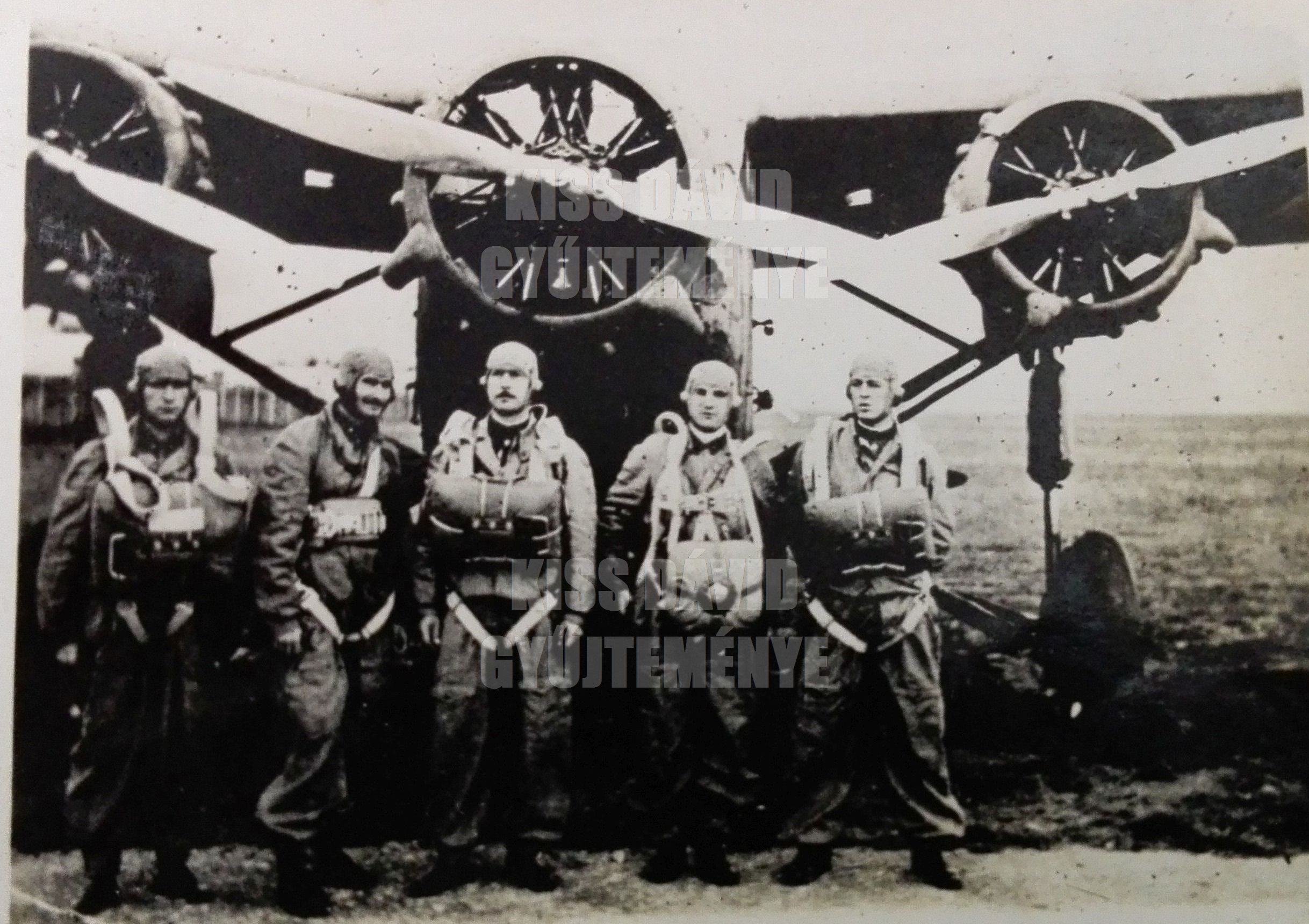 Members of the Parachutist Experimental Unit in front of a Caproni Ca. 101 bomber/transport airplane. Captain Bertalan is in the middle. Note the different parachutes worn.
Members of the Parachutist Experimental Unit in front of a Caproni Ca. 101 bomber/transport airplane. Captain Bertalan is in the middle. Note the different parachutes worn.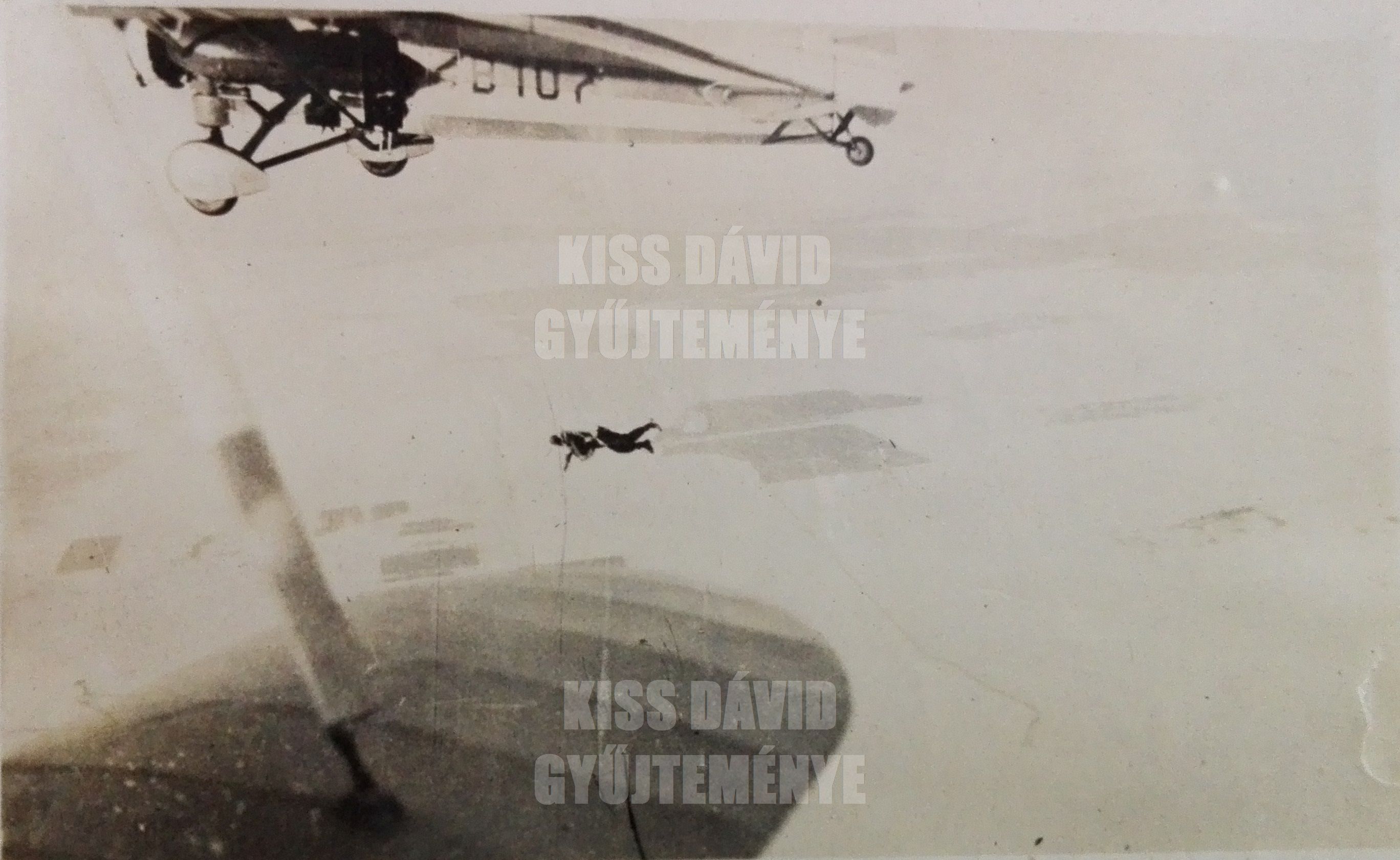 Paratrooper exiting the Caproni Ca. 101.
Paratrooper exiting the Caproni Ca. 101.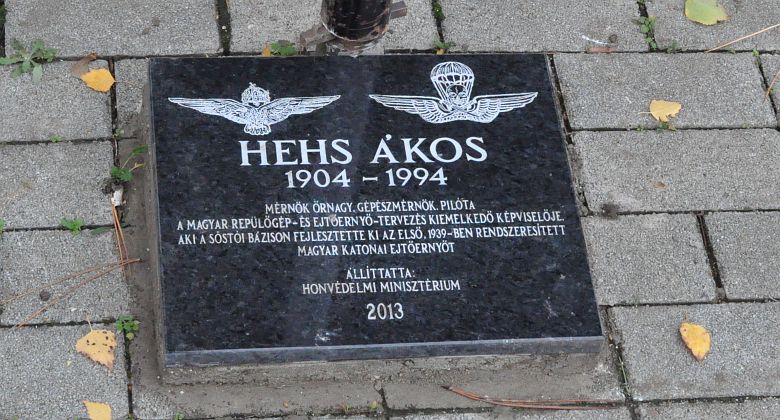
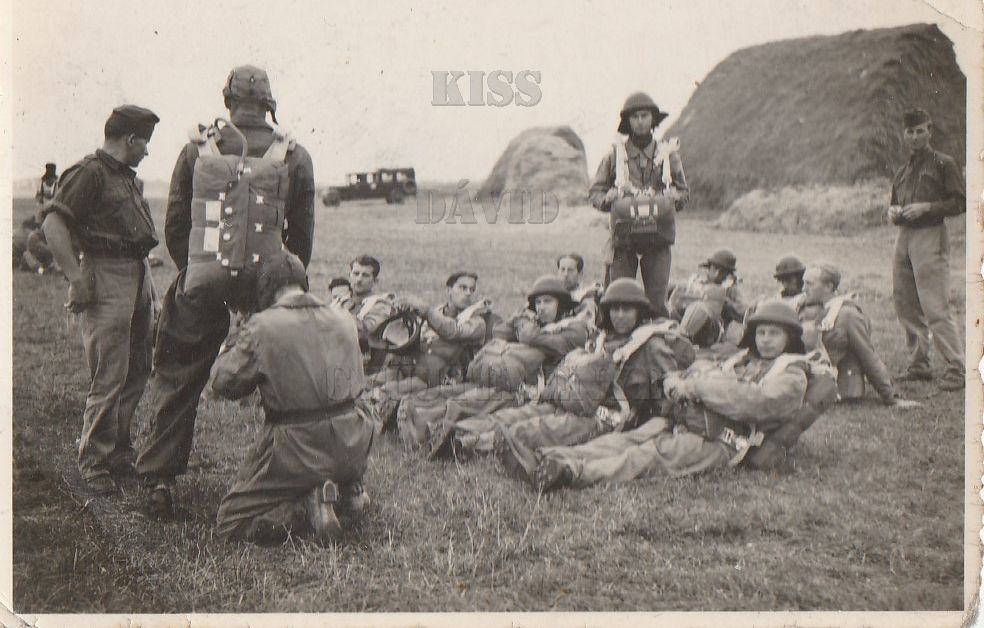 Hungarian paratroopers with the new parachute system before jump. Note the Italian made protective helmets.
Hungarian paratroopers with the new parachute system before jump. Note the Italian made protective helmets.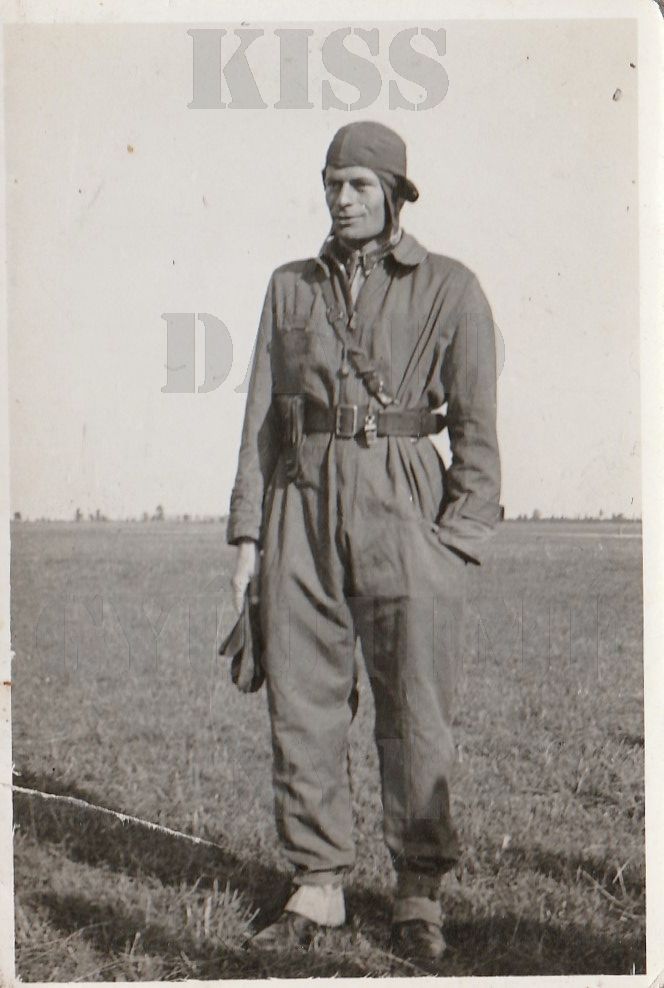
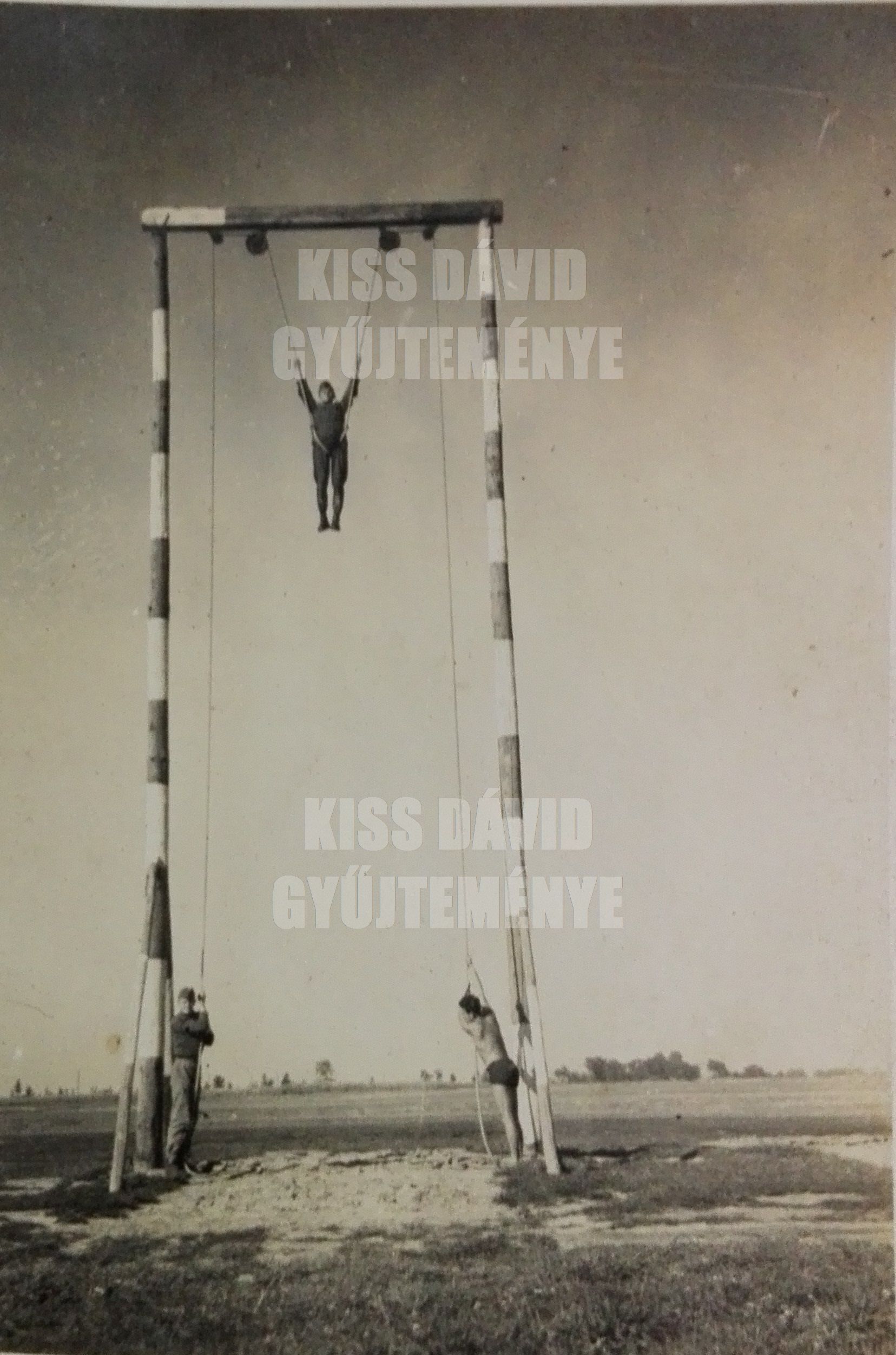 Paratrooper pulled up on one of the gallows
Paratrooper pulled up on one of the gallows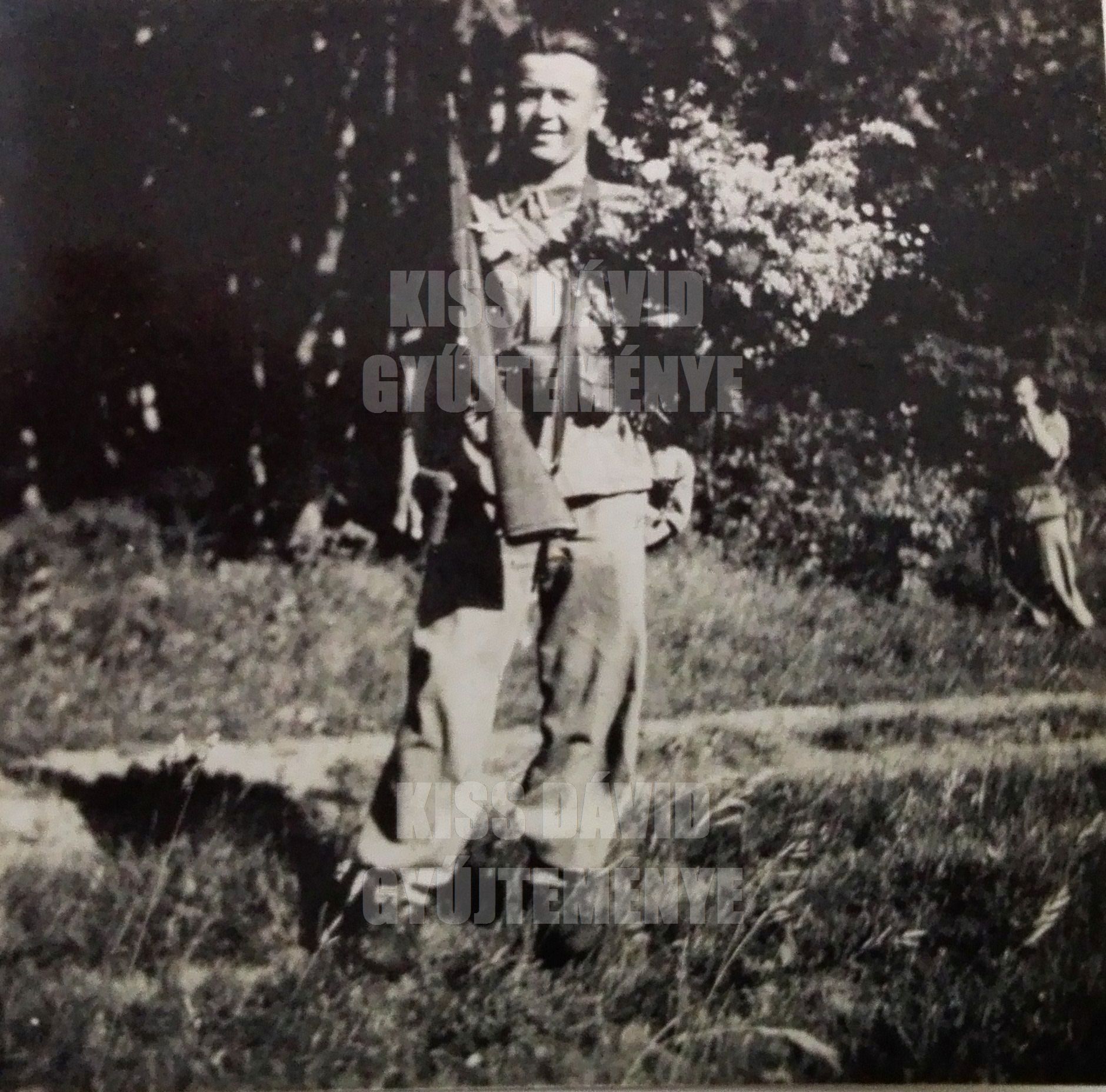 Paratrooper on live fire exercise with his trusty 31M Mannlicher Stutzen slung around his neck
Paratrooper on live fire exercise with his trusty 31M Mannlicher Stutzen slung around his neck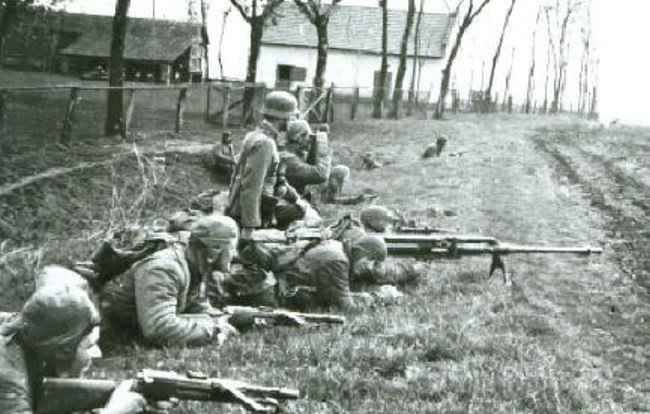
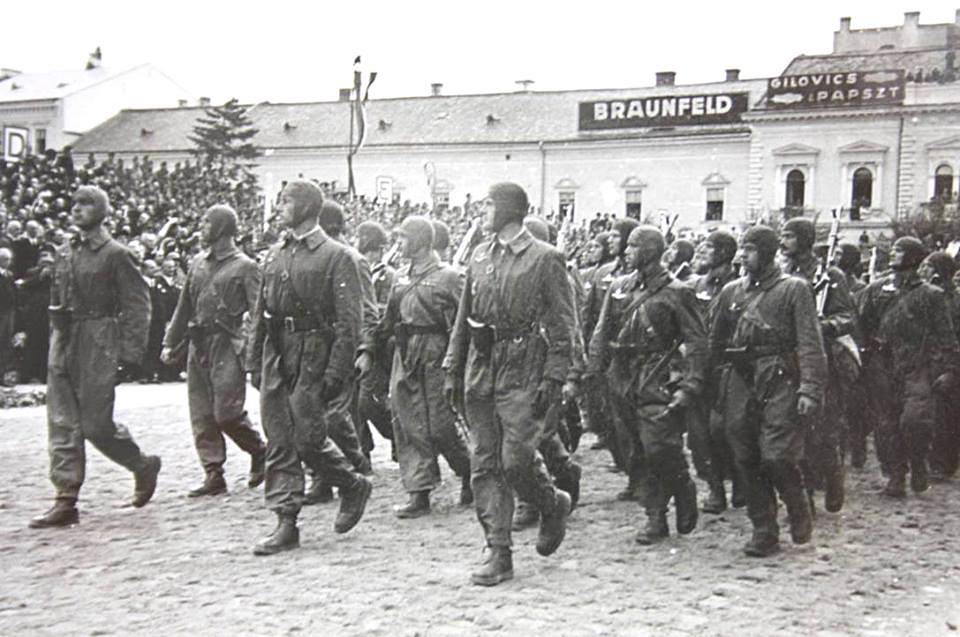 Hungarian paratrooper parade during the return of Northern Transylvania
Hungarian paratrooper parade during the return of Northern Transylvania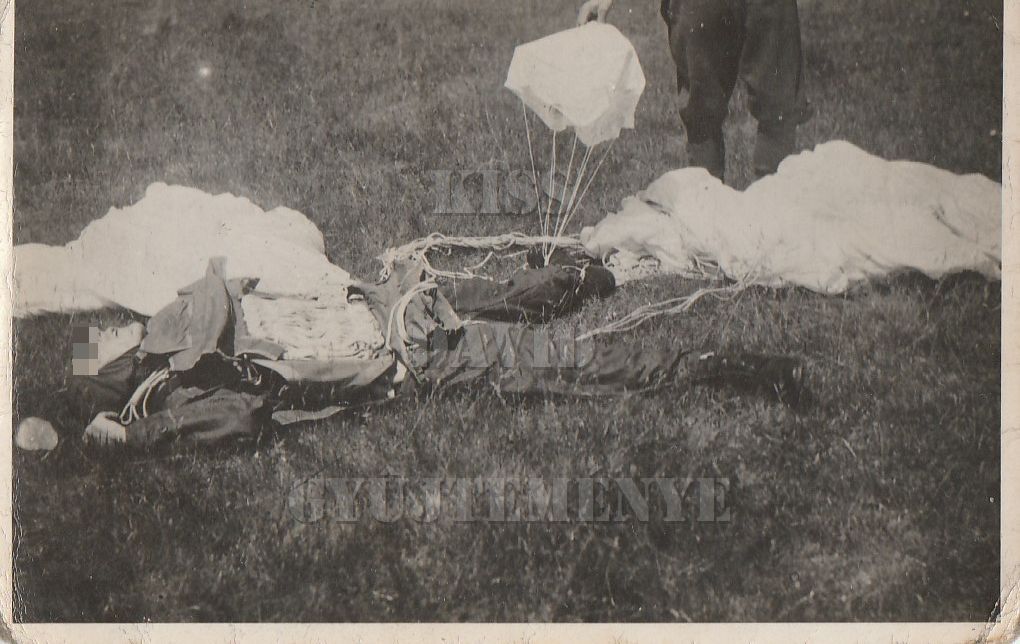 Hungarian paratrooper killed during training jump. His pilot chute is clearly visible entangled on his left leg.
Hungarian paratrooper killed during training jump. His pilot chute is clearly visible entangled on his left leg.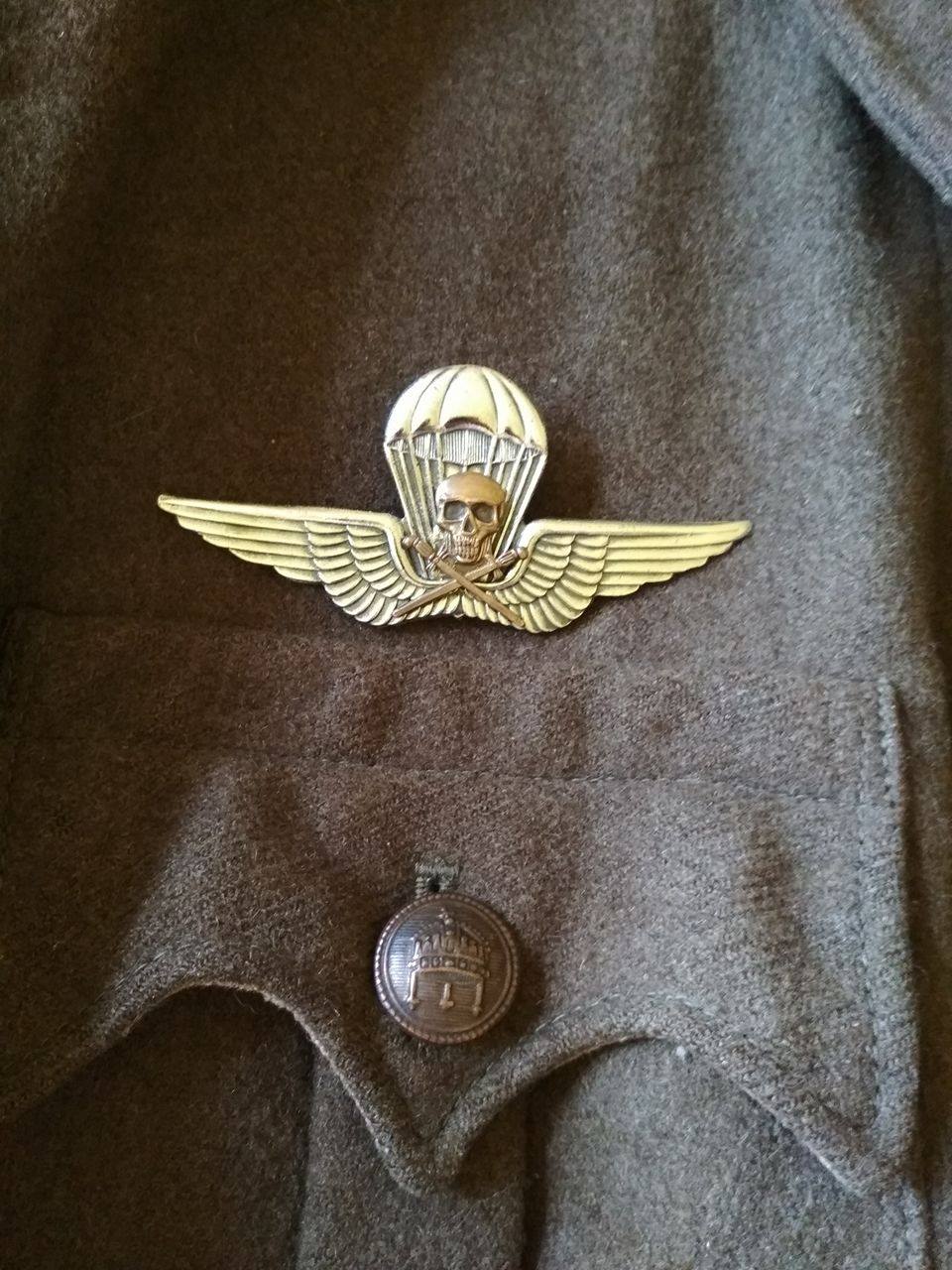
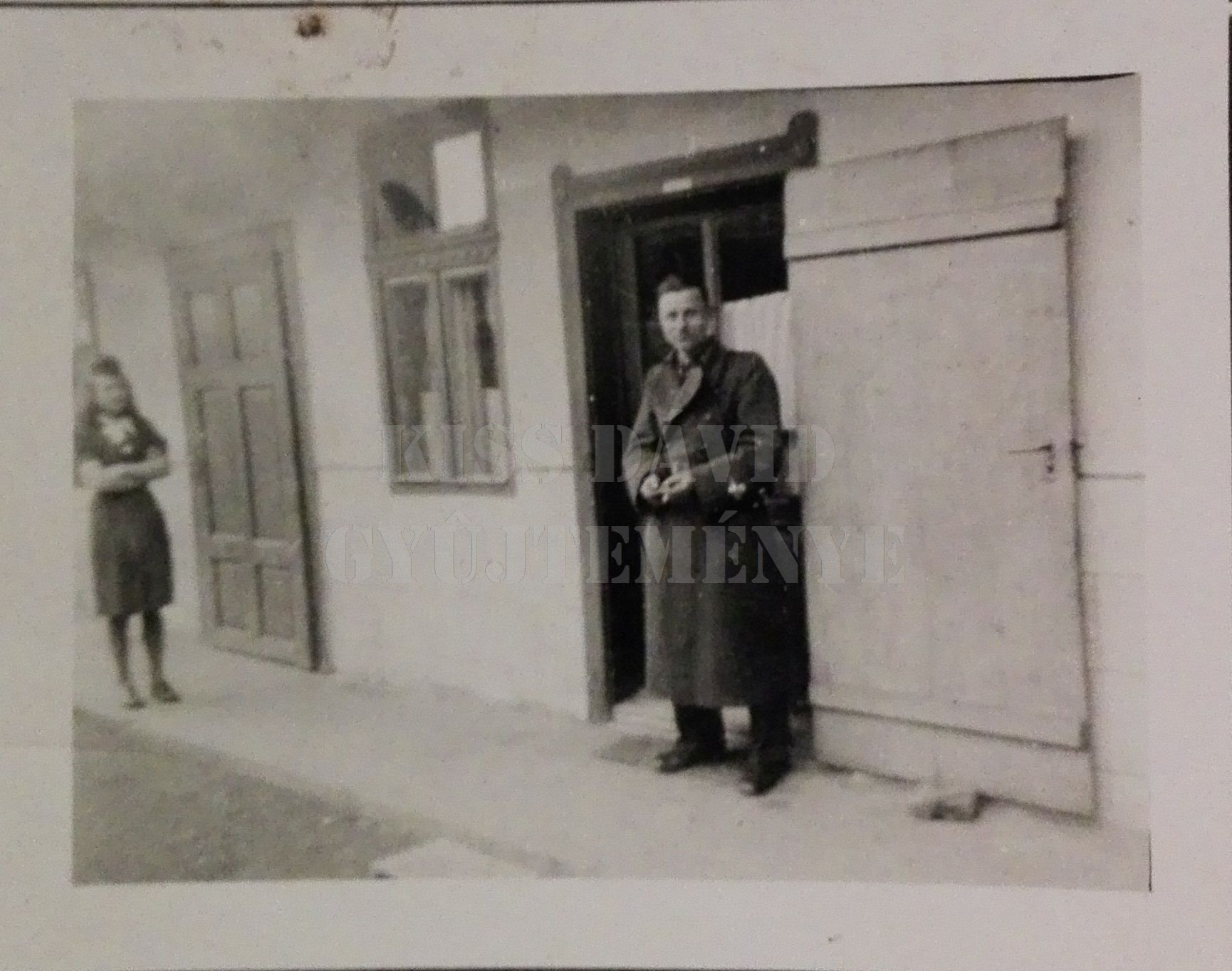 Paratrooper, with his jump badge visible on the sleeve of his coat, posing for a picture while a local girl awaits him impatiently.
Paratrooper, with his jump badge visible on the sleeve of his coat, posing for a picture while a local girl awaits him impatiently.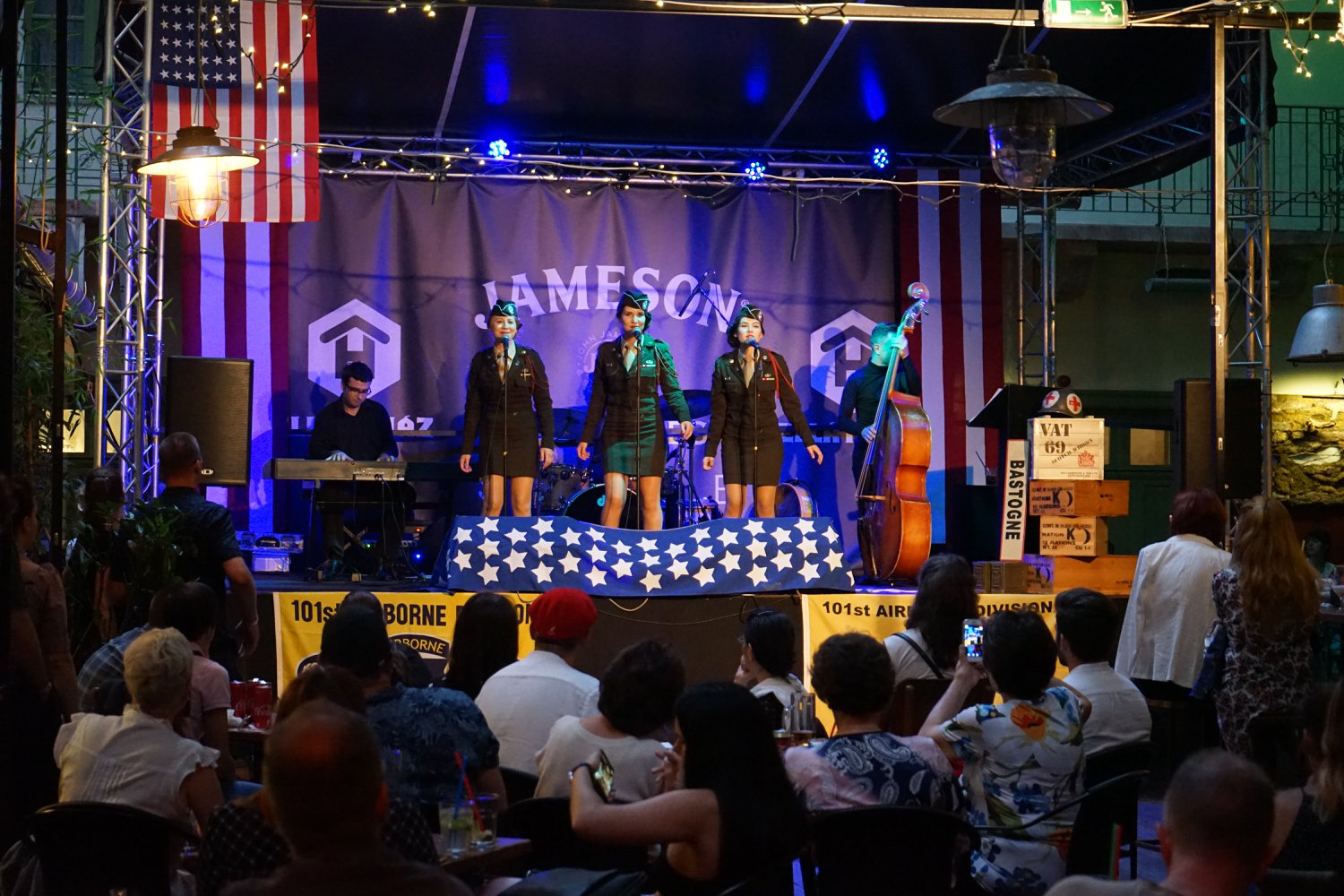 A színpadkép és a "bébik" is a múltat idézték
A színpadkép és a "bébik" is a múltat idézték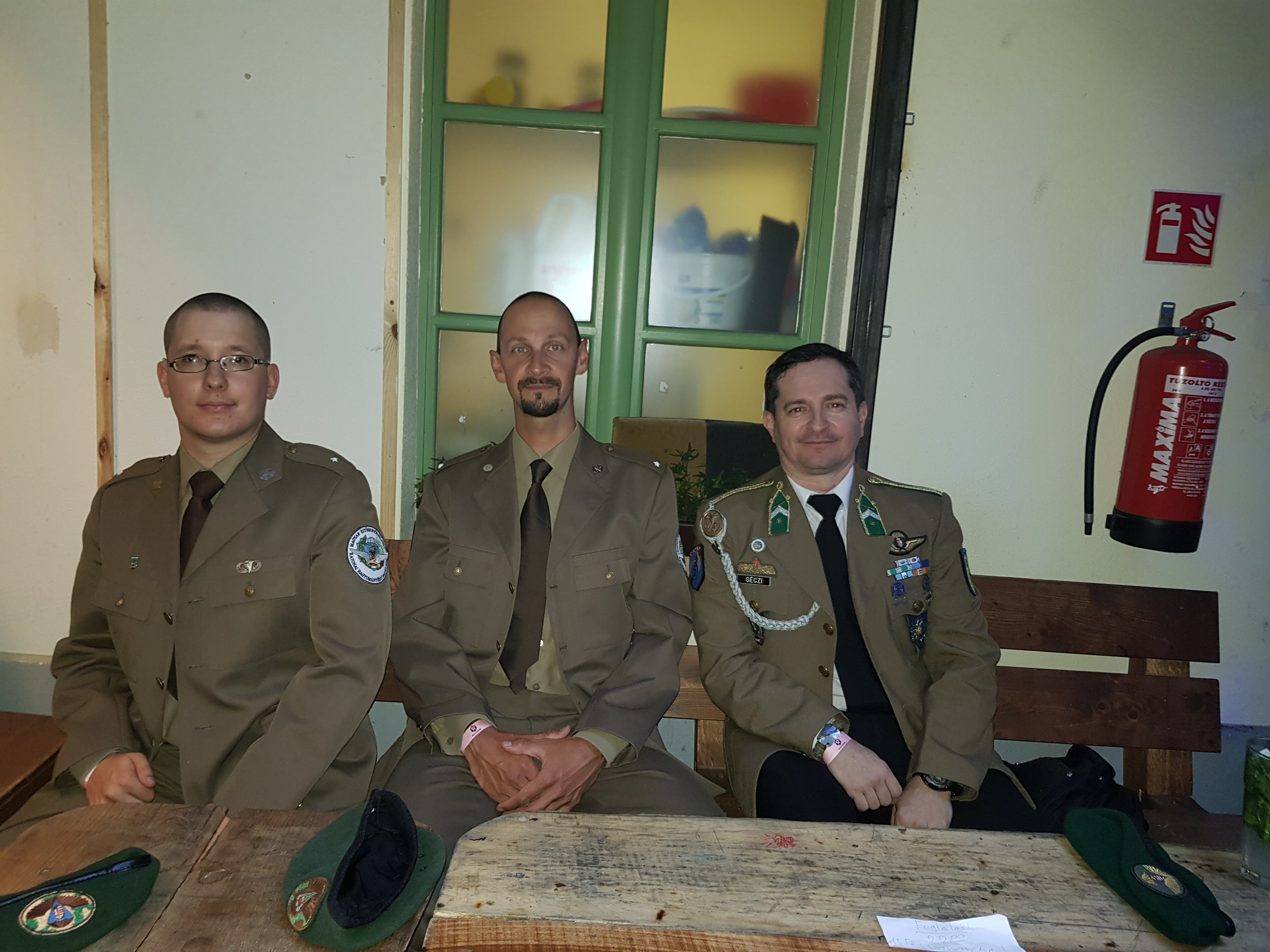 Váratlan találkozás
Váratlan találkozás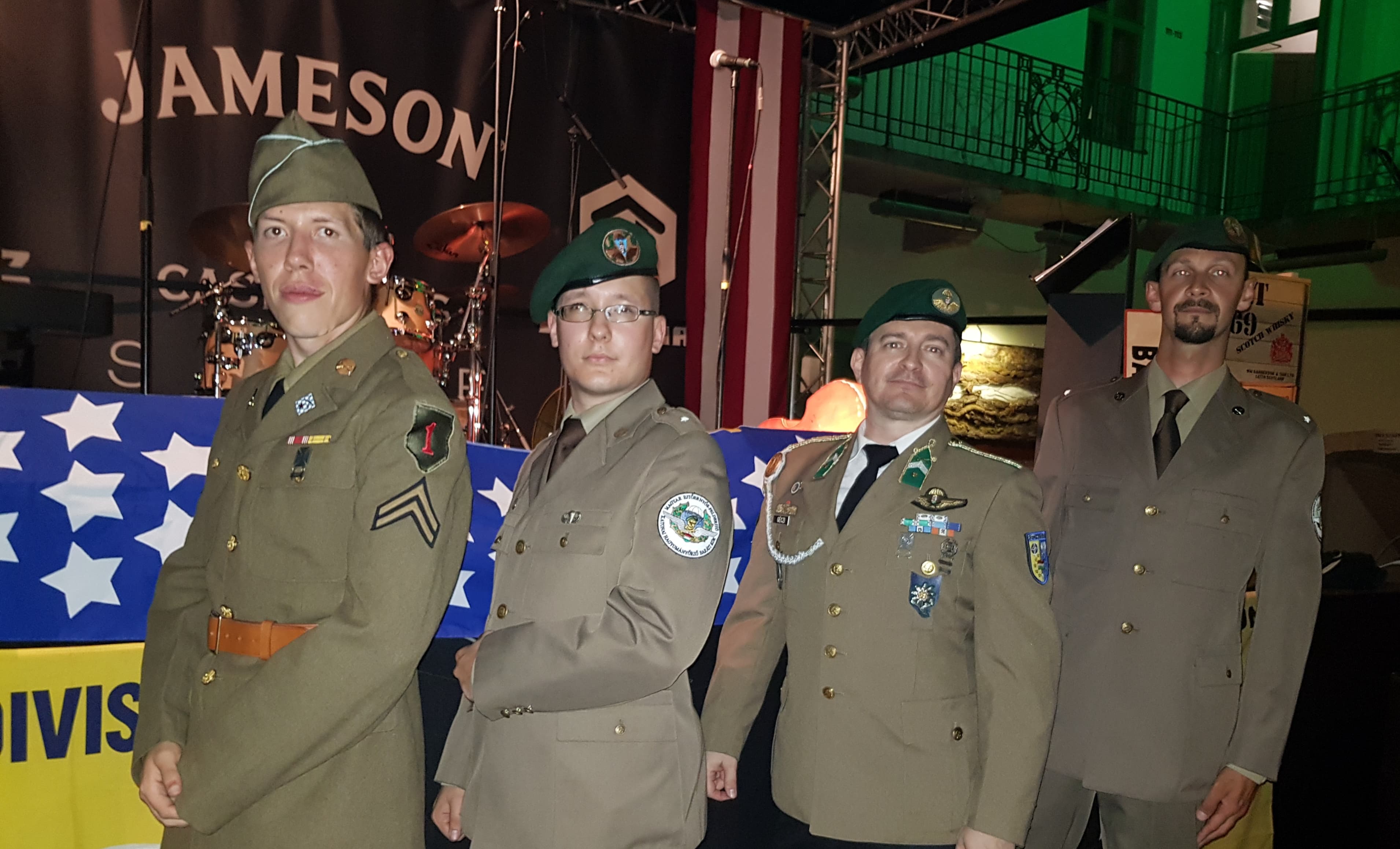 Hagyományőrzők csoportképe - a lányokkal készülteket már NAGYON várjuk! :-)
Hagyományőrzők csoportképe - a lányokkal készülteket már NAGYON várjuk! :-)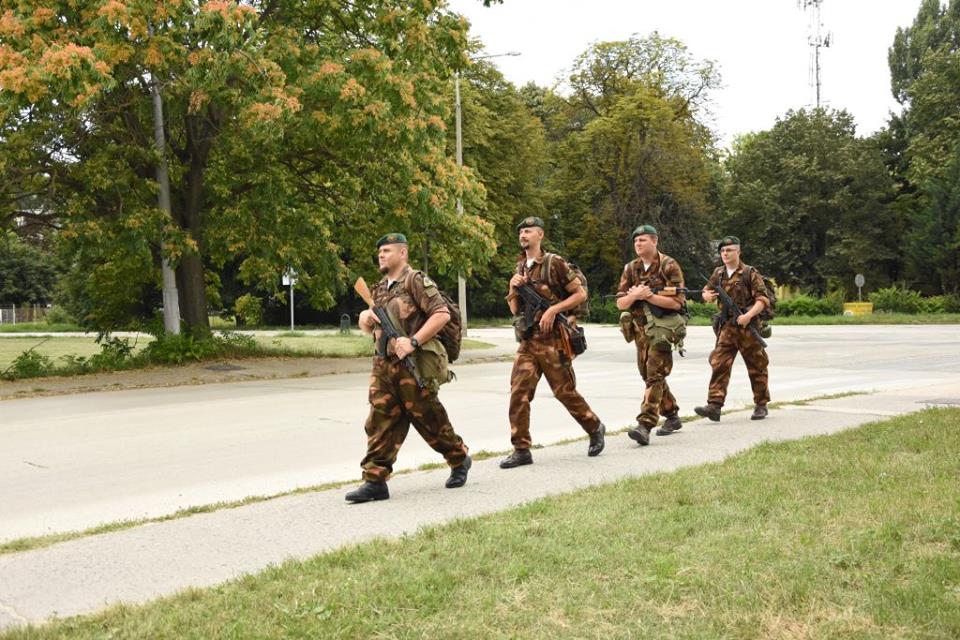
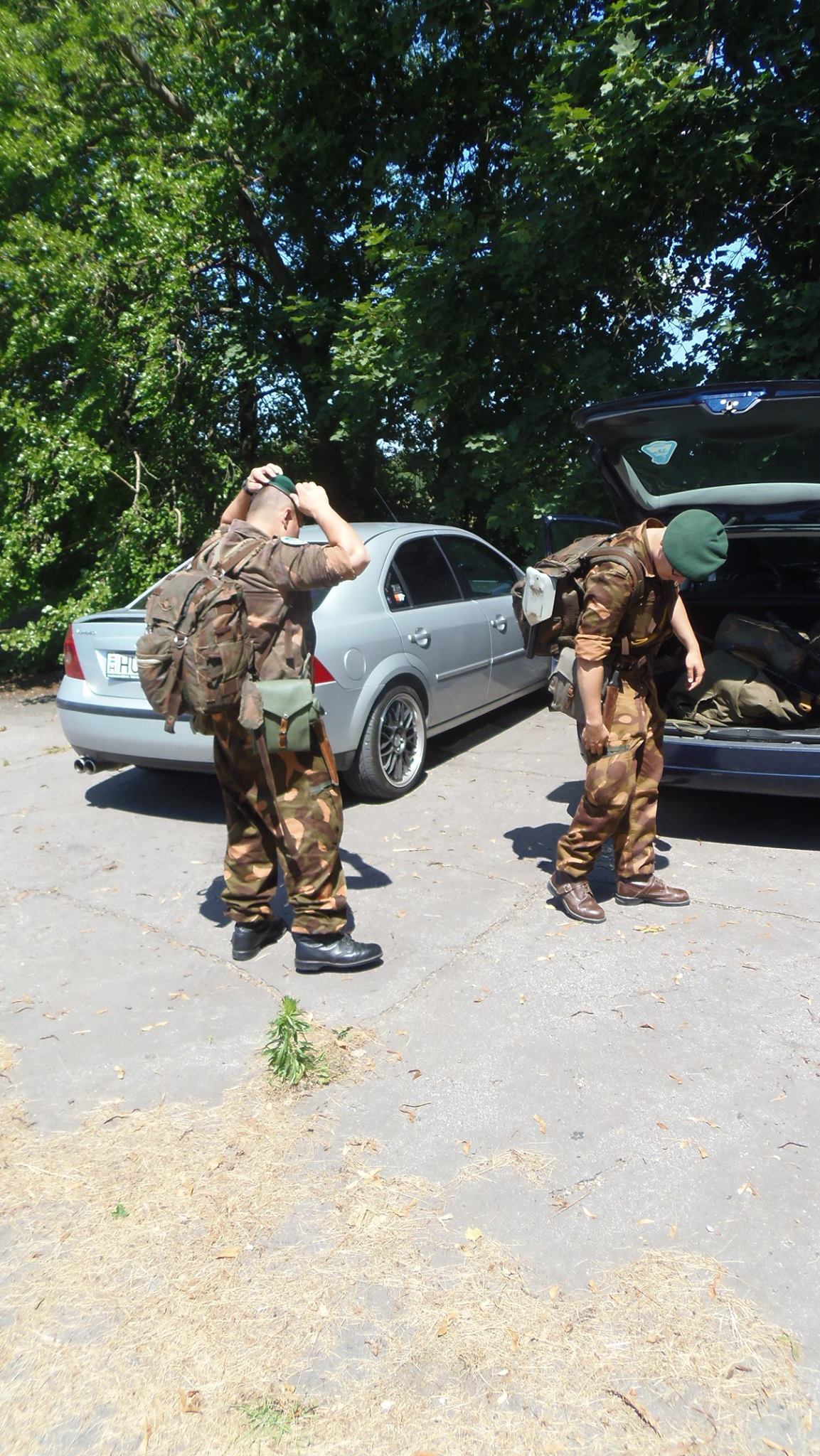 Készülődés
Készülődés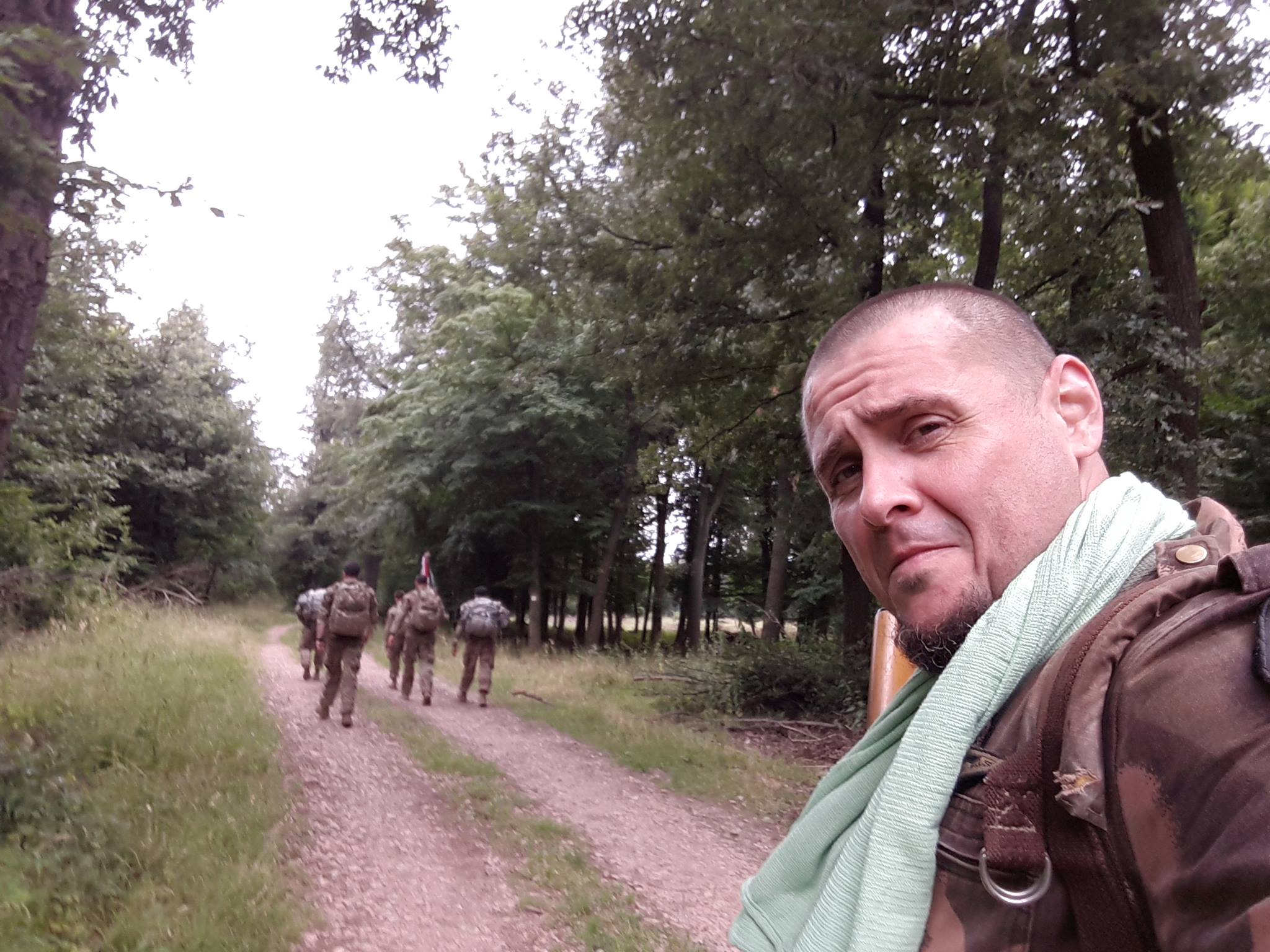 Amerikaiak előttünk!
Amerikaiak előttünk! 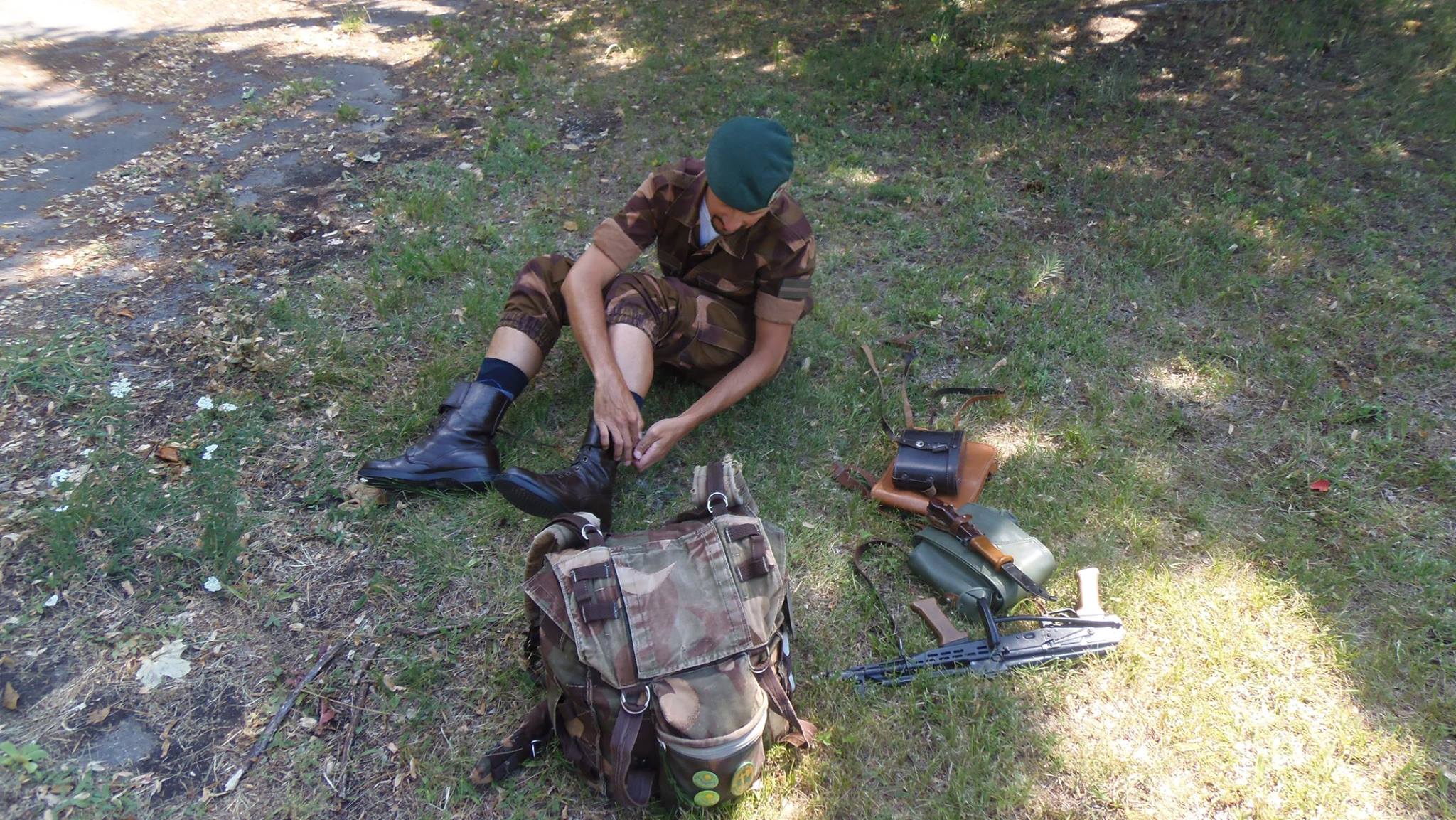 Zoknicsere
Zoknicsere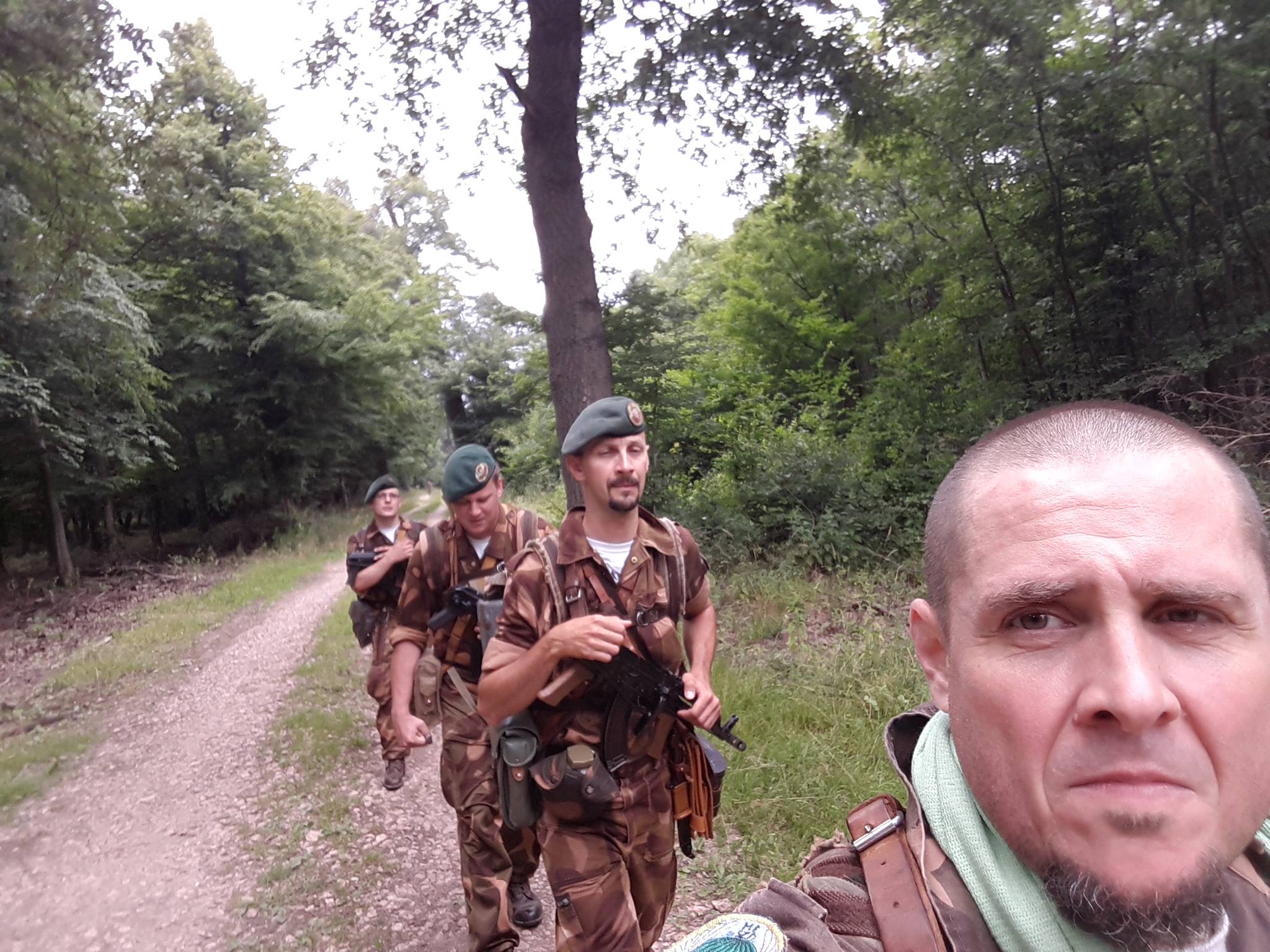 "Csak előre édes fiam!"
"Csak előre édes fiam!"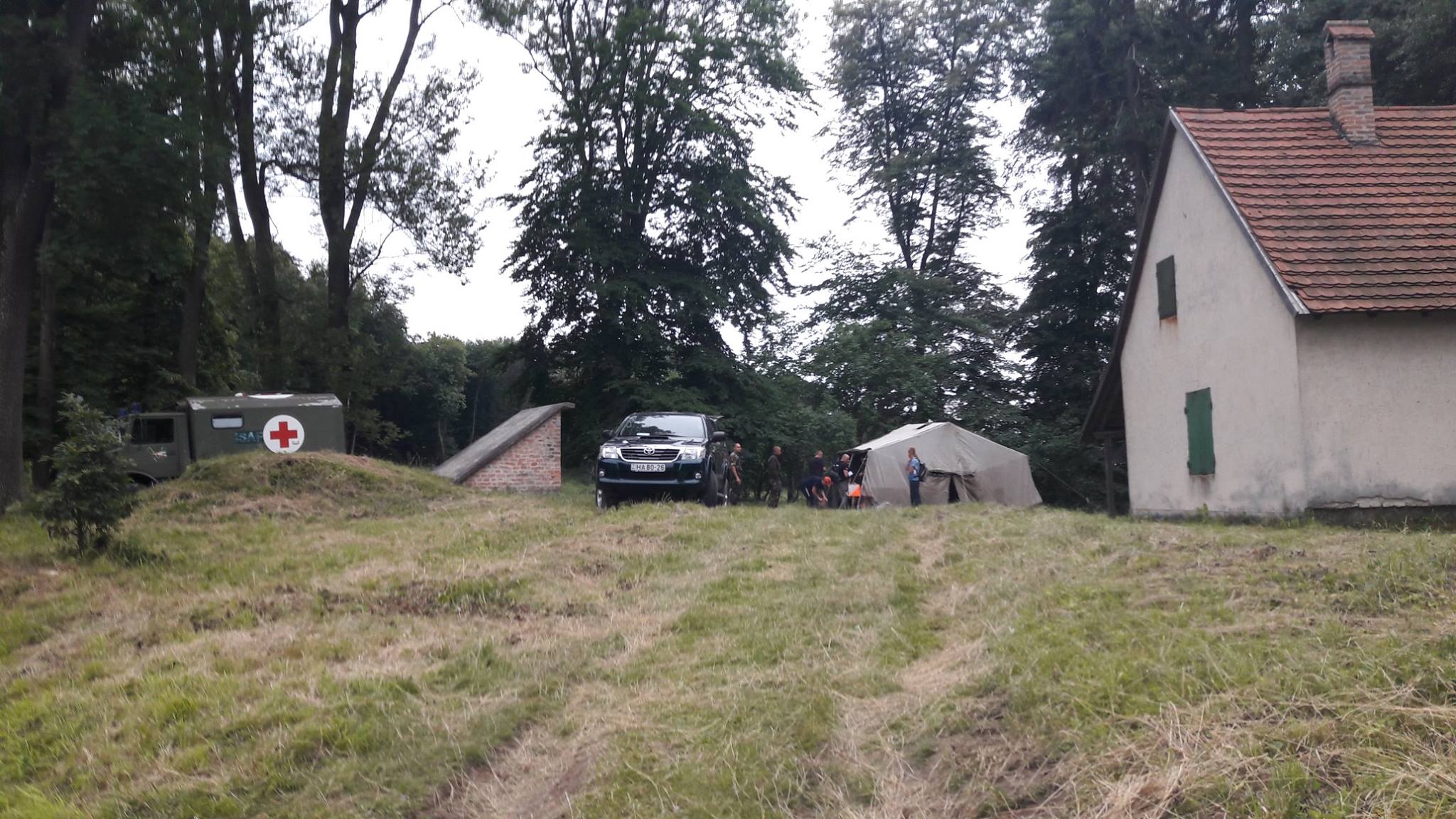 Ellenőrzőpont a vadászháznál
Ellenőrzőpont a vadászháznál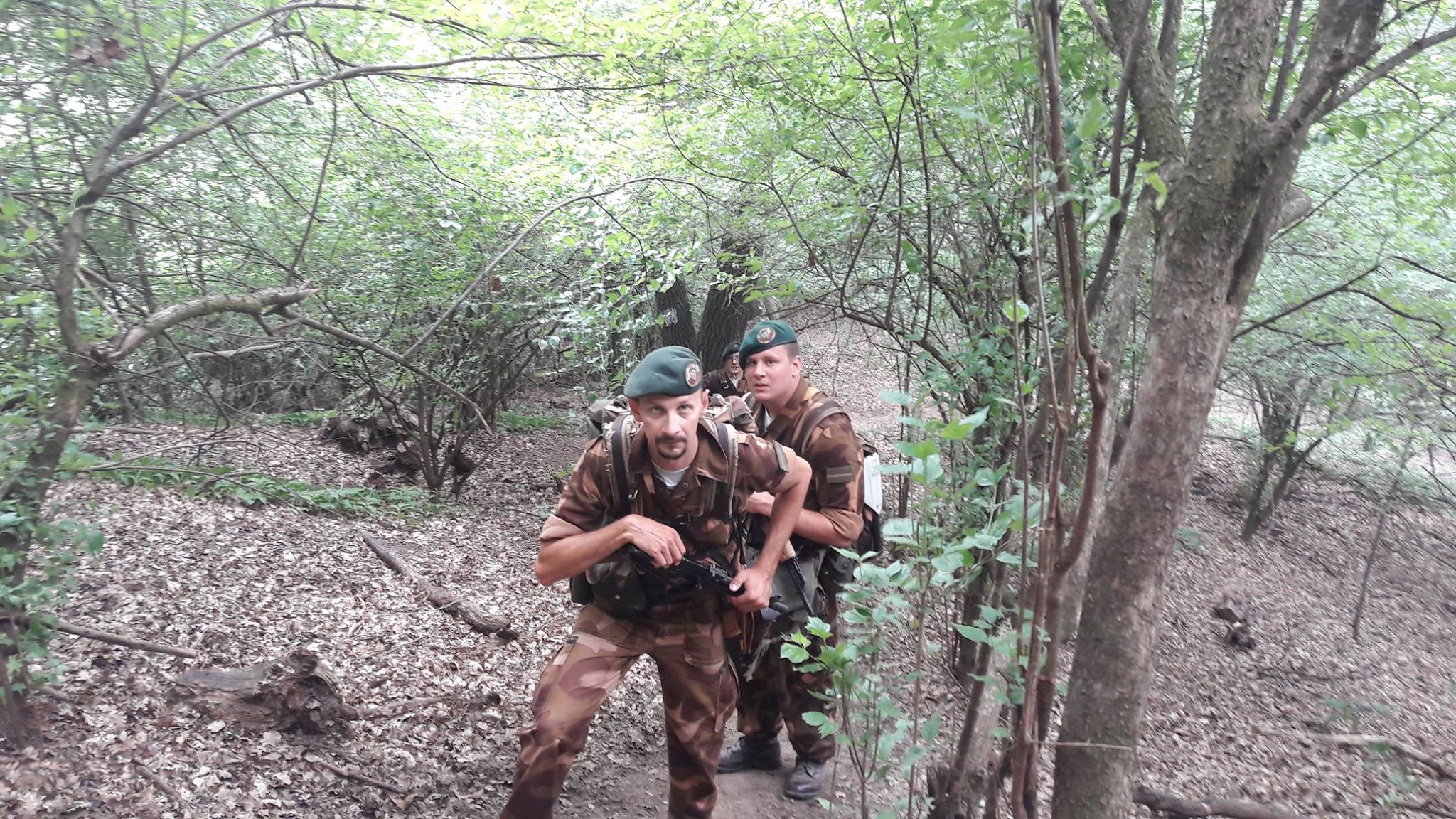 Hegymenet
Hegymenet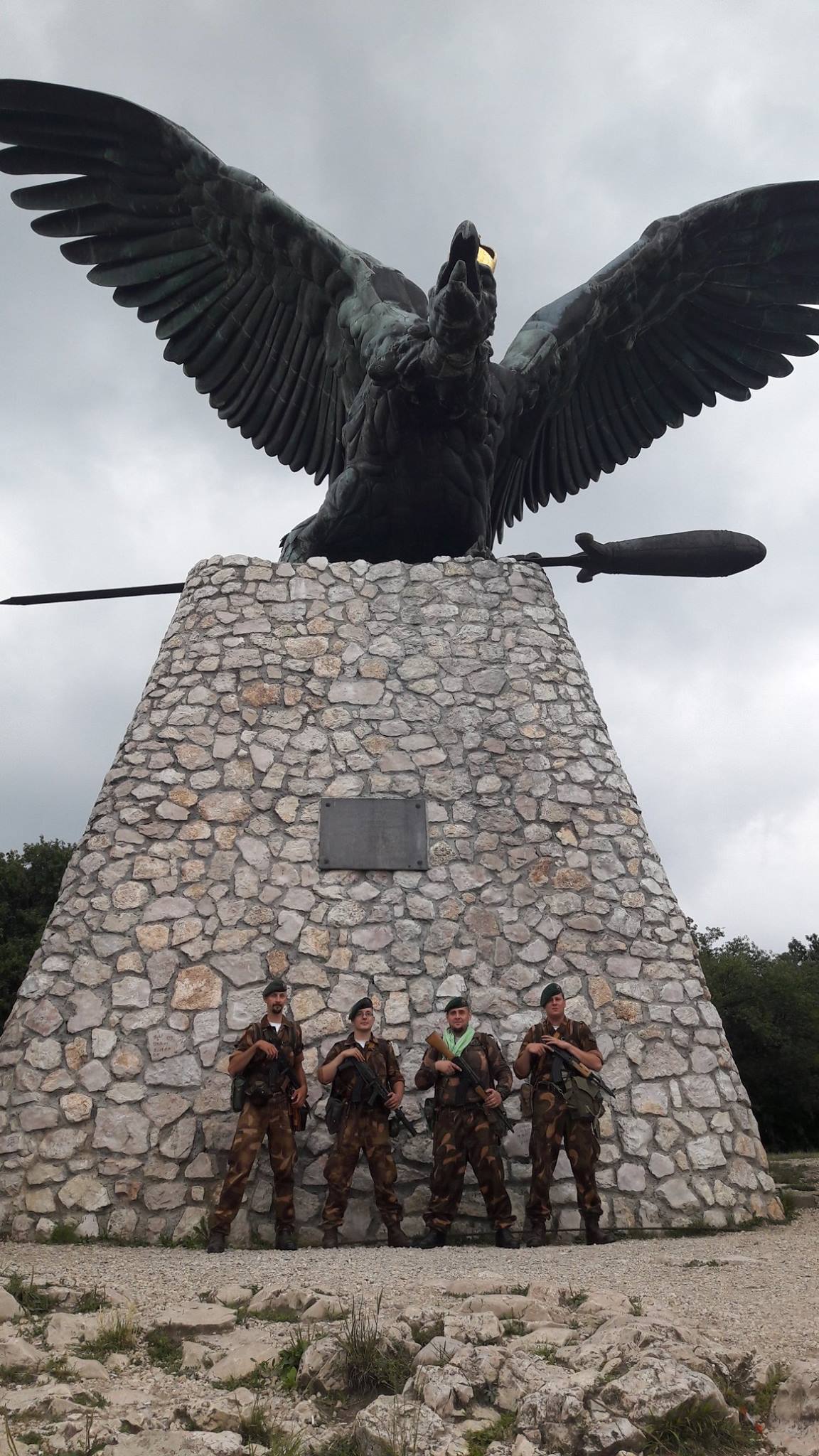 Az utolsó fénykép sötétedés előtt
Az utolsó fénykép sötétedés előtt